
Exhibit 99.1
Results for Announcement to the Market
| Appendix 4E – Preliminary Final Report Year Ended 31 March 2004 |
||||||||||
| Key Information |
Year Ended 31 March |
|||||||||
| 2004 | 2003 | |||||||||
| |
US$M |
US$M |
Movement |
|||||||
Net Sales From Ordinary Activities |
981.9 | 783.6 | up | 25 | % | |||||
Operating Profit From Continuing
Operations After Tax Attributable to
Shareholders |
125.3 | 83.5 | up | 50 | % | |||||
Operating Profit including
Discontinued Operations Attributable
to Shareholders |
129.6 | 170.5 | down | 24 | % | |||||
Net tangible assets per ordinary share |
US$0.93 | US$0.75 | up | 24 | % | |||||
Dividend Information
| • | A final dividend of US3.0 cents per share/CUFS is payable to share/CUFS holders on 1 July 2004. An interim dividend of US2.5 cents per share/CUFS was paid on 16 December 2003. | |||
| • | Record Date 10 June 2004 is used to determine entitlements to final dividend to share/CUFS holders (ie. On the basis of proper instruments of transfer received by the Company’s registrar, Computershare Investor Services Pty Ltd, Level 3, 60 Carrington Street, Sydney NSW 2000, Australia, by 5.00pm if securities are not CHESS approved, or security holding balances established by 5.00pm or such later time permitted by SCH Business Rules if securities are CHESS approved). | |||
| • | This dividend and future dividends will be unfranked for Australian taxation purposes. | |||
| • | This dividend is subject to Dutch withholding tax of 25%. Many Australian resident holders may reduce the withholding tax rate to 15% deduction if they are eligible and have completed and lodged a current special Form A before dividend record date with the Company’s registrar, Computershare Investor Services Pty Ltd, Level 3, 60 Carrington Street, Sydney NSW 2000, Australia. Holders with 25% withholding tax may be eligible to reclaim a portion of the tax after payment date. For withholding tax information see: www.jameshardie.com (select Investor Relations, then Shareholder services then Tax Information) or contact Computershare. | |||
| • | The Australian currency equivalent amount of dividend to be paid to CUFS holders will be announced to the ASX on 11 June 2004. | |||
| • | No dividend reinvestment plans are available for this dividend. | |||
Audit
The results and financial information included within this Preliminary Final Report have been prepared using USGAAP and have been subject to an independent audit by external auditors.
Results for the 4th Quarter and Full Year ended 31 March 2004
Contents
| 1. | Media Release | ||
| 2. | Results At A Glance | ||
| 3. | Management’s Discussion and Analysis for 4th Quarter and Full Year | ||
| 4. | Management Presentation | ||
| 5. | Financial Report |
Incorporated in The Netherlands with corporate seat in Amsterdam. The liability of members is limited.
13 May 2004
|
Analyst and Media enquiries, please contact Greg Baxter on Tel: 61 2 8274 5377
Mob: 0419 461 368 or Steve Ashe on Tel: 61 2 8274 5246 Mob: 0408 164 011 |
4th Qtr Operating Profit Up 35% to US$31.3 million
James Hardie today announced a 35% increase in operating profit from continuing operations to US$31.3 million for the three months ended 31 March 2004. Operating profit from continuing operations for the full year was up 50% to US$125.3 million.
Among the 4th quarter highlights, net sales increased 29%, gross profit was up 16% and EBIT2 increased 25% to US$34.8 million.
The USA Fibre Cement business continued to generate strong growth, lifting net sales 27% and EBIT2 14% in the quarter, and by 23% and 26% respectively for the full year.
Australia and New Zealand Fibre Cement increased net sales and EBIT2, while the Philippines Fibre Cement business delivered another positive EBIT2 in both the quarter and full year.
For the full year, total company net sales increased 25%, gross profit was up 23% and EBIT2 increased 34% to US$172.2 million.
Basic earnings per share from continuing operations increased 33% for the quarter, from US 5.1 cents to US 6.8 cents, and 50% for the full year, from US 18.3 cents to US 27.4 cents.
Net operating profit including discontinued operations was down in both the quarter and full year because the prior year number included a profit of US$84.0 million related primarily to the sale of our former Gypsum assets.
4th Quarter and Year-to-Date at a Glance – US$ Million
| Q4FY04 |
Q4FY03 |
%+/(-) |
FY04 |
FY03 |
%+/(-) |
|||||||||||||||||||
Net Sales |
251.3 | 194.3 | 29 | 981.9 | 783.6 | 25 | ||||||||||||||||||
Gross Profit |
89.7 | 77.1 | 16 | 358.9 | 290.8 | 23 | ||||||||||||||||||
EBIT2 |
34.8 | 27.9 | 25 | 172.2 | 128.8 | 34 | ||||||||||||||||||
Net Interest Expense |
(2.5 | ) | (2.1 | ) | 19 | (10.0 | ) | (19.9 | ) | (50 | ) | |||||||||||||
Other Income, net |
6.9 | 0.6 | — | 3.5 | 0.7 | — | ||||||||||||||||||
Income Tax Expense |
(7.9 | ) | (3.3 | ) | 139 | (40.4 | ) | (26.1 | ) | 55 | ||||||||||||||
Operating Profit
from continuing
operations3 |
31.3 | 23.1 | 35 | 125.3 | 83.5 | 50 | ||||||||||||||||||
Net Operating
Profit including
discontinued
operations4 |
32.0 | 54.5 | (41 | ) | 129.6 | 170.5 | (24 | ) | ||||||||||||||||
Unless otherwise stated, results are for continuing operations only and comparisons are of the 4th quarter of the current fiscal year versus the 4th quarter of the prior fiscal year.
Dividend and Capital Management
The company has announced plans today for a final dividend of US 3.0 cents a share, an increase of US 0.5 cents on last year’s dividend. The dividend will be paid on 1 July 2004 to shareholders registered on 10 June 2004.
“The increased dividend reflects our confidence in the strong growth potential of our fibre cement business,” Mr Macdonald said.
The company’s cash flows continue to exceed its capital requirements. The gearing ratio at 17% at year-end, is well below the long-term target of 40%, and interest cover at 17x is well in excess of debt covenant requirements.
As a result, the company remains committed to returning surplus capital to shareholders in the most efficient manner possible.
However, the Dutch tax authorities have recently ruled that future reductions of capital will attract a 10% withholding tax that did not apply to previous reductions of capital.
Additionally, the company believes that it would be inappropriate to proceed with a return of capital to shareholders during the current NSW Special Commission of Inquiry.
Consequently, James Hardie has deferred its decision on future capital management initiatives until later this year.
Operations Commentary
James Hardie’s CEO, Peter Macdonald said: “The fourth quarter results have capped off another very successful year and results so far this year suggest that the strong growth momentum of the previous year is continuing and that a another good year is in prospect.
“Demand for our products in North America continues to grow strongly, significantly outpacing the rate of housing construction growth.
“Top-line growth in our US business accelerated in the fourth quarter and we gained further share in our exterior and interior product categories across our established and emerging markets. Margins were slightly lower due to increased pulp costs, plant ramp ups and further investment in growth initiatives, including the recruitment of 267 additional staff, mainly in the second half.
“The outlook for housing in the US remains positive.
“Our Asia Pacific businesses in Australia, New Zealand and the Philippines continued to deliver improved performance and we are encouraged by prospects in these markets.
“We are also pleased with progress in Chile, Europe and our new roofing business in the USA,” Mr Macdonald said.
USA Fibre Cement – Strong Sales and Volume Growth
Net sales increased 27% to US$185.1 million in the 4th quarter due to a 29% increase in sales volume to 383.6 million square feet. The main drivers were continued strong growth in demand for fibre cement and a healthy residential housing sector buoyed by low interest rates, strong house prices and a strengthening US economy.
| Media Release: James Hardie — 4th Quarter and Full Year Results FY04 | 2 |
There was strong sales growth in both our emerging and established geographic markets and in our exterior and interior product categories.
Average selling prices were 2% lower for the quarter, reflecting stronger sales growth for some of our lower priced products and a higher level of volume rebates.
Despite increased 4th quarter costs, strong top line growth helped lift EBIT2 14% to US$43.2 million for the quarter. The EBIT margin2 was 23.3% for the quarter.
For the full year, net sales were up 23% to US$738.5 million and EBIT2 was 26% higher to US$195.6 million and the EBIT margin2 was 26.5%.
During the quarter, we started construction of our new 300 million square feet green-field fibre cement plant in Reno, Nevada, which will service rapidly growing demand on the west coast of the US. We also continued the ramp-up of recently upgraded capacity at the Blandon, Pennsylvania and Waxahachie, Texas plants, as well as our new proprietary pre-finishing line at the Peru, Illinois plant which is used to paint our ColorPlus™ Collection of products.
Australia and New Zealand Fibre Cement
Net sales increased 34% to US$53.1 million for the quarter due mainly to favourable currency translation. New housing activity in Australia was softer compared to the same period a year ago, but housing renovations remained strong. In New Zealand, new housing activity remained buoyant.
EBIT2 increased 30% for the full year and was up 5% in Australian dollars due to lower SG&A. The EBIT margin2 for the year was 18.1%. EBIT2 was up 97% for the quarter and 57% in Australian dollars on account of redundancy costs incurred in the same period last year. The EBIT margin2 for the quarter increased to 14.5%.
Philippines – Positive EBIT2
The Philippines business recorded another small positive EBIT2 in the quarter resulting in a full year EBIT2 of US$2.2 million as it continued to generate increased sales and reduce manufacturing costs.
Chile – First Full Year Positive EBIT2
The business recorded another quarterly positive EBIT2 and achieved its first full year positive EBIT2 since commencing commercial production in 2001.
USA Hardie® Pipe – Strong Growth and Manufacturing Efficiencies
Further strong top line growth and manufacturing performance improvements were achieved, but prices remain low and manufacturing costs are still higher than our targets, resulting in the business incurring a loss for the quarter and full year.
Europe
Our expansion into Europe continues to track in line with our expectations following the business becoming operational in the first quarter. We are growing demand and sales as distribution outlets are added in the UK and France and as we build awareness among distributors, builders and contractors.
| Media Release: James Hardie — 4th Quarter and Full Year Results FY04 | 3 |
Special Commission of Inquiry
There is currently a Special Commission of Inquiry into the establishment of the Medical Research and Compensation Foundation in NSW, Australia. The company is co-operating with the Inquiry, which is expected to report by, or after, the end of June.
Outlook
In North America, housing construction continues to be buoyed by low interest rates and strong house prices and the short term outlook remains positive with indicators of future activity including housing starts, permits and builder confidence all at high levels.
Despite expectations of higher interest rates later in the year, the fundamental drivers of housing demand continue to look positive. The US domestic economy is strengthening and demographic factors such as immigration, internal migration and household formation all suggest healthy levels of housing demand over the medium to longer term.
Our North American business is expected to generate further top-line and market share growth as it continues to penetrate its exterior and interior product categories across its established and emerging markets.
In Australia and New Zealand, the renovations and commercial segments are expected to remain buoyant over the short term, but new housing activity in Australia is expected to further soften. Increased sales and improved plant operating efficiencies are expected.
In the Philippines, stronger domestic and export demand is expected from increased construction activity, reflecting more favourable economic conditions in the region. Increased demand and more cost savings should further improve operating performance.
In Chile, the business is entering its seasonal slow down period, but construction activity is expected to be stronger during this period than a year ago. Further market penetration and share growth is expected as awareness of the business’s expanded product range among builders, distributors and contractors continues to increase.
The USA Hardie® Pipe business is continuing to grow sales as it penetrates the south-east market and is lifting production to meet growing demand. Further progress is expected to improve plant operating efficiency and lower manufacturing costs.
In Europe, further market penetration is expected as the business continues to build awareness of its products among builders, contractors and distributors.
Overall, the strong results achieved in the past year are continuing into the first quarter and prospects for good growth over the full year are encouraging. The company intends to provide earnings guidance for the full year when it reports its 1st quarter results in August.
Ends.
| Media Release: James Hardie — 4th Quarter and Full Year Results FY04 | 4 |
Media/Analysts call:
Greg Baxter
Executive Vice President
Telephone: 61 2 8274 5377
Mobile: 0419 461 368
Email: [email protected]
Or
Steve Ashe
Vice President Investor Relations
Telephone: 61 2 8274 5246
Mobile: 0408 164 011
Email: [email protected]
Facsimile: 61 2 8274 5218
The release and the accompanying MD&As and management presentation, along with the audio webcast of the presentation, are available from the Investor Relations section of the company website at www.jameshardie.com
Notes
| 1. | This media release forms part of a package of information about the company’s results. It should be read in conjunction with the other parts of this package, including Management’s Discussion and Analysis (MD&A), a Management Presentation, a Financial Report and a Results at a Glance document. | |||
| 2. | EBIT is defined as operating income. EBIT margin is defined as EBIT as a percentage of our net sales. We believe EBIT and EBIT margin to be relevant and useful information as these are the primary measures used by our management to measure the operating profit or loss of our business. EBIT is one of several metrics used by our management to measure the cash generated from our operations, excluding the operating cash requirement of our interest and income taxes. Additionally, EBIT is believed to be a primary measure and terminology used by our Australian investors. EBIT and EBIT margin should be considered in addition to, but not as a substitute for, other measures of financial performance reported in accordance with accounting principles generally accepted in the United States of America. EBIT and EBIT margin, as we have defined them, may not be comparable to similarly titled measures reported by other companies. | |||
| EBIT and EBIT margin, as used in this document, are equivalent to the US GAAP measures of operating income and operating income margin. | ||||
| 3. | Operating profit from continuing operations is equivalent to the US GAAP measure of income from continuing operations. | |||
| 4. | Net operating profit including discontinued operations is equivalent to the US GAAP measure of net income. | |||
| 5. | Gearing ratio is defined as net debt (external debt net of cash on hand) divided by the sum of net debt plus equity. | |||
Disclaimer
This media release contains forward-looking statements. Words such as “believe,’’ “anticipate,’’ “plan,’’ “expect,’’ “intend,’’ “target,’’ “estimate,’’ “project, “ “predict, “ “forecast,’’ “guideline,’’ “should,’’ “aim’’ and similar expressions are intended to identify forward-looking statements but are not the exclusive means of identifying such statements. Forward-looking statements involve inherent risks and uncertainties. We caution you that a number of important factors could cause actual results to differ materially from the plans, objectives, expectations, estimates and intentions expressed in such forward-looking statements. These factors, which are further discussed in our reports submitted to the Securities and Exchange Commission on Forms 20-F and 6-K and in our other filings, include but are not limited to: competition and product pricing in the markets in which we operate; general economic and market conditions; compliance with, and possible changes in, environmental and health and safety laws; dependence on cyclical construction markets; the supply and cost of raw materials; our reliance on a small number of product distributors; the consequences of product failures or defects; exposure to environmental, asbestos or other legal proceedings; and risks of conducting business internationally. We caution you that the foregoing list of factors is not exclusive and that other risks and uncertainties may cause actual results to differ materially from those contained in forward-looking statements. Forward-looking statements speak only as of the date they are made.
| Media Release: James Hardie — 4th Quarter and Full Year Results FY04 | 5 |
4th Quarter and Full Year – 31 March 2004
| 4th QTR FY04 |
Full Year FY04 |
|||||||||||||||||||
James Hardie |
||||||||||||||||||||
Net Sales |
Up | 29% | to | US$251.3 | Up | 25% | to | US$981.9 | ||||||||||||
EBIT2 |
Up | 25% | to | US$34.8 | Up | 34% | to | US$172.2 | ||||||||||||
Operating Profit3 |
Up | 35% | to | US$31.3 | Up | 50% | to | US$125.3 | ||||||||||||
Net Operating Profit1,4 |
Down | 41% | to | US$32.0 | Down | 24% | to | US$129.6 | ||||||||||||
EBIT Margin2 |
Down | 0.6pt | to | 13.8% | Up | 1.1pts | to | 17.5% | ||||||||||||
USA Fibre Cement |
||||||||||||||||||||
Net Sales |
Up | 27% | to | US$185.1 | Up | 23% | to | US$738.6 | ||||||||||||
EBIT2 |
Up | 14% | to | US$43.2 | Up | 26% | to | US$195.6 | ||||||||||||
EBIT Margin2,7 |
Down | 2.6pts | to | 23.3% | Up | 0.6pts | to | 26.5% | ||||||||||||
Volume |
Up | 29% | to | 383.6mmsf | Up | 19% | to | 1519.9mmsf | ||||||||||||
Asia Pacific Fibre Cement |
||||||||||||||||||||
Net Sales |
Up | 3% | to | A$77.0 | Up | 2% | to | A$316.9 | ||||||||||||
EBIT2 |
Up | 48% | to | A$10.5 | Up | 12% | to | A$54.2 | ||||||||||||
EBIT Margin2 |
Up | 4.2pts | to | 14.1% | Up | 1.4pt | to | 17.1% | ||||||||||||
Volume |
Up | 10% | to | 101.1mmsf | Up | 9% | to | 402.1mmsf | ||||||||||||
Key Ratios |
||||||||||||||||||||
Earnings Per Share (Basic) |
27.4 cents | |||||||||||||||||||
| EBIT Margin2 | 17.5% | |||||||||||||||||||
| Return on Shareholders Funds1, 5 | 27.6% | |||||||||||||||||||
| Return on Capital Employed5 | 23.4% | |||||||||||||||||||
| Gearing ratio6 | 17.0% | |||||||||||||||||||
| Net Interest Cover (EBIT2 / Net interest expense) | 17.2x | |||||||||||||||||||
All comparisons are against the 4th quarter or 12 months of the previous fiscal year. All dollar amounts are in US$ millions. Results are for continuing businesses only unless otherwise stated. Note: This document should be read in conjunction with other 4th quarter and Full Year results materials including a Media Release, a Management’s Discussion and Analysis, a Management Presentation and a Financial Report.
| 1 | Includes discontinued operations. | |
| 2 | EBIT is defined as operating income. EBIT margin is defined as EBIT as a percentage of our net sales. We believe EBIT and EBIT margin to be relevant and useful information as these are the primary measures used by our management to measure the operating profit or loss of our business. EBIT is one of several metrics used by our management to measure the cash generated from our operations, excluding the operating cash requirement of our interest and income taxes. Additionally, EBIT is believed to be a primary measure and terminology used by our Australian investors. EBIT and EBIT margin should be considered in addition to, but not as a substitute for, other measures of financial performance reported in accordance with accounting principles generally accepted in the United States of America. EBIT and EBIT margin, as we have defined them, may not be comparable to similarly titled measures reported by other companies. EBIT and EBIT margin, as used in this document, are equivalent to the USGAAP measures of operating income and operating income margin. | |
| 3 | Operating profit from continuing operations is equivalent to the US GAAP measure of income from continuing operations. | |
| 4 | Net operating profit including discontinued operations is equivalent to the US GAAP measure of net income. | |
| 5 | Annualised. | |
| 6 | Gearing ratio is defined as net debt (external debt net of cash on hand) divided by the sum of net debt plus equity Asia Pacific Fibre Cement EBIT Margin is calculated using EBIT and Net Sales in US dollars. 7 Using US$ sales and EBIT. |
13 May 2004
|
Analyst and media enquiries, please contact Greg Baxter on Tel: 61 2 8274 5377
Mobile: 0419 461 368 or Steve Ashe on Tel: 61 2 8274 5246 Mobile: 0408 164 011 |
James Hardie Industries N.V.
Results for the 4th Quarter Ended 31 March 2004
| USGAAP - US$ Millions |
Three Months Ended 31 March |
|||||||||||
| |
FY 2004 |
FY 2003 |
% Change |
|||||||||
Net Sales |
||||||||||||
USA Fibre Cement |
$ | 185.1 | $ | 146.2 | 27 | |||||||
Asia Pacific Fibre Cement |
59.0 | 44.3 | 33 | |||||||||
Other Fibre Cement |
7.2 | 3.8 | 89 | |||||||||
Total Net Sales |
251.3 | 194.3 | 29 | |||||||||
Net sales |
$ | 251.3 | $ | 194.3 | 29 | |||||||
Cost of goods sold |
(161.6 | ) | (117.2 | ) | 38 | |||||||
Gross profit |
89.7 | 77.1 | 16 | |||||||||
Selling general & administrative expenses |
(46.3 | ) | (43.7 | ) | 6 | |||||||
Research and development expenses |
(6.5 | ) | (5.5 | ) | 18 | |||||||
Other operating expenses |
(2.1 | ) | — | — | ||||||||
EBIT 2 |
34.8 | 27.9 | 25 | |||||||||
Net interest expense |
(2.5 | ) | (2.1 | ) | 19 | |||||||
Other income, net |
6.9 | 0.6 | — | |||||||||
Operating profit from continuing operations before
income taxes 3 |
39.2 | 26.4 | 48 | |||||||||
Income tax expense |
(7.9 | ) | (3.3 | ) | 139 | |||||||
Operating Profit From Continuing Operations4 |
$ | 31.3 | $ | 23.1 | 35 | |||||||
Net Operating Profit Including Discontinued
Operations 5 |
$ | 32.0 | $ | 54.5 | (41 | ) | ||||||
Effective tax rate from continuing operations |
20.2 | % | 12.5 | % | ||||||||
Volume (mmsf) |
||||||||||||
USA Fibre Cement |
383.6 | 297.9 | 29 | |||||||||
Asia Pacific Fibre Cement |
101.1 | 92.0 | 10 | |||||||||
Average net sales price per unit (per msf) |
||||||||||||
USA Fibre Cement |
US$483 | US$491 | (2 | ) | ||||||||
Asia Pacific Fibre Cement |
A$761 | A$817 | (7 | ) | ||||||||
Unless otherwise stated, results are for continuing operations only and comparisons are of the 4th quarter of the current fiscal year
versus the 4th quarter of the prior fiscal year.
Total Net Sales
Total net sales increased 29% compared to the same quarter of the previous year, from US$194.3 million to US$251.3 million.
Net sales from USA Fibre Cement increased 27% from US$146.2 million to US$185.1 million due to continued strong growth in sales volumes.
Net sales from Asia Pacific Fibre Cement increased 33% from US$44.3 million to US$59.0 million due to increased sales volumes and favourable currency exchange rate differences.
Net sales from Other Fibre Cement increased 89% from US$3.8 million to US$7.2 million as the Chilean flat sheet business, the USA-based Hardie® Pipe business and European Fibre Cement business continued to grow.
USA Fibre Cement
Net sales increased 27% from US$146.2 million to US$185.1 million due to increased sales volumes, partly offset by a lower average net selling price.
Sales volume increased 29% from 297.9 million square feet to 383.6 million square feet, due to strong growth in primary demand for fibre cement and a favourable housing construction market. This increase is primarily because of increased penetration into the North American markets but also includes the benefit of increased housing starts in the third quarter of this fiscal year compared to the same period in the prior year.
New residential construction and repair and remodel activity remained at healthy levels buoyed by low interest rates, strong house prices and a strengthening domestic economy.
There was strong sales growth in both our emerging and established geographic markets and in our exterior and interior product markets.
We continued to increase our penetration of the exterior products market taking share from alternative materials, primarily wood-based and vinyl siding. There was good growth in sales of higher-priced, differentiated products such as vented soffits, Heritage® panels, the ColorPlus™ Collection of pre-painted siding and Harditrim® XLD™ planks.
In the interior products market, sales of our Hardibacker 500® half-inch backerboard again grew strongly as it further penetrated its target market.
The average net selling price decreased 2% from US$491 per thousand square feet to US$483 per thousand square feet. The decrease was primarily due to strong growth in products priced below the average selling price, such as Hardibacker® backerboard and primed Hardiplank® siding, and a higher level of volume rebates. Growth in sales of differentiated, higher-priced products such as the ColorPlus™ Collection and Harditrim® is expected to increase average net selling prices over the medium to longer-term.
During the quarter, we commenced construction of our new 300 million square feet green-field fibre cement plant at Reno, Nevada. The plant will service the rapidly growing demand in the west-coast region of the United States, and is expected to be completed by the end of 2004.
Also during the quarter, we continued the ramp-up of the recently upgraded Blandon, Pennsylvania plant acquired from Cemplank in December 2001, the 160 million square feet panel production line at our Waxahachie, Texas plant, as well as the new proprietary pre-finishing line at our Peru, Illinois plant.
| James Hardie 4th Quarter FY04 MD&A | 2 |
Asia Pacific Fibre Cement
Net sales for this segment increased 33% from US$44.3 million to US$59.0 million. Net sales increased 2% in Australian dollars. Sales volume increased 10% from 92.0 million square feet to 101.1 million square feet.
Australia and New Zealand Fibre Cement
Net sales increased 34% from US$39.5 million to US$53.1 million due mainly to favourable currency exchange rate differences. In Australian dollars, net sales increased 4% due to a small increase in sales volumes and the year-end true-up of volume rebates.
Sales volumes increased 1% from 72.6 million square feet to 73.4 million square feet due to growth in sales of Australia and New Zealand building boards and FRC Pipes, partly offset by a decline in export sales.
In Australia, new residential housing activity was softer for the quarter but the renovation and commercial segments remained strong.
In New Zealand, new residential housing activity continued to be healthy and there was strong demand for weatherboards, including our Linea® range.
The average net selling price increased 3% primarily due to the year-end true-up of volume rebates.
Philippines Fibre Cement
Net sales increased 23% from US$4.8 million to US$5.9 million. In local currency, net sales increased 29% due to a 43% increase in sales volume compared to the same quarter of the previous year, from 19.5 million square feet to 27.8 million square feet, partly offset by a lower average net selling price.
Improved market penetration in the Philippines and further development of export markets helped strengthen demand during the quarter.
The average selling price in local currency decreased 9% compared to the same quarter of the previous year due mainly to a change in sales mix between domestic and export sales.
Other Fibre Cement
Chile Fibre Cement
Net sales increased 74% compared to the same period last year as our Chilean business continued to penetrate the domestic flat sheet market. In local currency, net sales increased 44%.
Sales volume increased 62% compared to the same quarter last year due to a significant increase in domestic and export demand. In local currency, the average selling price decreased 11% primarily due to a change in sales mix between domestic and export sales.
Construction activity in Chile and neighbouring Latin American countries showed further signs of improvement during the quarter.
| James Hardie 4th Quarter FY04 MD&A | 3 |
Hardie® Pipe
Our USA Hardie® Pipe business continued to penetrate the south-east market of the United States, improve its manufacturing efficiency and make progress on regulatory approvals in key markets.
Net sales increased 70% compared to the same period last year due to a 70% increase in sales volume. The product mix was broadened slightly during the quarter but the businesses main focus continued to be the 12” to 36” diameter range of drainage pipes.
Further progress was achieved during the quarter in improving manufacturing performance of the plant, but operating costs are still above our targets.
The average net selling price was flat compared to the same period last year and remains well below the national average net selling price. The lower prices reflect the competitive response to our entry into the south-east market.
Europe
Since commencing operations in the first quarter of this fiscal year our European business has continued to build awareness of our products among distributors, builders and contractors and grow demand for fibre cement.
Sales volume grew significantly during the quarter, albeit off a low base, as we added more distribution outlets in both the U.K. and French markets.
Market response to our interior and exterior range of products continues to be favourable.
Artisan Roofing
In June 2003, we began trialling and commissioning our pilot roofing plant at Fontana, California. The pilot plant, which has a design capacity of 25 mmsf, was built to test our proprietary manufacturing technology and to provide product for market testing in Southern California.
Production trials and commissioning work continued during the quarter and we expect further sales of our Artisan® roofing product to be made in the first quarter of fiscal year 2005.
Gross Profit
Gross profit increased 16% from US$77.1 million to US$89.7 million due to improvements in all our major businesses. The gross profit margin decreased 4.0 percentage points to 35.7%.
USA Fibre Cement gross profit increased 13% due to higher net sales, partly offset by an increase in unit cost of sales and increased freight costs. The higher unit cost of sales resulted primarily from increased sales of higher-priced, differentiated products, higher pulp costs and the ramp-up of the new manufacturing lines at the Blandon, Pennsylvania; Waxahachie, Texas; and Peru, Illinois plants. The gross profit margin decreased 4.7 percentage points.
Asia Pacific Fibre Cement gross profit increased 31% following significant improvements from Australia and New Zealand Fibre Cement and Philippines Fibre Cement. The improved result for Australia and New Zealand was due to manufacturing efficiency improvements in New Zealand and a favourable foreign exchange difference. In the Philippines, increased sales and reduced manufacturing costs resulted in the stronger gross profit performance. The Asia Pacific Fibre Cement gross profit margin decreased 0.5 of a percentage point.
| James Hardie 4th Quarter FY04 MD&A | 4 |
Selling, General and Administrative (SG&A) Expenses
SG&A expenses increased 6% compared to the same quarter last year, from US$43.7 million to US$46.3 million. The increase in SG&A expenses was due mainly to sales and marketing expenses associated with growth initiatives in the USA, partly offset by significant reductions in SG&A in Asia Pacific Fibre Cement. However, as a percentage of sales, SG&A expenses were 4.1 percentage points lower, at 18.4%.
Research and Development Expenses
Research and development includes costs associated with “core” research projects that are aimed at benefiting all fibre cement business units. These costs are recorded in the Research and Development segment rather than being attributed to individual business units. These costs increased 17% for the quarter to US$4.2 million.
Other research and development costs associated with commercialisation projects in business units are included in the business related unit segment results. In total, these costs were 21% higher at US$2.3 million.
Other Operating Expenses
Other operating expenses of US$2.1 million for the quarter mainly reflect an increase in cost provisions for our Australia and New Zealand business.
EBIT2
EBIT increased 25% from US$27.9 million to US$34.8 million. The EBIT margin decreased 0.6 of a percentage point to 13.8%.
USA Fibre Cement EBIT increased 14% from US$37.8 million to US$43.2 million. The increase was due to strong growth in net sales, partly offset by an increase in unit cost of sales and SG&A expenses. The increase in costs for the quarter includes the impact of an additional 267 employees since the same quarter last year and higher pulp prices. The EBIT margin decreased 2.6 percentage points to 23.3%.
Asia Pacific Fibre Cement EBIT increased 89% from US$4.4 million to US$8.3 million. The EBIT margin increased 4.2 percentage points to 14.1%.
Australia and New Zealand Fibre Cement EBIT increased 97% from US$3.9 million to US$7.7 million. In Australian dollars, EBIT increased 57%. The increase in EBIT in Australian dollars was due to increased net sales and lower SG&A costs compared to the same period last year. The EBIT margin increased 4.6 percentage points to 14.5%.
Our Philippines business recorded another small positive EBIT for the quarter due to increased net sales and manufacturing cost savings.
The Chile Fibre Cement business recorded a positive EBIT for the third consecutive quarter since achieving breakeven in the first quarter of this fiscal year.
Our USA Hardie® Pipe business incurred an operating loss for the quarter due to low average net selling prices and higher than targeted production costs.
| James Hardie 4th Quarter FY04 MD&A | 5 |
Our European fibre cement business incurred an operating loss for the quarter, following its commencement earlier this fiscal year.
General corporate costs decreased by US$0.7 million from US$7.7 million to US$7.0 million. This decrease was due to a US$1.6 million gain resulting from the positive resolution of a vendor dispute and a decrease in employee bonus plan expense, partly offset by changes in a number of other corporate costs.
Net Interest Expense
Net interest expense increased by US$0.4 million from US$2.1 million to US$2.5 million. Interest expense increased by US$0.4 million primarily due to lower capitalisation of interest of $0.3 million.
Other Income, net
The net gain in other income of US$6.9 million is largely accounted for by a US$4.5 million profit achieved on the sale of New Zealand property.
Income Tax Expense
Income tax expense increased by US$4.6 million from US$3.3 million to US$7.9 million due to the increase in profit.
Operating Profit from Continuing Operations4
Income from continuing operations increased by 35% or US$8.2 million, from US$23.1 million to US$31.3 million due to stronger performance from our major businesses.
Discontinued Operations
We recorded income from discontinued operations of US$0.7 million in the current period compared to US$31.4 million during the same period in the prior year. Income from discontinued operations in the current period includes favourable outcomes on matters related to our former Gypsum business, net of expenses of other discontinued businesses. Included in Discontinued Operations in the prior period is a US$30.0 million profit for the sale of the Las Vegas Gypsum land.
End.
| James Hardie 4th Quarter FY04 MD&A | 6 |
Media/Analysts call:
Greg Baxter
Executive Vice President
Telephone: 61 2 8274 5377
Mobile: 0419 461 368
Email: [email protected]
Or
Steve Ashe
Vice President Investor Relations
Telephone: 61 2 8274 5246
Mobile: 0408 164 011
Email: [email protected]
Facsimile: 61 2 8274 5218
The MD&As and accompanying release and management presentation, along with an audio webcast of the presentation are available at www.jameshardie.com
Notes
1. This Management’s Discussion and Analysis document forms part of a package of information about the company’s results. It should be read in conjunction with the other parts of this package, including a Media Release, a Management Presentation, a Financial Report and a Results at a Glance document.
2. EBIT is defined as operating income. EBIT margin is defined as EBIT as a percentage of our net sales. We believe EBIT and EBIT margin to be relevant and useful information as these are the primary measures used by our management to measure the operating profit or loss of our business. EBIT is one of several metrics used by our management to measure the cash generated from our operations, excluding the operating cash requirement of our interest and income taxes. Additionally, EBIT is believed to be a primary measure and terminology used by our Australian investors. EBIT and EBIT margin should be considered in addition to, but not as a substitute for, other measures of financial performance reported in accordance with accounting principles generally accepted in the United States of America. EBIT and EBIT margin, as we have defined them, may not be comparable to similarly titled measures reported by other companies.
EBIT and EBIT margin, as used in this document, are equivalent to the US GAAP measures of operating income and operating income margin.
3. Operating profit from continuing operations before income taxes is equivalent to the US GAAP measure of income from continuing operations before income taxes.
4. Operating profit from continuing operations is equivalent to the US GAAP measure of income from continuing operations.
5. Net operating profit including discontinued operations is equivalent to the US GAAP measure of net income.
| James Hardie 4th Quarter FY04 MD&A | 7 |
Disclaimer
This document contains forward-looking statements. Words such as “believe,’’ “anticipate,’’ “plan,’’ “expect,’’ “intend,’’ “target,’’ “estimate,’’ “project,’’ “predict,’’ “forecast,’’ “guideline,’’ “should,’’ “aim’’ and similar expressions are intended to identify forward-looking statements but are not the exclusive means of identifying such statements. Forward-looking statements involve inherent risks and uncertainties. We caution you that a number of important factors could cause actual results to differ materially from the plans, objectives, expectations, estimates and intentions expressed in such forward-looking statements. These factors, which are further discussed in our reports submitted to the Securities and Exchange Commission on Forms 20-F and 6-K and in our other filings, include but are not limited to: competition and product pricing in the markets in which we operate; general economic and market conditions; compliance with, and possible changes in, environmental and health and safety laws; dependence on cyclical construction markets; the supply and cost of raw materials; our reliance on a small number of product distributors; the consequences of product failures or defects; exposure to environmental, asbestos or other legal proceedings; and risks of conducting business internationally. We caution you that the foregoing list of factors is not exclusive and that other risks and uncertainties may cause actual results to differ materially from those contained in forward-looking statements. Forward-looking statements speak only as of the date they are made.
| James Hardie 4th Quarter FY04 MD&A | 8 |
13 May 2004
|
Analyst and media enquiries, please contact Greg Baxter on Tel: 61 2 8274 5377
Mobile: 0419 461 368 or Steve Ashe on Tel: 61 2 8274 5246 Mobile: 0408 164 011 |
James Hardie Industries N.V.
Results for the Full Year Ended 31 March 2004
| USGAAP - US$ Millions |
Year Ended 31 March |
|||||||||||
| |
FY 2004 |
FY 2003 |
% Change |
|||||||||
Net Sales |
||||||||||||
USA Fibre Cement |
$ | 738.6 | $ | 599.7 | 23 | |||||||
Asia Pacific Fibre Cement |
219.8 | 174.3 | 26 | |||||||||
Other Fibre Cement |
23.5 | 9.6 | 145 | |||||||||
Total Net Sales |
981.9 | 783.6 | 25 | |||||||||
Net sales |
$ | 981.9 | $ | 783.6 | 25 | |||||||
Cost of goods sold |
(623.0 | ) | (492.8 | ) | 26 | |||||||
Gross profit |
358.9 | 290.8 | 23 | |||||||||
Selling general & administrative expenses |
(162.0 | ) | (144.9 | ) | 12 | |||||||
Research and development expenses |
(22.6 | ) | (18.1 | ) | 25 | |||||||
Other operating (expenses) income |
(2.1 | ) | 1.0 | — | ||||||||
EBIT 2 |
172.2 | 128.8 | 34 | |||||||||
Net interest expense |
(10.0 | ) | (19.9 | ) | (50 | ) | ||||||
Other income, net |
3.5 | 0.7 | — | |||||||||
Operating profit from continuing operations before
income taxes 3 |
165.7 | 109.6 | 51 | |||||||||
Income tax expense |
(40.4 | ) | (26.1 | ) | 55 | |||||||
Operating Profit From Continuing Operations 4 |
$ | 125.3 | $ | 83.5 | 50 | |||||||
Net Operating Profit Including Discontinued
Operations 5 |
$ | 129.6 | $ | 170.5 | (24 | ) | ||||||
Effective tax rate from continuing operations |
24.4 | % | 23.8 | % | ||||||||
Volume (mmsf) |
||||||||||||
USA Fibre Cement |
1,519.9 | 1,273.6 | 19 | |||||||||
Asia Pacific Fibre Cement |
402.1 | 368.3 | 9 | |||||||||
Average net sales price per unit (per msf) |
||||||||||||
USA Fibre Cement |
US$486 | US$471 | 3 | |||||||||
Asia Pacific Fibre Cement |
A$788 | A$843 | (7 | ) | ||||||||
Unless otherwise stated, results are for continuing operations only and comparisons are of the
current fiscal year versus the prior fiscal year.
Total Net Sales
Total net sales increased 25% compared to the previous year, from US$783.6 million to US$981.9 million.
Net sales from USA Fibre Cement increased 23% from US$599.7 million to US$738.6 million due to continued strong growth in sales volumes and higher average net selling prices.
Net sales from Asia Pacific Fibre Cement increased 26% from US$174.3 million to US$219.8 million due to increased sales volumes and favourable currency exchange rate differences.
Net sales from Other Fibre Cement increased 145% from US$9.6 million to US$23.5 million as the Chilean flat sheet business, the USA-based Hardie® Pipe business and the European Fibre Cement business continued to grow strongly.
USA Fibre Cement
Net sales increased 23% from US$599.7 million to US$738.6 million.
Sales volume increased 19% from 1,273.6 million square feet to 1,519.9 million square feet due to strong growth in primary demand for fibre cement and a favourable housing construction market.
Residential housing activity remained healthy during the year buoyed by low mortgage rates, strong house prices, low inventory levels of new homes for sale and a recovering domestic economy.
Strong growth continued in both the interior and exterior product markets and in our emerging and established markets as our products continued to take share from alternative materials, mainly wood-based and vinyl siding.
The average net selling price increased 3% compared to the previous year from US$471 per thousand square feet to US$486 per thousand square feet. This was due to an increased proportion of sales of higher-priced, differentiated products and a price increase in some regions implemented in the first quarter of this fiscal year.
In the exterior products market, there was continued strong growth in sales of higher-priced, differentiated products such as vented soffits, Heritage® panels, the ColorPlus™ Collection of pre-painted siding and Harditrim® XLD™ planks.
In the interior products market, sales of our Hardibacker 500™ half-inch backerboard grew strongly as it further penetrated its target market, helping to lift our share of the interior cement board market.
During the fourth quarter, we commenced construction of our new 300 million square feet green-field fibre cement plant at Reno, Nevada. The plant will service the rapidly growing demand in the west-coast region of the United States, and construction is expected to be completed by the end of 2004.
During the year, we completed the upgrade and began ramping-up our Blandon, Pennsylvania plant acquired from Cemplank in December 2001. The upgrade increased design capacity of
| James Hardie FY04 MD&A | 2 |
the plant from 120 mmsf to 200 mmsf. We also completed the upgrade and began ramping-up our 160 mmsf panel production line at our Waxahachie, Texas plant.
Also during the year, we commissioned and commenced ramping-up our new proprietary pre-finishing line at our Peru, Illinois plant. This is expected to significantly reduce painting costs for our ColorPlus™ Collection of exterior siding, and help accelerate our market penetration in the northern region. Also at our Peru, Illinois plant, we commenced construction of the new 160 million square feet trim line, which is expected to be completed in mid 2004.
Asia Pacific Fibre Cement
Net sales for this segment increased 26% from US$174.3 million to US$219.8 million. Net sales increased 3% in Australian dollars. Sales volume increased 9% from 368.3 million square feet to 402.1 million square feet.
Australia and New Zealand Fibre Cement
Net sales increased 25% from US$156.3 million to US$195.5 million, primarily due to favourable foreign exchange rate differences. In Australian dollars, net sales increased 1%.
The increase in net sales in local currency was due to a 1% increase in sales volume from 298.7 million square feet to 303.0 million square feet. The average net selling price was flat compared to the previous year.
In Australia, new residential housing activity slowed during the year, but was better than industry forecasts. The impact of this was partly offset by strong residential renovation and commercial activity.
FRC Pipes continued to penetrate its targeted market and increased sales volumes compared to the prior year. During the year, FRC Pipes was successful in tendering to supply storm drainage pipes for the Sydney Orbital road project. The project involves the supply of a significant volume of FRC pipes over the next year.
A new pipe standard was released by Standards Australia during the year. This will enable our fibre cement pipes to compete more effectively against steel reinforced concrete pipes.
During the year, we launched ExoTec™ Facade Panel, our new premium facade panel incorporating the next generation of fibre cement composites. The new product is designed for commercial applications.
In New Zealand, new residential housing activity remained at healthy levels and demand was strong for soffits and weatherboards, including our Linea® range of weatherboards, which uses proprietary low-density technology.
Philippines Fibre Cement
Net sales increased 34% from US$18.0 million to US$24.2 million. In local currency, net sales increased 41%. This was due to a 42% increase in sales volume compared to the prior year, from 69.7 million square feet to 99.1 million square feet, partly offset by a lower average net selling price.
| James Hardie FY04 MD&A | 3 |
The average selling price decreased 1% compared to the prior year due to a less favourable product mix between domestic and export sales.
Other Fibre Cement
Chile Fibre Cement
Our Chilean operation continued to increase its penetration of the local market in line with its targets.
Net sales increased 167% compared to the prior year due to a 103% increase in sales volume and a higher average selling price.
The level of construction activity in Chile improved during the period after being stagnant since the end of 2001.
The average selling price increased due to strong export sales and growth in sales of higher-priced, differentiated products.
Hardie® Pipe
Our USA Hardie® Pipe business continued to penetrate the south-east market of the United States and improve its manufacturing efficiency.
Net sales increased 95% compared to the prior year due to a 95% increase in sales volume. The average net selling price was flat compared to the previous year.
Market acceptance of our fibre cement pipes continued to grow strongly and we further increased our share of the market for our targeted diameter range of drainage pipes in Florida.
The manufacturing performance of the plant continued to improve during the period, reducing costs and increasing output, particularly of the larger diameter pipes. Despite this, manufacturing costs remain higher than our targets.
The competitive response to our entry into the south-east market remains intense.
Europe
Our European fibre cement business commenced operations during the year with the launch in the U.K. and France markets of our Hardibacker® range of interior products and our proprietary pre-painted siding products.
Awareness of our product range among distributors, builders and contractors is growing and sales of Hardibacker® and our pre-painted siding products are in line with our expectations.
In June 2003, we commissioned a new coating line near Southampton in England. The line is used to apply the finishing coat to siding products imported from our United States business.
| James Hardie FY04 MD&A | 4 |
Artisan Roofing
In June 2003, we commissioned our pilot roofing plant at Fontana, California. The pilot plant, which has a design capacity of 25 mmsf, was built to test our proprietary manufacturing technology and to provide product for market testing in Southern California.
Plant testing and manufacturing trials commenced during the year and the first on-site installations of the new roofing product were completed. The first commercial sales of our Artisan® roofing product were made in the second half of the current year and further sales are expected in the first quarter of fiscal year 2005. Interest in our roofing product within our targeted market is strong.
Gross Profit
Gross profit increased 23% from US$290.8 million to US$358.9 million due to improvements in all our major businesses. The gross profit margin decreased 0.5 of a percentage point to 36.6%.
USA Fibre Cement gross profit increased 24% due to higher sales volumes and a higher average net selling price, partly offset by an increase in unit cost of sales and higher freight costs. The higher unit cost of sales resulted primarily from higher pulp costs, increased sales of higher-priced differentiated products and the ramp-up of the new manufacturing lines at the Blandon, Pennsylvania; Waxahachie, Texas; and Peru, Illinois plants. The gross profit margin increased 0.2 of a percentage point.
Asia Pacific Fibre Cement gross profit increased 19% following improvements from Australia and New Zealand Fibre Cement, and Philippines Fibre Cement, which increased 16% and 70%, respectively. The improved result for Australia and New Zealand was due to a favourable foreign exchange difference. In the Philippines, increased sales and reduced manufacturing costs resulted in the stronger gross profit performance. The Asia Pacific Fibre Cement gross profit margin decreased 2.1 percentage points.
Selling, General and Administrative (SG&A) Expenses
SG&A expenses increased 12% compared to the prior year, from US$144.9 million to US$162.0 million. The increase in SG&A expenses was due mainly to sales and marketing expenses associated with growth initiatives in the USA. However, as a percentage of sales, SG&A expenses were 2.0 percentage points lower, at 16.5%.
Research and Development Expenses
Research and development includes costs associated with “core” research projects that are aimed at benefiting all fibre cement business units. These costs are recorded in the Research and Development segment rather than being attributed to individual business units. These costs increased 36% for the period to US$14.1 million.
Other research and development costs associated with commercialisation projects in business units are included in the business unit segment results. In total, these costs increased 10% to US$8.5 million.
| James Hardie FY04 MD&A | 5 |
Other Operating (Expenses) / Income
Other operating expenses of US$2.1 million in the current fiscal year mainly reflect an increase in cost provisions for our Australia and New Zealand business. In the prior year, we realised a US$1.0 million gain from the settlement of a pulp hedge contract.
EBIT2
EBIT increased 34% from US$128.8 million to US$172.2 million. The EBIT margin increased 1.1 percentage points to 17.5%.
USA Fibre Cement EBIT increased 26% from US$155.1 million to US$195.6 million. The increase was due to strong growth in net sales, partly offset by an increase in unit cost of sales, freight and SG&A expenses. The EBIT margin increased 0.6 percentage points to 26.5%.
Asia Pacific Fibre Cement EBIT increased 38% from US$27.3 million to US$37.6 million. The EBIT margin increased 1.4 of a percentage point to 17.1%.
Australia and New Zealand Fibre Cement EBIT increased 30% from US$27.2 million to US$35.4 million primarily due to favourable foreign exchange rate differences. In Australian dollars, EBIT increased 5% mainly due to lower SG&A expenses, partly offset by a temporary decrease in manufacturing performance at the Rosehill, NSW plant during the year and increased freight costs. The EBIT margin was 0.7 of a percentage point higher, at 18.1%.
Our Philippines business recorded a US$2.2 million EBIT for the year compared to a US$0.1 million EBIT for the prior year.
The Chile Fibre Cement business recorded its first full year positive EBIT since commencing commercial production in 2001.
Despite continued strong volume growth and improved manufacturing performance, our USA Hardie® Pipe business incurred an operating loss for the year due to low prices and higher than targeted unit costs.
Our European fibre cement business became operational during the year and incurred an operating loss, as expected.
General corporate costs decreased by US$2.4 million from US$29.9 million to US$27.5 million. This decrease was primarily due to a reduction in employee bonus plan expense and a US$1.6 gain from the positive resolution of a vendor dispute, partly offset by changes in a number of other corporate expenses.
Net Interest Expense
Net interest expense decreased by US$9.9 million from US$19.9 million to US$10.0 million. In the prior year, we incurred a US$9.9 million make-whole payment from the early retirement of US$60 million of long-term debt. Interest expense decreased further by US$2.7 million due to lower average borrowings. These decreases in net interest expense were partially offset by a US$2.7 million decrease in interest income due to lower average cash balances compared to the previous year.
| James Hardie FY04 MD&A | 6 |
Other Income, net
The net gain in other income of US$3.5 million was achieved after accounting for income items including a US$4.5 million profit on sale of New Zealand property. These income items were partly offset by expense items including US$3.2 million primarily due to a capital duty fee paid in conjunction with our Dutch legal structure. We incurred this to extend the scope of our international finance subsidiary to lend to global operations.
Income Tax Expense
Income tax expense increased by US$14.3 million from US$26.1 million to US$40.4 million due to the increase in profit.
Operating Profit from Continuing Operations4
Income from continuing operations increased by 50% or US$41.8 million, from US$83.5 million for the prior year to US$125.3 million this year.
Discontinued Operations
We recorded income from discontinued operations of US$4.3 million in 2004 compared to US$87.0 million in the prior year. The current year amount primarily includes a favourable outcome from matters related to our former Gypsum business and a gain on the sale of our New Zealand Building Systems business, net of other wind-up costs of Gypsum and other discontinued businesses. The previous fiscal year primarily consisted of net profit related to the sale of our Gypsum operations and Las Vegas land related to our Gypsum operations.
Liquidity and Capital Resources
We have historically met our working capital needs and capital expenditure requirements through a combination of cash flow from operations, proceeds from the divestiture of businesses, credit facilities and other borrowings, proceeds from the sale of property, plant and equipment and proceeds from the redemption of investments. Seasonal fluctuations in working capital generally have not had a significant impact on our short-term or long-term liquidity. We believe that we can meet our present working capital requirements for at least the next 12 months based on our current capital resources.
We had cash and cash equivalents of US$72.3 million as of 31 March 2004. At that date we also had credit facilities totalling US$446.0 million of which US$175.8 million was outstanding. Our credit facilities are all uncollateralised and consist of the following:
| James Hardie FY04 MD&A | 7 |
| Effective | Total | Principal | ||||||||||
| Interest Rate | Facility | Outstanding | ||||||||||
| at | at | at | ||||||||||
| 31 March | 31 March | 31 March | ||||||||||
| Description |
2004 |
2004 |
2004 |
|||||||||
| (US$ millions) | ||||||||||||
US$ notes, fixed interest, repayable annually in varying
tranches from November 2004 through November 2013 |
7.09 | % | $ | 165.0 | $ | 165.0 | ||||||
A$ revolving loan, can be drawn down in either US$ or
A$, variable interest based on US$ LIBOR or A$ bank bill
rate plus margin, can be repaid and redrawn until
maturity in November 2006 |
N/A | 152.0 | — | |||||||||
US$ stand-by loan, can be drawn down in either US$ or
A$, variable interest based on US$ LIBOR or A$ bank bill
rate plus margin until maturity in April 2005 |
N/A | 117.5 | — | |||||||||
US$ line of credit, can be drawn down in Chilean Pesos,
variable interest based on Chilean Tasa Activa Bancaria
rate plus margin until maturity in October and December
2004 |
3.24 | % | 11.5 | 10.8 | ||||||||
Total |
$ | 446.0 | $ | 175.8 | ||||||||
Cash Flow
Net operating cash inflows increased by US$97.8 million to US$162.6 million during the fiscal year compared to the prior fiscal year. Net income, after adjusting for the gain on disposal of subsidiaries and businesses and for a gain on sale of land and buildings, increased by US$35.6 million. Adjusting further for non-cash items included in net income, cash flows from operations increased additionally by US$36.7 million. Other working capital changes caused a net increase in cash of US$25.5 million.
Net investing activities produced a cash outflow of US$58.0 million during the year compared to a cash inflow of US$237.9 million for the prior year. The decrease was primarily due to proceeds from the sale of our Gypsum business and from the Las Vegas land sale, which was partially offset by a US$57.1 million payment related to the transfer of control of ABN 60 in fiscal 2003 that did not recur in fiscal 2004. In addition, we spent US$15.4 million less on capital expenditure during the year compared to the previous year.
The US$5.0 million from the sale of businesses resulted from the sale of our New Zealand Building Systems business in May 2003. The US$10.9 million from property sold resulted primarily from land and buildings of our Australia/New Zealand segment that we sold for cash in March 2004. The US$74.8 million capital expenditures in the current period resulted primarily from continued operating plant expansions and construction and new property purchases.
| James Hardie FY04 MD&A | 8 |
Net financing activities resulted in an outflow of US$87.9 million for the year compared to a US$279.4 million outflow in the prior year. The current year outflow resulted primarily from the return of capital of US$68.7 million and the dividends paid of US$22.9 million. In the prior year, the return of capital was higher by US$26.1 million. Additionally, in the prior year, we repaid US$160 million of bank debt, which did not recur in the current year. Net proceeds from borrowings decreased by US$5.0 million to US$0.5 million. The proceeds of US$3.2 million represent stock option exercises during the year.
End.
Media/Analysts call:
Greg Baxter
Executive Vice President
Telephone: 61 2 8274 5377
Mobile: 0419 461 368
Email: [email protected]
Or
Steve Ashe
Vice President Investor Relations
Telephone: 61 2 8274 5246
Mobile: 0408 164 011
Email: [email protected]
Facsimile: 61 2 8274 5218
The MD&As and accompanying release and management presentation, along with an audio webcast of the presentation, are available at the Investor Relations area of www.jameshardie.com
| James Hardie FY04 MD&A | 9 |
Notes
1. This Management’s Discussion and Analysis document forms part of a package of information about the company’s results. It should be read in conjunction with the other parts of this package, including a Media Release, a Management Presentation, a Financial Report and a Results at a Glance document.
2. EBIT is defined as operating income. EBIT margin is defined as EBIT as a percentage of our net sales. We believe EBIT and EBIT margin to be relevant and useful information as these are the primary measures used by our management to measure the operating profit or loss of our business. EBIT is one of several metrics used by our management to measure the cash generated from our operations, excluding the operating cash requirement of our interest and income taxes. Additionally, EBIT is believed to be a primary measure and terminology used by our Australian investors. EBIT and EBIT margin should be considered in addition to, but not as a substitute for, other measures of financial performance reported in accordance with accounting principles generally accepted in the United States of America. EBIT and EBIT margin, as we have defined them, may not be comparable to similarly titled measures reported by other companies.
EBIT and EBIT margin, as used in this document, are equivalent to the US GAAP measures of operating income and operating income margin.
3. Operating profit from continuing operations before income taxes is equivalent to the US GAAP measure of income from continuing operations before income taxes.
4. Operating profit from continuing operations is equivalent to the US GAAP measure of income from continuing operations.
5. Net operating profit including discontinued operations is equivalent to the US GAAP measure of net income.
Disclaimer
This document contains forward-looking statements. Words such as “believe,’’ “anticipate,’’ “plan,’’ “expect,’’ “intend,’’ “target,’’ “estimate,’’ “project,’’ “predict,’’ “forecast,’’ “guideline,’’ “should,’’ “aim’’ and similar expressions are intended to identify forward-looking statements but are not the exclusive means of identifying such statements. Forward-looking statements involve inherent risks and uncertainties. We caution you that a number of important factors could cause actual results to differ materially from the plans, objectives, expectations, estimates and intentions expressed in such forward-looking statements. These factors, which are further discussed in our reports submitted to the Securities and Exchange Commission on Forms 20-F and 6-K and in our other filings, include but are not limited to: competition and product pricing in the markets in which we operate; general economic and market conditions; compliance with, and possible changes in, environmental and health and safety laws; dependence on cyclical construction markets; the supply and cost of raw materials; our reliance on a small number of product distributors; the consequences of product failures or defects; exposure to environmental, asbestos or other legal proceedings; and risks of conducting business internationally. We caution you that the foregoing list of factors is not exclusive and that other risks and uncertainties may cause actual results to differ materially from those contained in forward-looking statements. Forward-looking statements speak only as of the date they are made.
| James Hardie FY04 MD&A | 10 |

| 4th Quarter and Full Year Results 13 May 2004 Unless otherwise stated, results are for continuing operations only and comparisons are of the 4th quarter of the current fiscal year versus the 4th quarter of the prior fiscal year. |
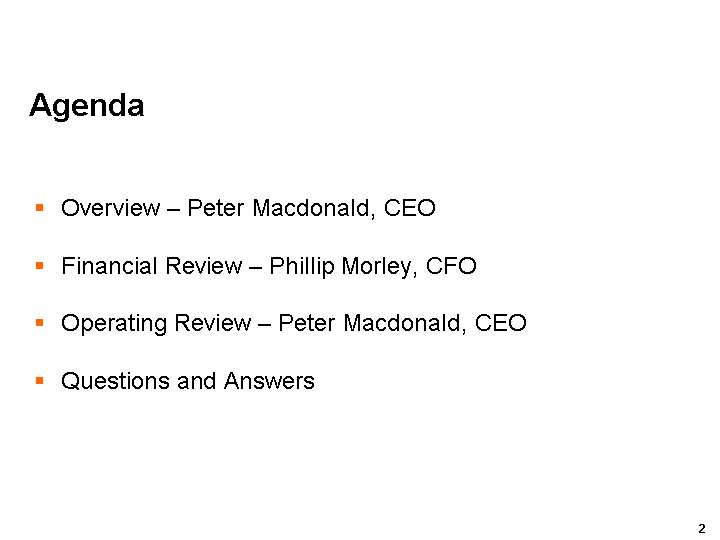
| Overview - Peter Macdonald, CEO Financial Review - Phillip Morley, CFO Operating Review - Peter Macdonald, CEO Questions and Answers Agenda |
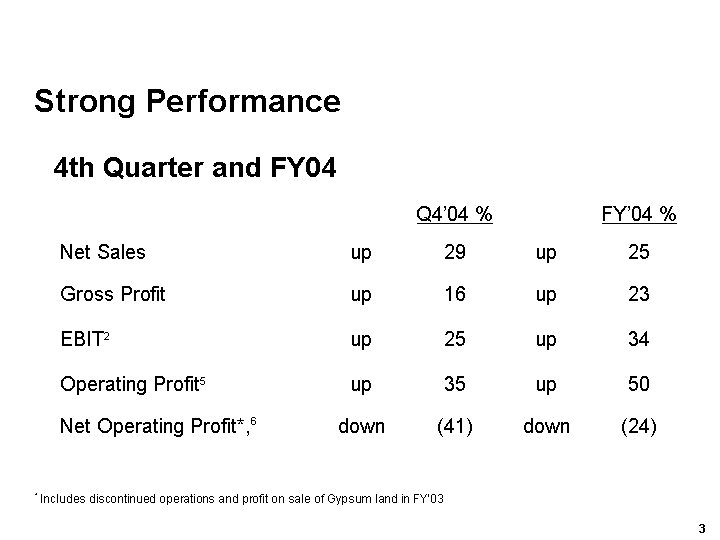
| * Includes discontinued operations and profit on sale of Gypsum land in FY'03 Strong Performance 4th Quarter and FY04 Q4'04 % FY'04 % Net Sales up 29 up 25 Gross Profit up 16 up 23 EBIT2 up 25 up 34 Operating Profit5 up 35 up 50 Net Operating Profit*,6 down (41) down (24) |
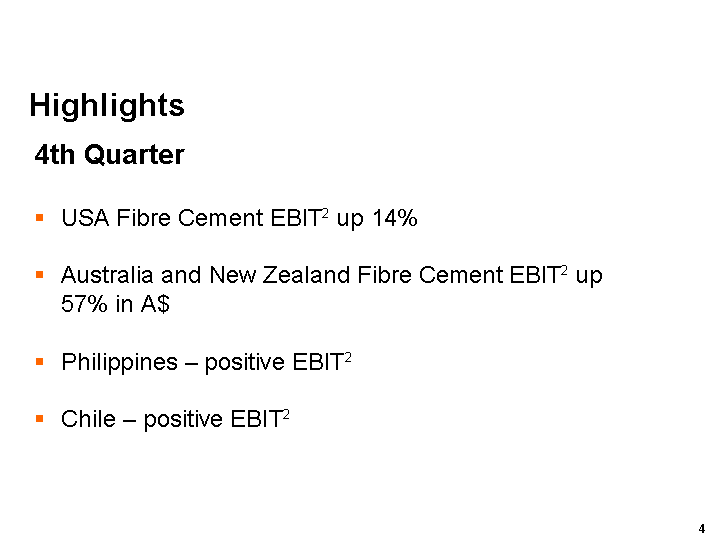
| Highlights 4th Quarter USA Fibre Cement EBIT2 up 14% Australia and New Zealand Fibre Cement EBIT2 up 57% in A$ Philippines - positive EBIT2 Chile - positive EBIT2 |
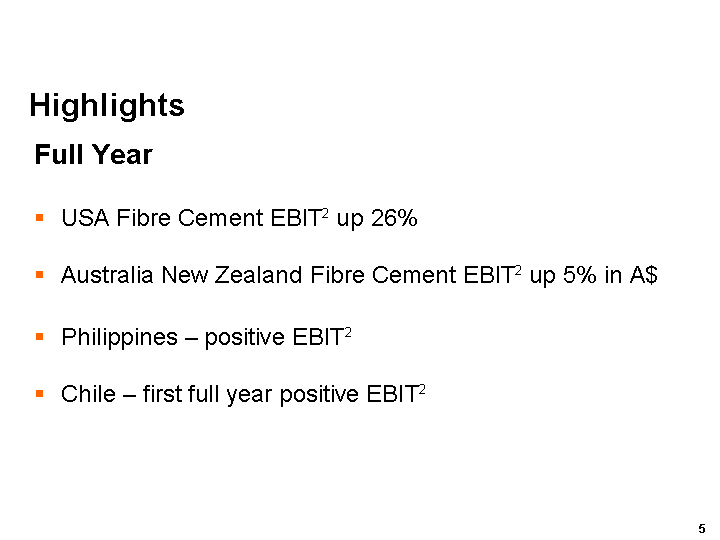
| Highlights Full Year USA Fibre Cement EBIT2 up 26% Australia New Zealand Fibre Cement EBIT2 up 5% in A$ Philippines - positive EBIT2 Chile - first full year positive EBIT2 |

| Exceeding Targets Long Term Target p.a. FY'94 Actual Revenue Growth >15% 25% EBIT2/Sales >15% 18% ROA (EBIT2/GCE) >15% 23% |
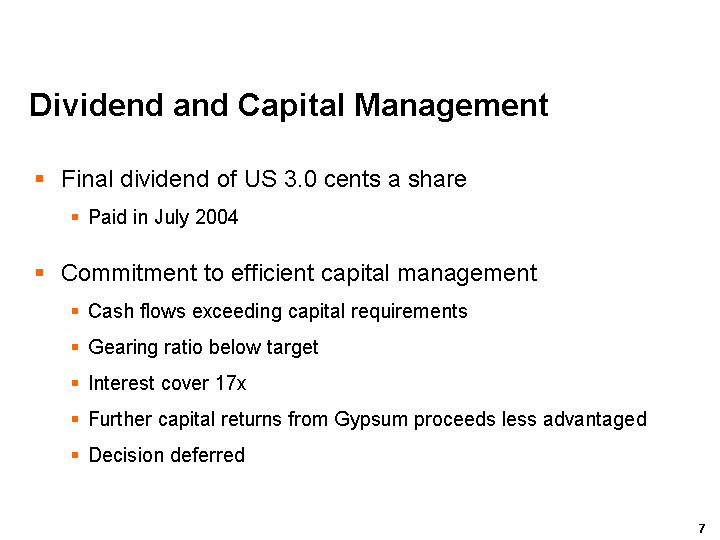
| Dividend and Capital Management Final dividend of US 3.0 cents a share Paid in July 2004 Commitment to efficient capital management Cash flows exceeding capital requirements Gearing ratio below target Interest cover 17x Further capital returns from Gypsum proceeds less advantaged Decision deferred |
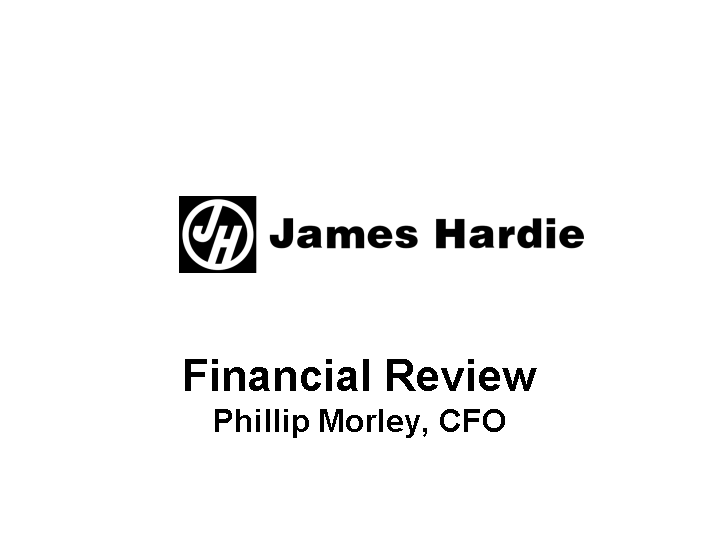
| Financial Review Phillip Morley, CFO |
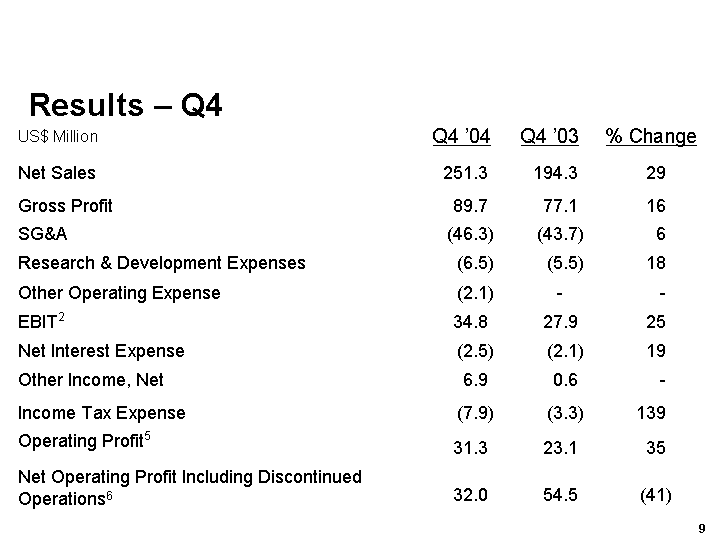
| US$ Million Q4 '04 Q4 '03 % Change Net Sales 251.3 194.3 29 Gross Profit 89.7 77.1 16 SG&A (46.3) (43.7) 6 Research & Development Expenses (6.5) (5.5) 18 Other Operating Expense (2.1) - - EBIT2 34.8 27.9 25 Net Interest Expense (2.5) (2.1) 19 Other Income, Net 6.9 0.6 - Income Tax Expense (7.9) (3.3) 139 Operating Profit5 31.3 23.1 35 Net Operating Profit Including Discontinued Operations6 32.0 54.5 (41) Results - Q4 |

| Results - Full Year US$ Million FY '04 FY '03 % Change Net Sales 981.9 783.6 25 Gross Profit 358.9 290.8 23 SG&A (162.0) (144.9) 12 Research & Development Expenses (22.6) (18.1) 25 Other Operating Expense (2.1) 1.0 - EBIT2 172.2 128.8 34 Net Interest Expense (10.0) (19.9) (50) Other Income, Net 3.5 0.7 - Income Tax Expense (40.4) (26.1) 55 Operating Profit5 125.3 83.5 50 Net Operating Profit Including Discontinued Operations6 129.6 170.5 (24) |

| Segment Net Sales - Q4 US$ Million Q4 '04 Q4 '03 % Change USA Fibre Cement 185.1 146.2 27 Asia Pacific Fibre Cement 59.0 44.3 33 Other Fibre Cement 7.2 3.8 90 Total 251.3 194.3 29 |

| Segment Net Sales - Full Year US$ Million FY '04 FY '03 % Change USA Fibre Cement 738.6 599.7 23 Asia Pacific Fibre Cement 219.8 174.3 26 Other Fibre Cement 23.5 9.6 145 Total 981.9 783.6 25 |

| Segment EBIT2 - Q4 US$ Million Q4 '04 Q4'03 % Change USA Fibre Cement 43.2 37.8 14 Asia Pacific Fibre Cement 8.3 4.4 89 Other Fibre Cement (4.1) (2.5) (64) R & D (5.6) (4.1) (37) Total Segment EBIT 41.8 35.6 17 Corporate Costs (7.0) (7.7) (9) Total EBIT 34.8 27.9 25 Note: R&D includes "core" R&D expenses and administrative expenses, but excludes product development expenses |
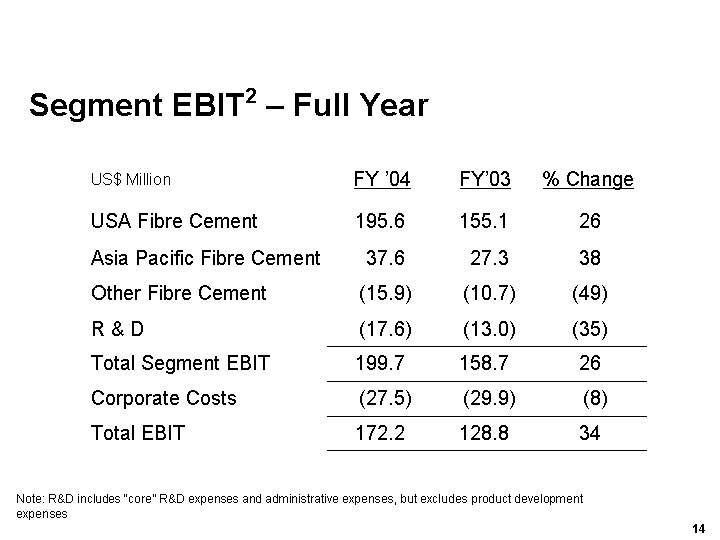
| Segment EBIT2 - Full Year US$ Million FY '04 FY'03 % Change USA Fibre Cement 195.6 155.1 26 Asia Pacific Fibre Cement 37.6 27.3 38 Other Fibre Cement (15.9) (10.7) (49) R & D (17.6) (13.0) (35) Total Segment EBIT 199.7 158.7 26 Corporate Costs (27.5) (29.9) (8) Total EBIT 172.2 128.8 34 Note: R&D includes "core" R&D expenses and administrative expenses, but excludes product development expenses |
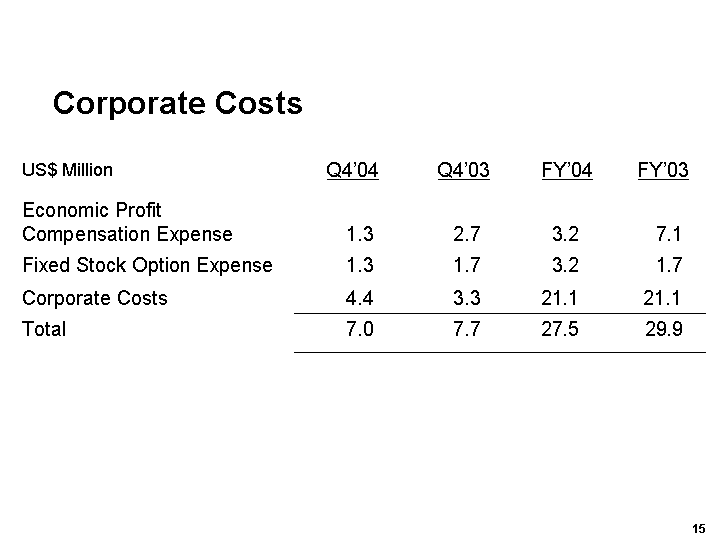
| Corporate Costs US$ Million Q4'04 Q4'03 FY'04 FY'03 Economic Profit Compensation Expense 1.3 2.7 3.2 7.1 Fixed Stock Option Expense 1.3 1.7 3.2 1.7 Corporate Costs 4.4 3.3 21.1 21.1 Total 7.0 7.7 27.5 29.9 |
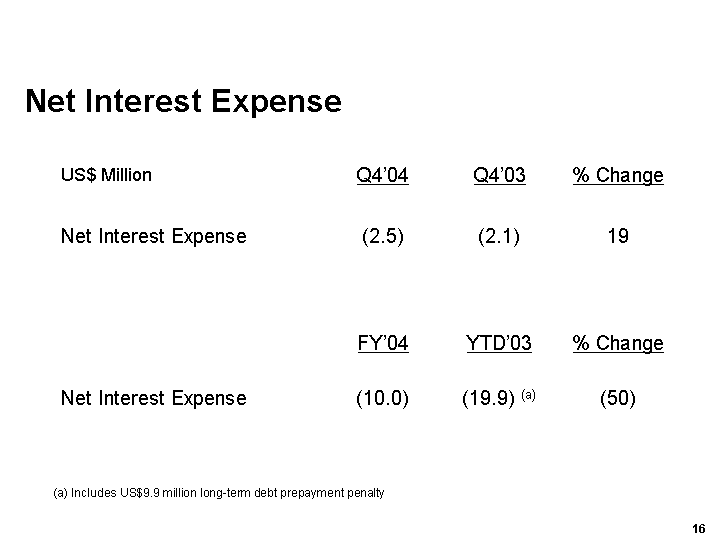
| Net Interest Expense US$ Million Q4'04 Q4'03 % Change Net Interest Expense (2.5) (2.1) 19 FY'04 YTD'03 % Change Net Interest Expense (10.0) (19.9) (a) (50) (a) Includes US$9.9 million long-term debt prepayment penalty |
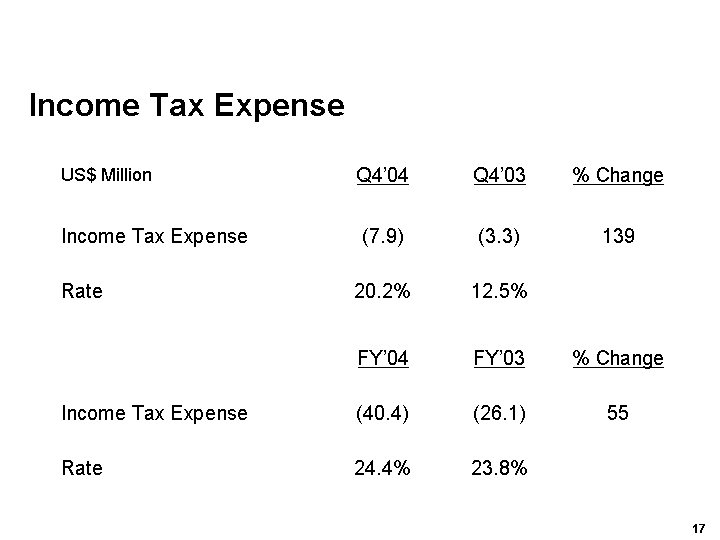
| Income Tax Expense US$ Million Q4'04 Q4'03 % Change Income Tax Expense (7.9) (3.3) 139 Rate 20.2% 12.5% FY'04 FY'03 % Change Income Tax Expense (40.4) (26.1) 55 Rate 24.4% 23.8% |
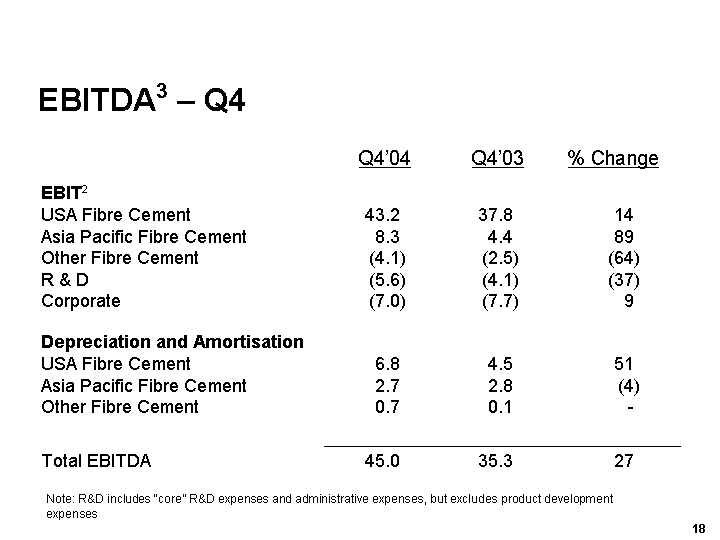
| EBITDA3 - Q4 Q4'04 Q4'03 % Change EBIT2 USA Fibre Cement Asia Pacific Fibre Cement Other Fibre Cement R & D Corporate 43.2 8.3 (4.1) (5.6) (7.0) 37.8 4.4 (2.5) (4.1) (7.7) 14 89 (64) (37) 9 Depreciation and Amortisation USA Fibre Cement Asia Pacific Fibre Cement Other Fibre Cement 6.8 2.7 0.7 4.5 2.8 0.1 51 (4) - Total EBITDA 45.0 35.3 27 Note: R&D includes "core" R&D expenses and administrative expenses, but excludes product development expenses |
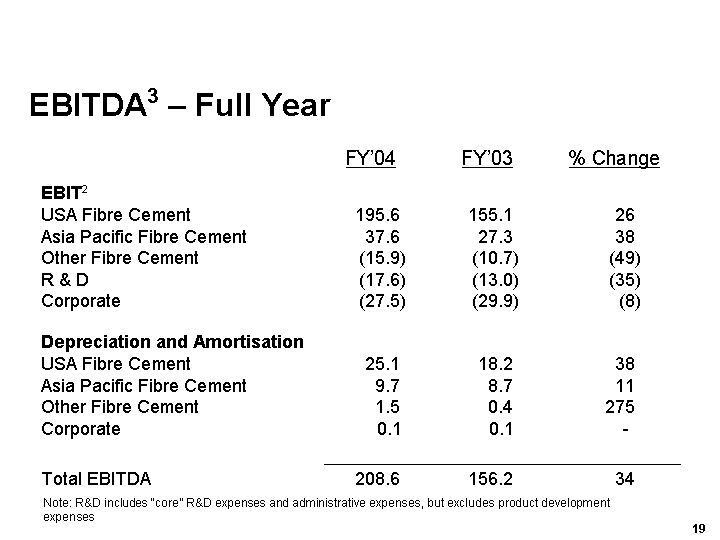
| EBITDA3 - Full Year FY'04 FY'03 % Change EBIT2 USA Fibre Cement Asia Pacific Fibre Cement Other Fibre Cement R & D Corporate 195.6 37.6 (15.9) (17.6) (27.5) 155.1 27.3 (10.7) (13.0) (29.9) 26 38 (49) (35) (8) Depreciation and Amortisation USA Fibre Cement Asia Pacific Fibre Cement Other Fibre Cement Corporate 25.1 9.7 1.5 0.1 18.2 8.7 0.4 0.1 38 11 275 - Total EBITDA 208.6 156.2 34 Note: R&D includes "core" R&D expenses and administrative expenses, but excludes product development expenses |
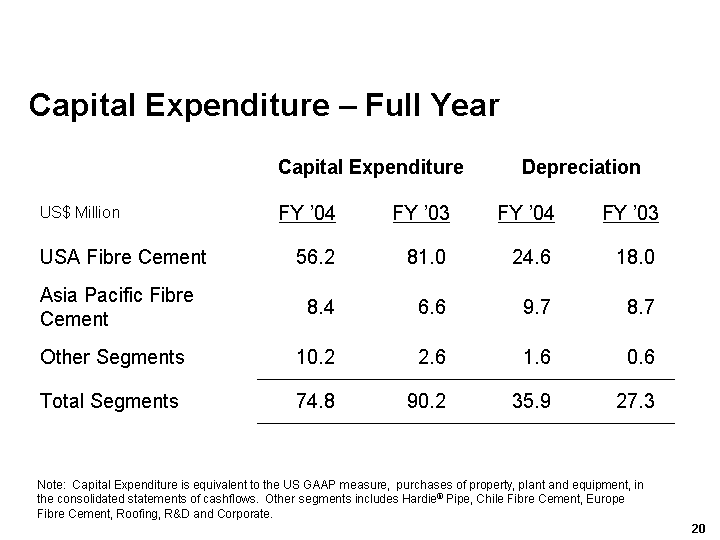
| Capital Expenditure - Full Year Capital Expenditure Capital Expenditure Depreciation Depreciation US$ Million FY '04 FY '03 FY '04 FY '03 USA Fibre Cement 56.2 81.0 24.6 18.0 Asia Pacific Fibre Cement 8.4 6.6 9.7 8.7 Other Segments 10.2 2.6 1.6 0.6 Total Segments 74.8 90.2 35.9 27.3 Note: Capital Expenditure is equivalent to the US GAAP measure, purchases of property, plant and equipment, in the consolidated statements of cashflows. Other segments includes Hardie(r) Pipe, Chile Fibre Cement, Europe Fibre Cement, Roofing, R&D and Corporate. |

| Key Ratios FY '04 FY '03 FY '02 EPS (Basic) 27.4c 18.3c 6.2c Return on Shareholders Funds* 27.6% 42.3% 8.9% Return on Capital Employed 23.4% 20.9% 8.4% EBIT2/Sales 17.5% 16.4% 7.9% Gearing* 17.0% 21.4% 44.7% Net Interest Cover 17.2x 6.5x 2.9x * Total Company ** External debt net of cash on hand |

| Operating Review Peter Macdonald, CEO |
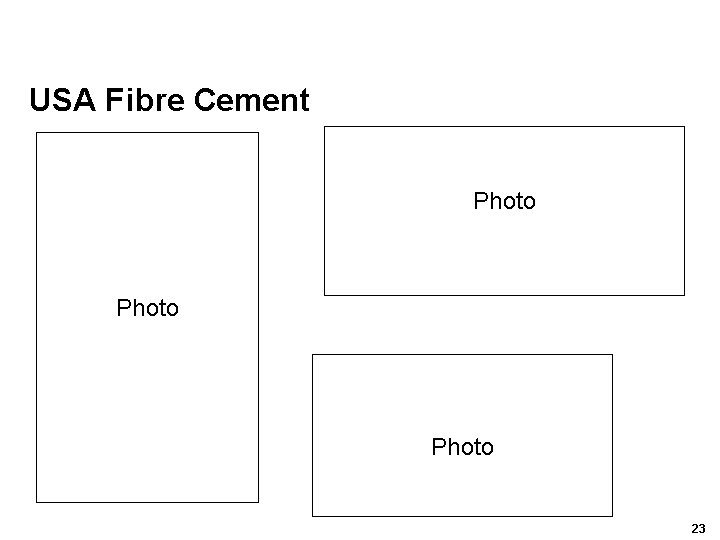
| USA Fibre Cement Photo Photo Photo |
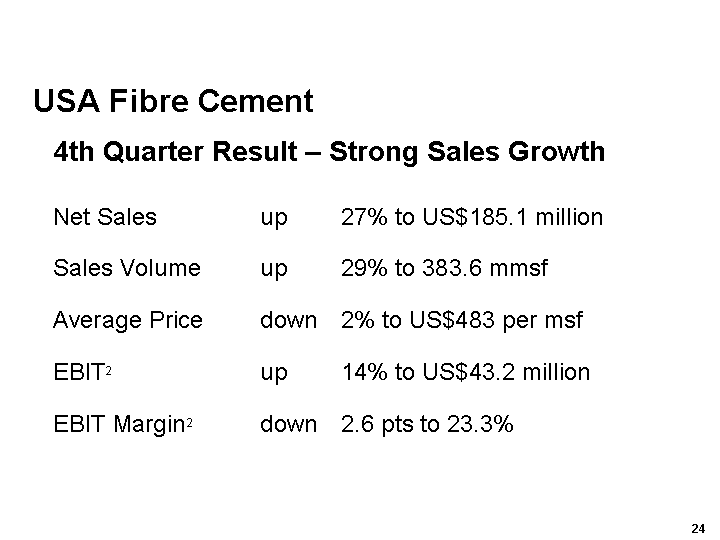
| 4th Quarter Result - Strong Sales Growth Net Sales up 27% to US$185.1 million Sales Volume up 29% to 383.6 mmsf Average Price down 2% to US$483 per msf EBIT2 up 14% to US$43.2 million EBIT Margin2 down 2.6 pts to 23.3% USA Fibre Cement |
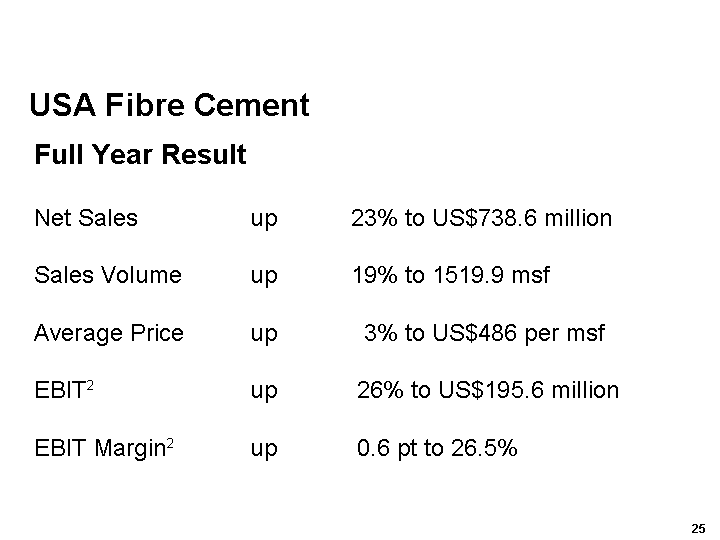
| USA Fibre Cement Full Year Result Net Sales up 23% to US$738.6 million Sales Volume up 19% to 1519.9 msf Average Price up 3% to US$486 per msf EBIT2 up 26% to US$195.6 million EBIT Margin2 up 0.6 pt to 26.5% |

| USA Fibre Cement 4th Quarter Trading Conditions Housing construction activity remained buoyant: Low interest rates Strong house prices Low inventories of houses for sale Strengthening domestic economy Consumer confidence Repair and remodel activity remained healthy |
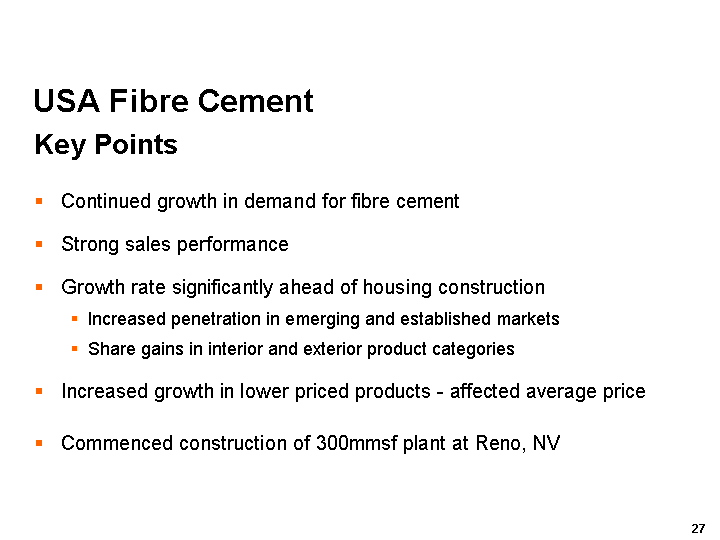
| USA Fibre Cement Key Points Continued growth in demand for fibre cement Strong sales performance Growth rate significantly ahead of housing construction Increased penetration in emerging and established markets Share gains in interior and exterior product categories Increased growth in lower priced products - affected average price Commenced construction of 300mmsf plant at Reno, NV |
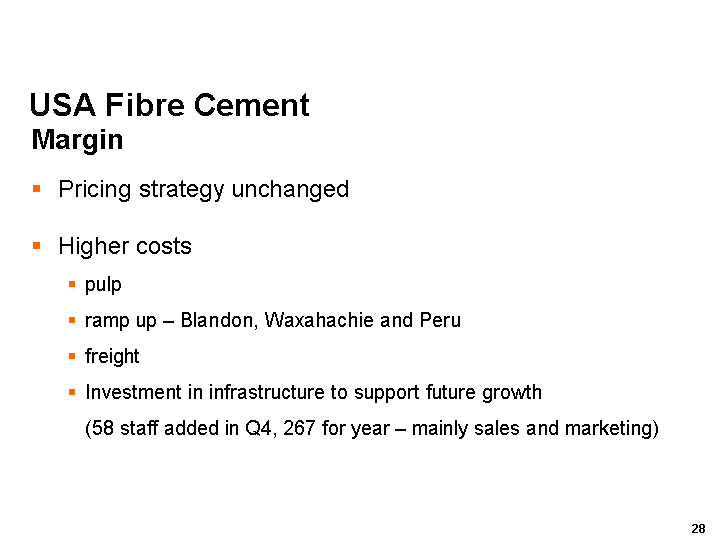
| USA Fibre Cement Margin Pricing strategy unchanged Higher costs pulp ramp up - Blandon, Waxahachie and Peru freight Investment in infrastructure to support future growth (58 staff added in Q4, 267 for year - mainly sales and marketing) |
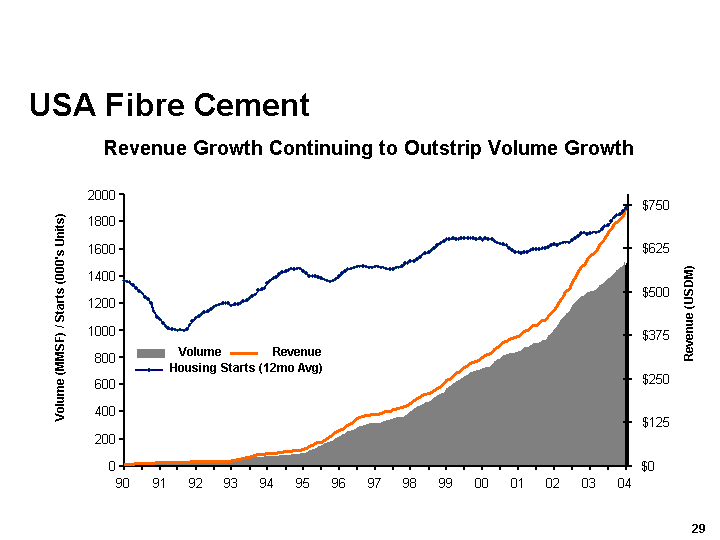
| USA Fibre Cement Revenue Growth Continuing to Outstrip Volume Growth 0 200 400 600 800 1000 1200 1400 1600 1800 2000 90 91 92 93 94 95 96 97 98 99 00 01 02 03 04 Volume (MMSF) / Starts (000's Units) $0 $125 $250 $375 $500 $625 $750 Revenue (USDM) Volume Revenue Housing Starts (12mo Avg) |
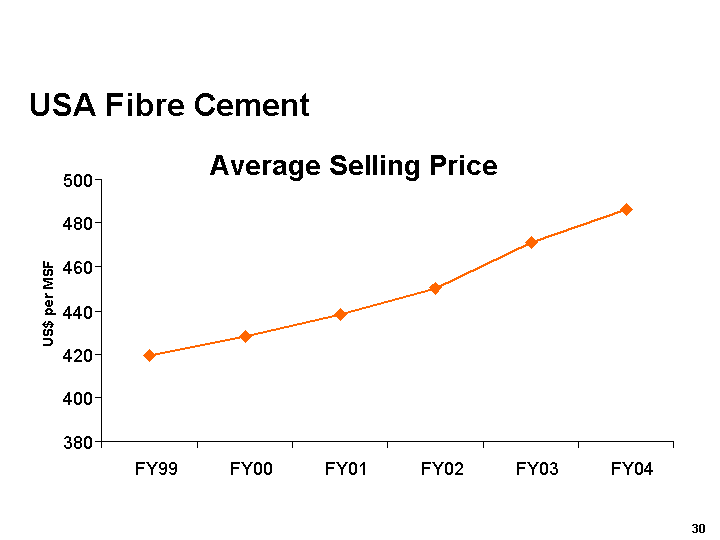
| USA Fibre Cement Average Selling Price 380 400 420 440 460 480 500 FY99 FY00 FY01 FY02 FY03 FY04 US$ per MSF |
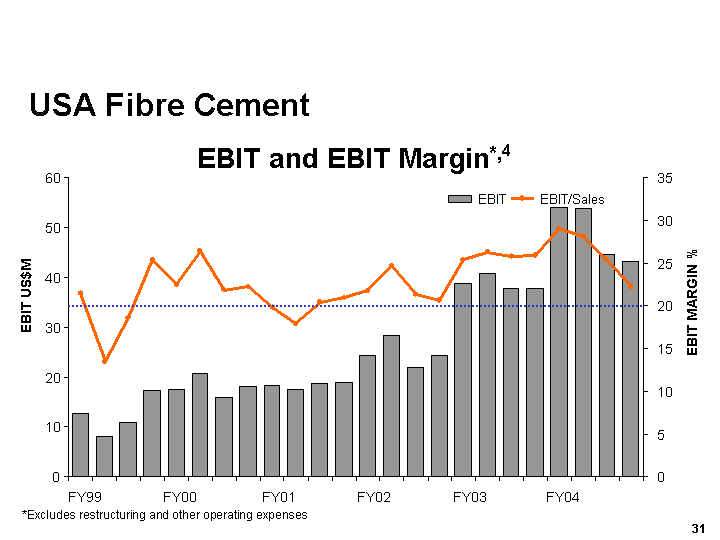
| USA Fibre Cement *Excludes restructuring and other operating expenses EBIT MARGIN % EBIT and EBIT Margin*,4 0 10 20 30 40 50 60 FY99 FY00 FY01 FY02 FY03 FY04 EBIT US$M 0 5 10 15 20 25 30 35 EBIT EBIT/Sales |

| USA Fibre Cement Strategy Aggressively grow market for fibre cement Grow our overall market position while defending our share in existing market segments Offer products with superior value to that of our competitors, introducing differentiated products to reduce direct price competition |
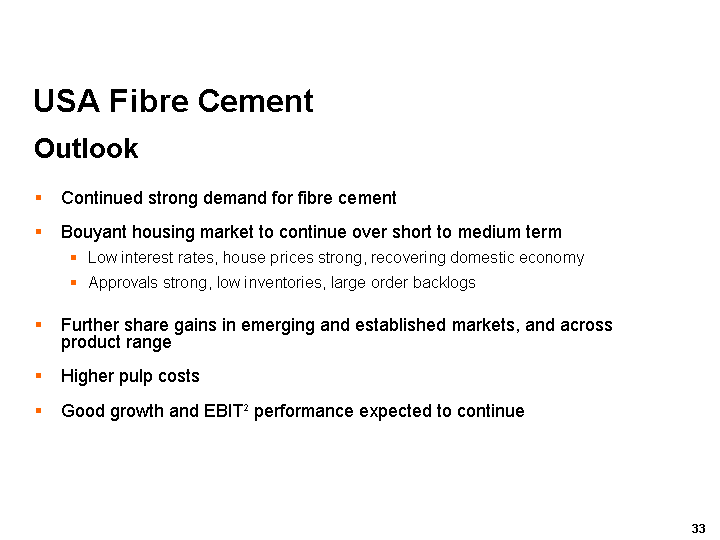
| USA Fibre Cement Outlook Continued strong demand for fibre cement Bouyant housing market to continue over short to medium term Low interest rates, house prices strong, recovering domestic economy Approvals strong, low inventories, large order backlogs Further share gains in emerging and established markets, and across product range Higher pulp costs Good growth and EBIT2 performance expected to continue |
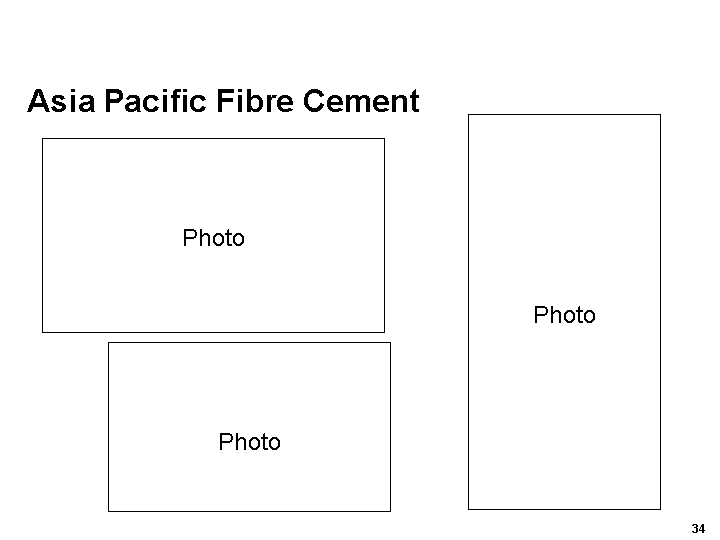
| Asia Pacific Fibre Cement Photo Photo Photo |
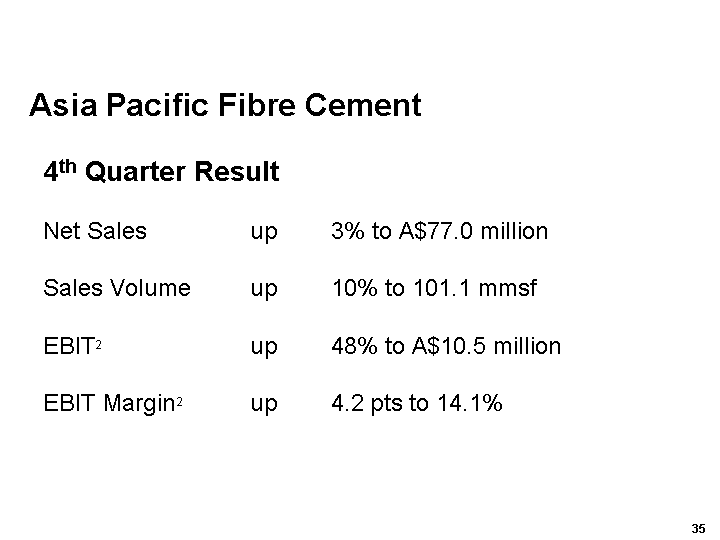
| Asia Pacific Fibre Cement 4th Quarter Result Net Sales up 3% to A$77.0 million Sales Volume up 10% to 101.1 mmsf EBIT2 up 48% to A$10.5 million EBIT Margin2 up 4.2 pts to 14.1% |
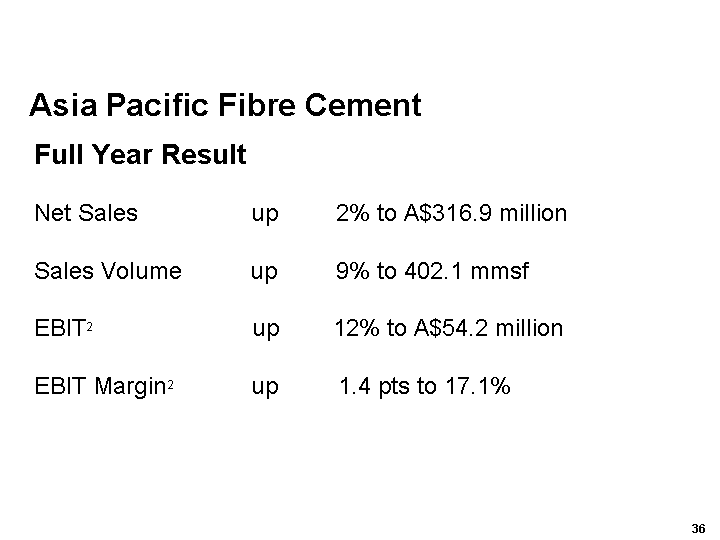
| Asia Pacific Fibre Cement Full Year Result Net Sales up 2% to A$316.9 million Sales Volume up 9% to 402.1 mmsf EBIT2 up 12% to A$54.2 million EBIT Margin2 up 1.4 pts to 17.1% |
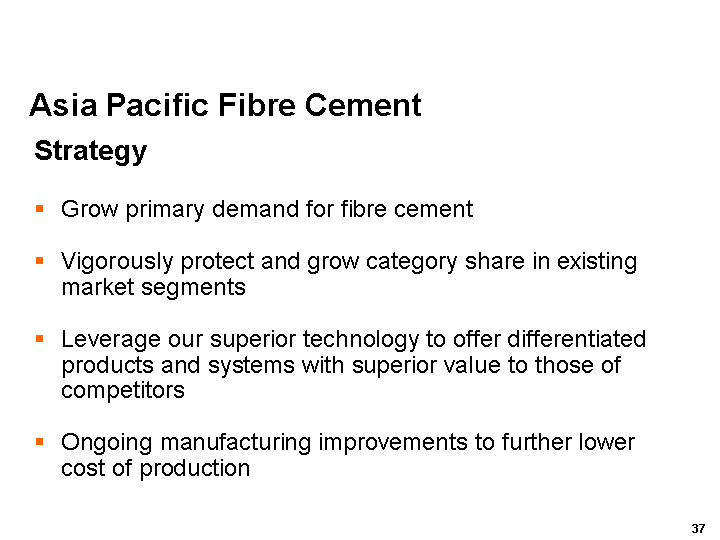
| Strategy Grow primary demand for fibre cement Vigorously protect and grow category share in existing market segments Leverage our superior technology to offer differentiated products and systems with superior value to those of competitors Ongoing manufacturing improvements to further lower cost of production Asia Pacific Fibre Cement |
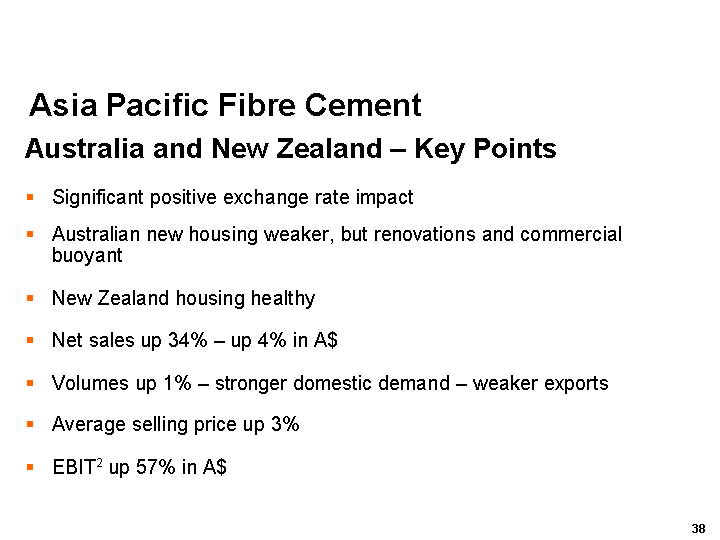
| Australia and New Zealand - Key Points Significant positive exchange rate impact Australian new housing weaker, but renovations and commercial buoyant New Zealand housing healthy Net sales up 34% - up 4% in A$ Volumes up 1% - stronger domestic demand - weaker exports Average selling price up 3% EBIT2 up 57% in A$ Asia Pacific Fibre Cement |
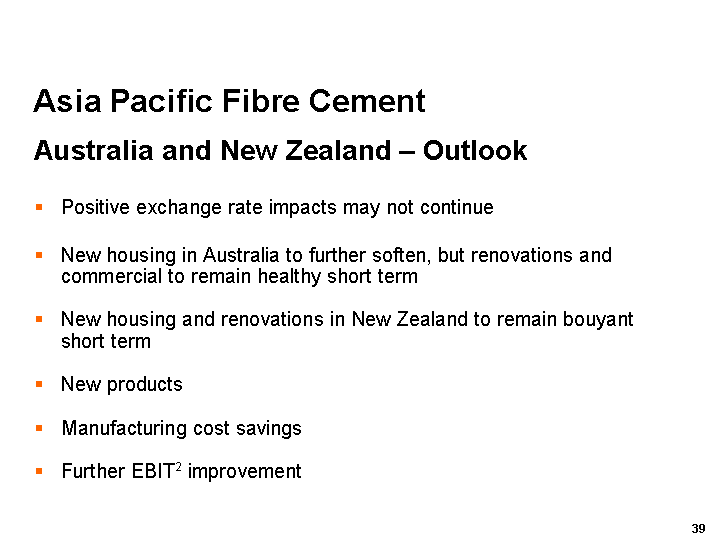
| Asia Pacific Fibre Cement Australia and New Zealand - Outlook Positive exchange rate impacts may not continue New housing in Australia to further soften, but renovations and commercial to remain healthy short term New housing and renovations in New Zealand to remain bouyant short term New products Manufacturing cost savings Further EBIT2 improvement |
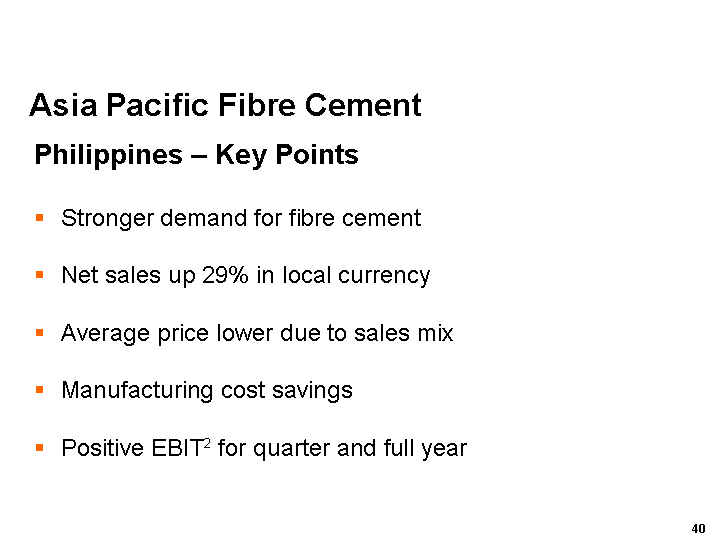
| Asia Pacific Fibre Cement Philippines - Key Points Stronger demand for fibre cement Net sales up 29% in local currency Average price lower due to sales mix Manufacturing cost savings Positive EBIT2 for quarter and full year |
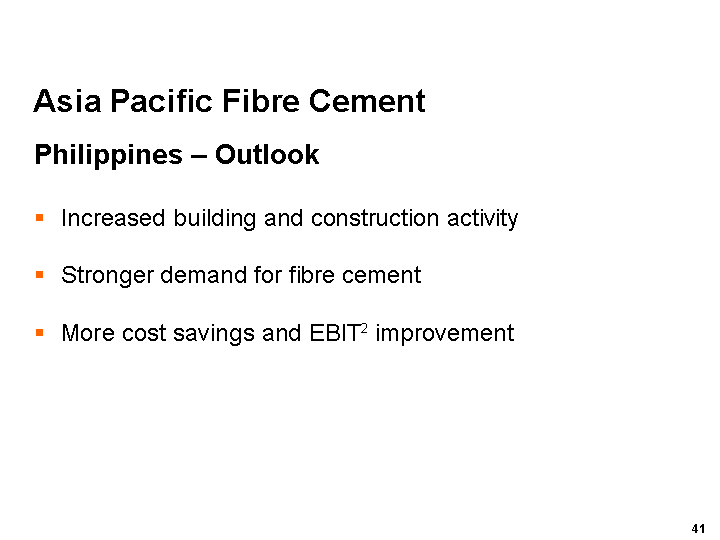
| Asia Pacific Fibre Cement Philippines - Outlook Increased building and construction activity Stronger demand for fibre cement More cost savings and EBIT2 improvement |
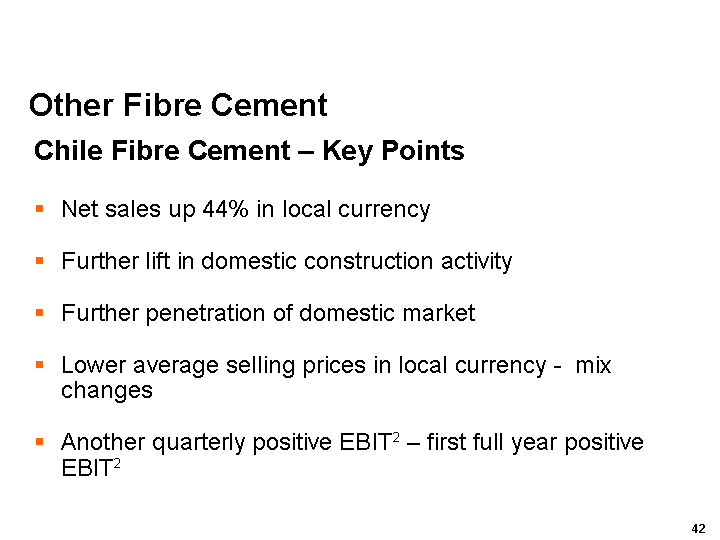
| Other Fibre Cement Chile Fibre Cement - Key Points Net sales up 44% in local currency Further lift in domestic construction activity Further penetration of domestic market Lower average selling prices in local currency - mix changes Another quarterly positive EBIT2 - first full year positive EBIT2 |
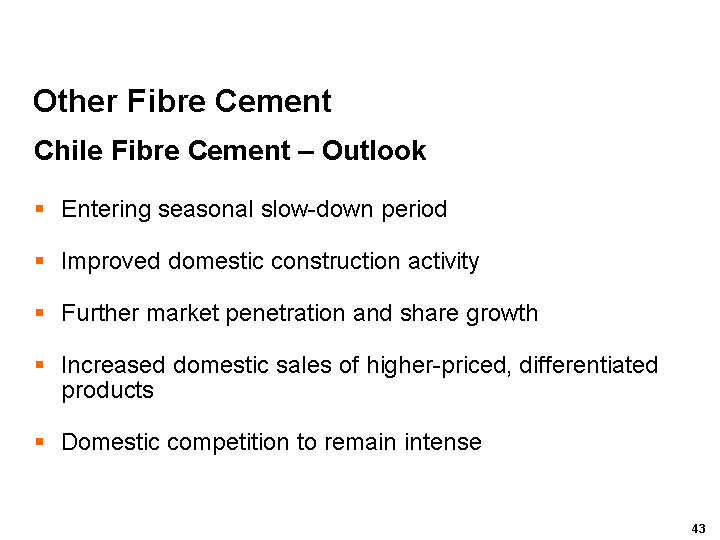
| Other Fibre Cement Chile Fibre Cement - Outlook Entering seasonal slow-down period Improved domestic construction activity Further market penetration and share growth Increased domestic sales of higher-priced, differentiated products Domestic competition to remain intense |
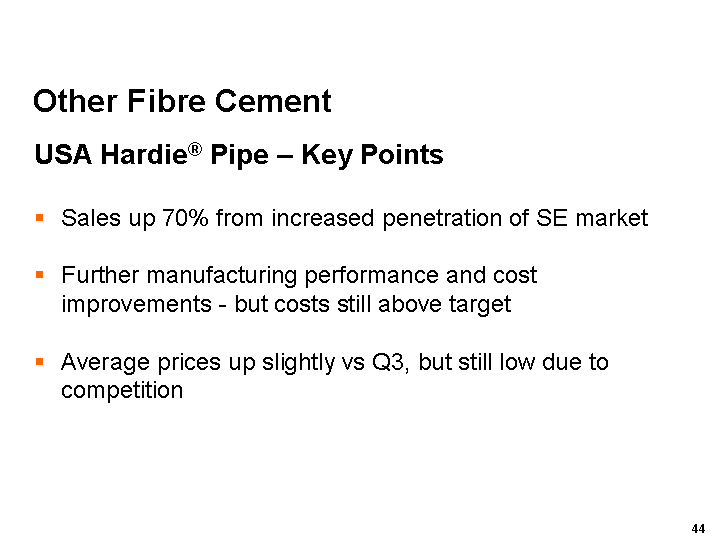
| Other Fibre Cement USA Hardie(r) Pipe - Key Points Sales up 70% from increased penetration of SE market Further manufacturing performance and cost improvements - but costs still above target Average prices up slightly vs Q3, but still low due to competition |
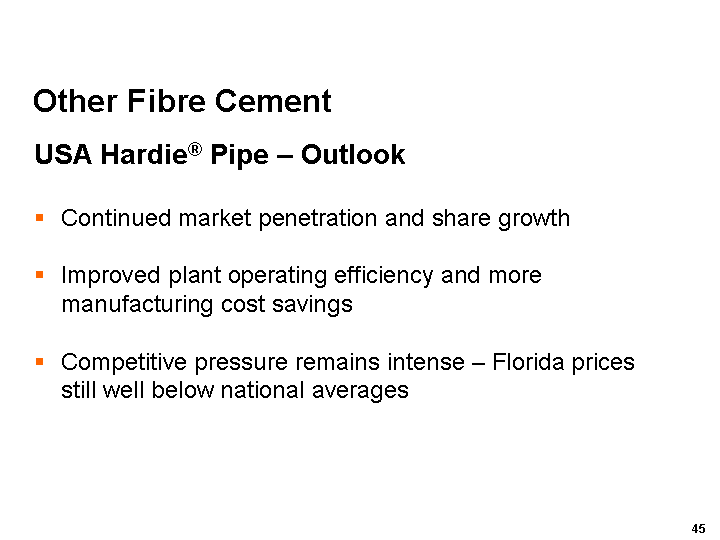
| Other Fibre Cement USA Hardie(r) Pipe - Outlook Continued market penetration and share growth Improved plant operating efficiency and more manufacturing cost savings Competitive pressure remains intense - Florida prices still well below national averages |
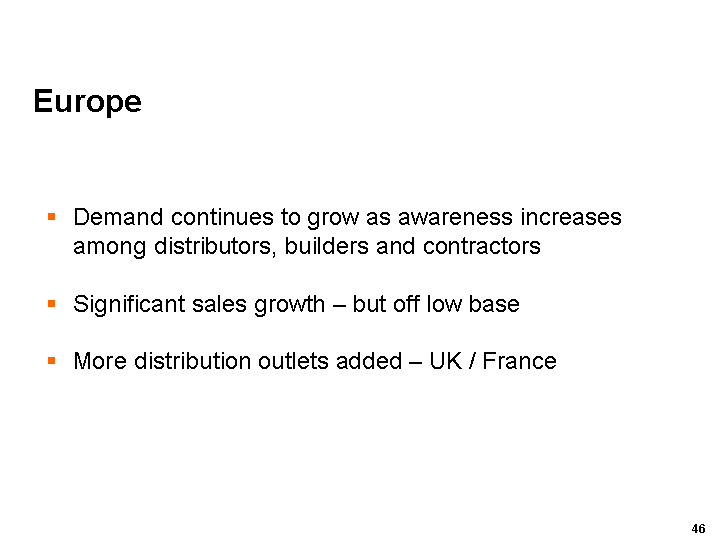
| Europe Demand continues to grow as awareness increases among distributors, builders and contractors Significant sales growth - but off low base More distribution outlets added - UK / France |
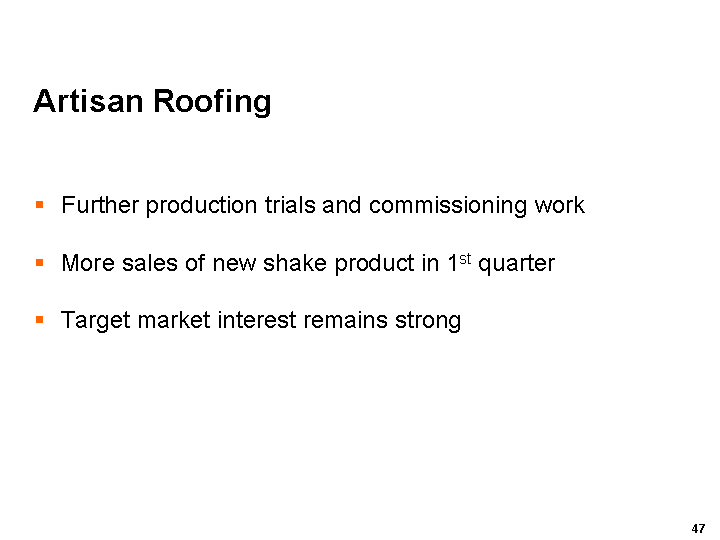
| Artisan Roofing Further production trials and commissioning work More sales of new shake product in 1st quarter Target market interest remains strong |
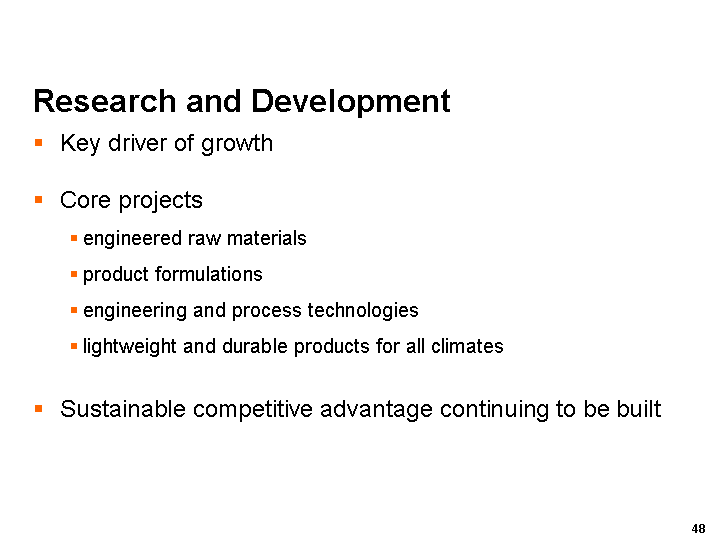
| Research and Development Key driver of growth Core projects engineered raw materials product formulations engineering and process technologies lightweight and durable products for all climates Sustainable competitive advantage continuing to be built |
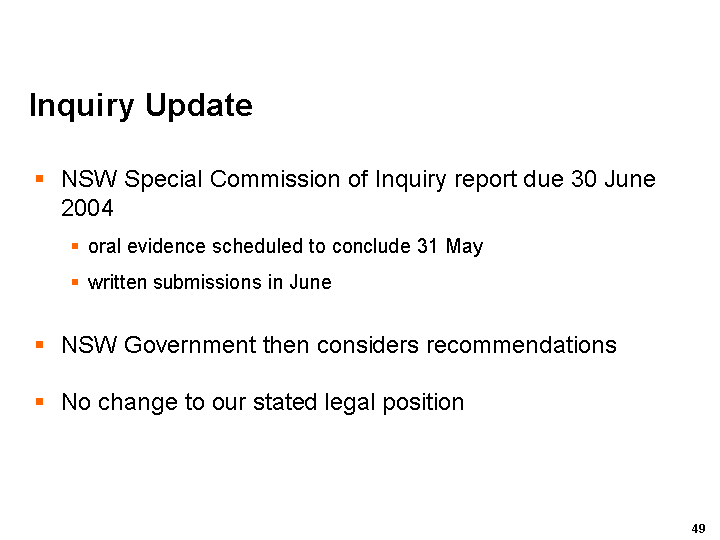
| Inquiry Update NSW Special Commission of Inquiry report due 30 June 2004 oral evidence scheduled to conclude 31 May written submissions in June NSW Government then considers recommendations No change to our stated legal position |

| Outlook Growth momentum continuing into 1st quarter Another good year is in prospect Continued strong cash flow |
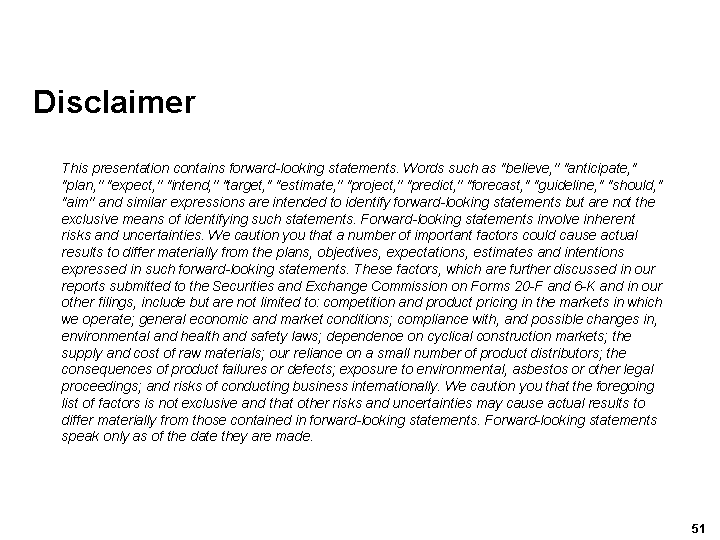
| Disclaimer This presentation contains forward-looking statements. Words such as "believe,'' "anticipate,'' "plan,'' "expect,'' "intend,'' "target,'' "estimate,'' "project,'' "predict,'' "forecast,'' "guideline,'' "should,'' "aim'' and similar expressions are intended to identify forward-looking statements but are not the exclusive means of identifying such statements. Forward-looking statements involve inherent risks and uncertainties. We caution you that a number of important factors could cause actual results to differ materially from the plans, objectives, expectations, estimates and intentions expressed in such forward-looking statements. These factors, which are further discussed in our reports submitted to the Securities and Exchange Commission on Forms 20-F and 6-K and in our other filings, include but are not limited to: competition and product pricing in the markets in which we operate; general economic and market conditions; compliance with, and possible changes in, environmental and health and safety laws; dependence on cyclical construction markets; the supply and cost of raw materials; our reliance on a small number of product distributors; the consequences of product failures or defects; exposure to environmental, asbestos or other legal proceedings; and risks of conducting business internationally. We caution you that the foregoing list of factors is not exclusive and that other risks and uncertainties may cause actual results to differ materially from those contained in forward-looking statements. Forward-looking statements speak only as of the date they are made. |
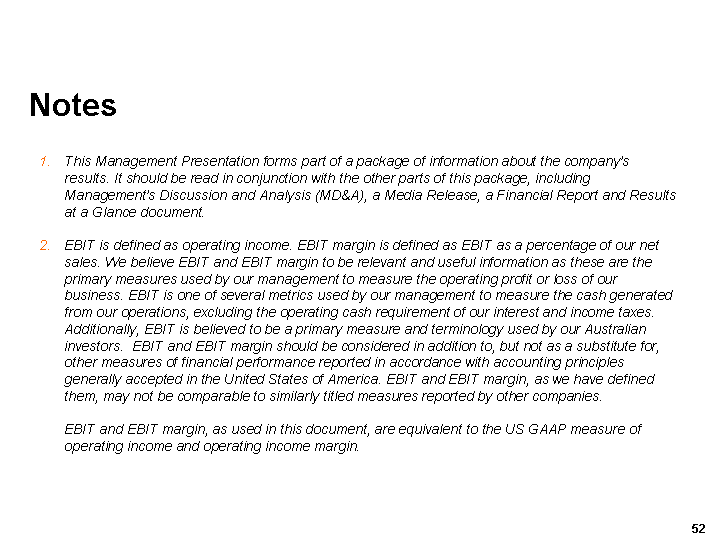
| Notes This Management Presentation forms part of a package of information about the company's results. It should be read in conjunction with the other parts of this package, including Management's Discussion and Analysis (MD&A), a Media Release, a Financial Report and Results at a Glance document. EBIT is defined as operating income. EBIT margin is defined as EBIT as a percentage of our net sales. We believe EBIT and EBIT margin to be relevant and useful information as these are the primary measures used by our management to measure the operating profit or loss of our business. EBIT is one of several metrics used by our management to measure the cash generated from our operations, excluding the operating cash requirement of our interest and income taxes. Additionally, EBIT is believed to be a primary measure and terminology used by our Australian investors. EBIT and EBIT margin should be considered in addition to, but not as a substitute for, other measures of financial performance reported in accordance with accounting principles generally accepted in the United States of America. EBIT and EBIT margin, as we have defined them, may not be comparable to similarly titled measures reported by other companies. EBIT and EBIT margin, as used in this document, are equivalent to the US GAAP measure of operating income and operating income margin. |
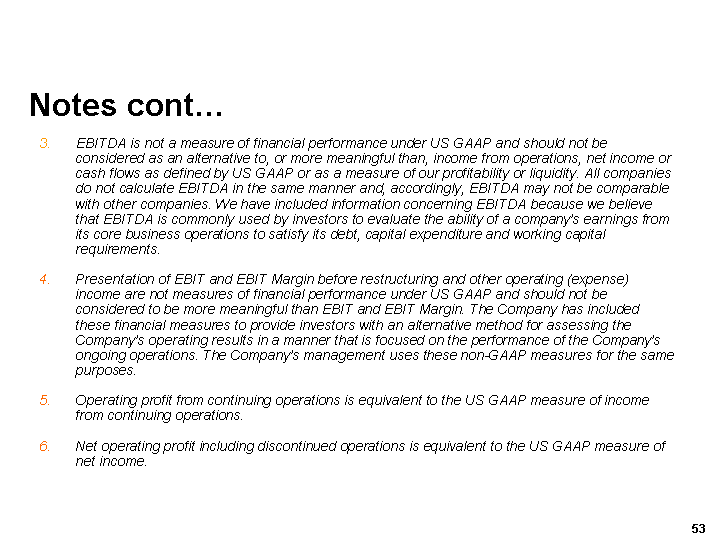
| Notes cont... 3. EBITDA is not a measure of financial performance under US GAAP and should not be considered as an alternative to, or more meaningful than, income from operations, net income or cash flows as defined by US GAAP or as a measure of our profitability or liquidity. All companies do not calculate EBITDA in the same manner and, accordingly, EBITDA may not be comparable with other companies. We have included information concerning EBITDA because we believe that EBITDA is commonly used by investors to evaluate the ability of a company's earnings from its core business operations to satisfy its debt, capital expenditure and working capital requirements. 4. Presentation of EBIT and EBIT Margin before restructuring and other operating (expense) income are not measures of financial performance under US GAAP and should not be considered to be more meaningful than EBIT and EBIT Margin. The Company has included these financial measures to provide investors with an alternative method for assessing the Company's operating results in a manner that is focused on the performance of the Company's ongoing operations. The Company's management uses these non-GAAP measures for the same purposes. Operating profit from continuing operations is equivalent to the US GAAP measure of income from continuing operations. Net operating profit including discontinued operations is equivalent to the US GAAP measure of net income. |
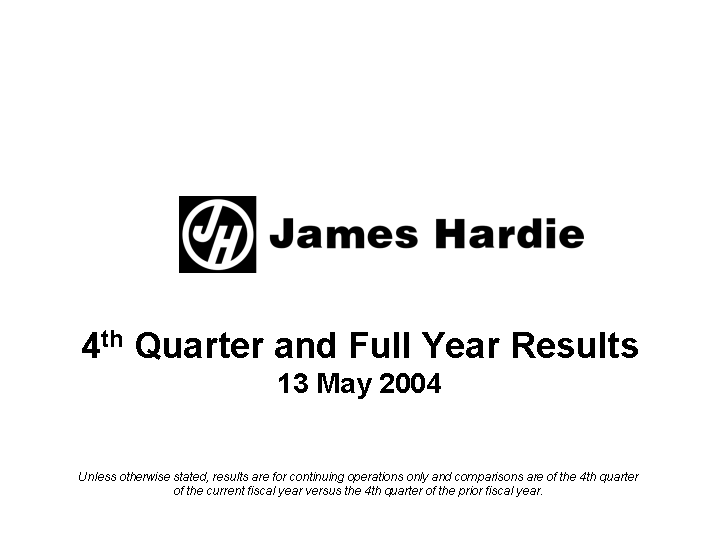
| 4th Quarter and Full Year Results 13 May 2004 Unless otherwise stated, results are for continuing operations only and comparisons are of the 4th quarter of the current fiscal year versus the 4th quarter of the prior fiscal year. |
James Hardie Industries N.V.
and
Subsidiaries
Financial Report
31 March 2004
JAMES HARDIE INDUSTRIES NV AND SUBSIDIARIES
INDEX TO FINANCIAL STATEMENTS
| Page |
||||
Consolidated Balance Sheets as of 31 March 2004 and 2003 |
F-2 | |||
Consolidated Statements of Income for the Years Ended 31 March 2004, 2003 and 2002 |
F-3 | |||
Consolidated Statements of Cash Flows for the Years Ended 31 March 2004, 2003 and 2002 |
F-5 | |||
Consolidated Statements of Changes in Shareholders’ Equity for the Years Ended
31 March 2004, 2003 and 2002 |
F-7 | |||
Notes to Consolidated Financial Statements |
F-9 | |||
Selected Quarterly Financial Data (unaudited) |
F-43 | |||
Group Statistics |
F-44 | |||
F-1
JAMES HARDIE INDUSTRIES N.V. AND SUBSIDIARIES
CONSOLIDATED BALANCE SHEETS
| (Millions of US dollars) |
(Millions of Australian dollars) |
|||||||||||||||
| 31 March | 31 March | 31 March | 31 March | |||||||||||||
| 2004 |
2003 |
2004 |
2003 |
|||||||||||||
| ASSETS | (Unaudited) | (Unaudited) | ||||||||||||||
Current assets: |
||||||||||||||||
Cash and cash equivalents |
$ | 72.3 | $ | 54.6 | A$ | 95.1 | A$ | 90.4 | ||||||||
Accounts and notes receivable, net of allowance for
doubtful accounts of $1.2 million (A$1.6 million) and
$1.0 million (A$1.7 million) as of 31 March 2004 and
31 March 2003, respectively |
118.4 | 87.8 | 155.8 | 145.4 | ||||||||||||
Inventories |
103.2 | 74.0 | 135.8 | 122.5 | ||||||||||||
Refundable income taxes |
37.8 | 44.6 | 49.7 | 73.9 | ||||||||||||
Prepaid expenses and other current assets |
8.8 | 6.6 | 11.6 | 10.9 | ||||||||||||
Deferred tax assets |
24.7 | 23.0 | 32.5 | 38.1 | ||||||||||||
Current assets — discontinued operations |
— | 5.4 | — | 8.9 | ||||||||||||
Total current assets |
365.2 | 296.0 | 480.5 | 490.1 | ||||||||||||
Long-term receivables |
6.1 | 3.7 | 8.0 | 6.1 | ||||||||||||
Investments |
3.7 | 6.0 | 4.9 | 9.9 | ||||||||||||
Property, plant and equipment, net |
567.1 | 520.0 | 746.1 | 861.1 | ||||||||||||
Intangible assets, net |
3.0 | 3.4 | 3.9 | 5.6 | ||||||||||||
Prepaid pension cost |
14.1 | — | 18.5 | — | ||||||||||||
Deferred tax assets |
12.0 | 21.4 | 15.8 | 35.4 | ||||||||||||
Non-current assets — discontinued operations |
— | 1.3 | — | 2.2 | ||||||||||||
Total assets |
$ | 971.2 | $ | 851.8 | A$ | 1,277.7 | A$ | 1,410.4 | ||||||||
LIABILITIES AND SHAREHOLDERS’ EQUITY |
||||||||||||||||
Current liabilities: |
||||||||||||||||
Accounts payable and accrued liabilities |
$ | 78.5 | $ | 74.0 | A$ | 103.3 | A$ | 122.5 | ||||||||
Current portion of long-term debt |
17.6 | — | 23.2 | — | ||||||||||||
Short-term debt |
10.8 | 8.8 | 14.2 | 14.6 | ||||||||||||
Accrued payroll and employee benefits |
41.1 | 31.6 | 54.1 | 52.3 | ||||||||||||
Accrued product warranties |
9.7 | 7.3 | 12.8 | 12.1 | ||||||||||||
Income taxes payable |
9.8 | 7.7 | 12.9 | 12.8 | ||||||||||||
Other liabilities |
1.8 | 4.9 | 2.4 | 8.1 | ||||||||||||
Current liabilities — discontinued operations |
— | 2.3 | — | 3.8 | ||||||||||||
Total current liabilities |
169.3 | 136.6 | 222.9 | 226.2 | ||||||||||||
Long-term debt |
147.4 | 165.0 | 193.9 | 273.2 | ||||||||||||
Deferred income taxes |
65.2 | 59.5 | 85.8 | 98.5 | ||||||||||||
Accrued product warranties |
2.3 | 7.5 | 3.0 | 12.4 | ||||||||||||
Other liabilities |
82.3 | 48.5 | 108.3 | 80.3 | ||||||||||||
Total liabilities |
466.5 | 417.1 | A$ | 613.9 | A$ | 690.6 | ||||||||||
Commitments and contingencies (Note 14) |
||||||||||||||||
Shareholders’ equity: |
||||||||||||||||
Common
stock, 2.0 billion shares authorised; Euro 0.59 par value, 458,558,436 shares issued and outstanding at 31 March 2004 and Euro 0.64 par value, 457,514,598 shares issued and outstanding at 31 March 2003 |
245.2 | 269.7 | ||||||||||||||
Additional paid-in capital |
134.0 | 171.3 | ||||||||||||||
Retained earnings |
151.1 | 44.4 | ||||||||||||||
Employee loans |
(4.0 | ) | (4.4 | ) | ||||||||||||
Accumulated other comprehensive loss |
(21.6 | ) | (46.3 | ) | ||||||||||||
Total shareholders’ equity |
504.7 | 434.7 | ||||||||||||||
Total liabilities and shareholders’ equity |
$ | 971.2 | $ | 851.8 | ||||||||||||
The accompanying notes are an integral part of these consolidated financial statements.
F-2
JAMES HARDIE INDUSTRIES N.V. AND SUBSIDIARIES
CONSOLIDATED STATEMENTS OF INCOME
| Years Ended 31 March |
||||||||||||
| (Millions of US dollars, except per share data) |
2004 |
2003 |
2002 |
|||||||||
Net sales |
$ | 981.9 | $ | 783.6 | $ | 591.7 | ||||||
Cost of goods sold |
(623.0 | ) | (492.8 | ) | (393.4 | ) | ||||||
Gross profit |
358.9 | 290.8 | 198.3 | |||||||||
Selling, general and administrative expenses |
(162.0 | ) | (144.9 | ) | (109.3 | ) | ||||||
Research and development expenses |
(22.6 | ) | (18.1 | ) | (14.1 | ) | ||||||
Other operating (expense) income |
(2.1 | ) | 1.0 | (28.1 | ) | |||||||
Operating income |
172.2 | 128.8 | 46.8 | |||||||||
Interest expense |
(11.2 | ) | (23.8 | ) | (18.4 | ) | ||||||
Interest income |
1.2 | 3.9 | 2.4 | |||||||||
Other income (expense) |
3.5 | 0.7 | (0.4 | ) | ||||||||
Income from continuing operations before income taxes |
165.7 | 109.6 | 30.4 | |||||||||
Income tax expense |
(40.4 | ) | (26.1 | ) | (3.1 | ) | ||||||
Income from continuing operations |
125.3 | 83.5 | 27.3 | |||||||||
Discontinued operations: |
||||||||||||
Income from discontinued operations,
net of income tax expense of
($0.1) million, ($1.6) million and ($0.9) million
for 2004, 2003 and 2002, respectively |
0.2 | 3.0 | 1.5 | |||||||||
Gain on disposal of discontinued operations,
net of income tax benefit (expense) of
$4.8 million, ($45.3) million and $1.3 million for
2004, 2003 and 2002, respectively |
4.1 | 84.0 | 2.0 | |||||||||
Income from discontinued operations |
4.3 | 87.0 | 3.5 | |||||||||
Net income |
$ | 129.6 | $ | 170.5 | $ | 30.8 | ||||||
Income per share — basic: |
||||||||||||
Income from continuing operations |
$ | 0.27 | $ | 0.18 | $ | 0.06 | ||||||
Income from discontinued operations |
0.01 | 0.19 | 0.01 | |||||||||
Net income per share — basic |
$ | 0.28 | $ | 0.37 | $ | 0.07 | ||||||
Income per share — diluted: |
||||||||||||
Income from continuing operations |
$ | 0.27 | $ | 0.18 | $ | 0.06 | ||||||
Income from discontinued operations |
0.01 | 0.19 | 0.01 | |||||||||
Net income per share — diluted |
$ | 0.28 | $ | 0.37 | $ | 0.07 | ||||||
Weighted average common shares outstanding (in millions): |
||||||||||||
Basic |
458.1 | 456.7 | 438.4 | |||||||||
Diluted |
461.4 | 459.4 | 440.4 | |||||||||
The accompanying notes are an integral part of these consolidated financial statements.
F-3
JAMES HARDIE INDUSTRIES N.V. AND SUBSIDIARIES
CONSOLIDATED STATEMENTS OF INCOME
(Unaudited)
| Years Ended 31 March |
||||||||||||||||||||||||
| (Millions of Australian dollars, except per share data) |
2004 |
2003 |
2002 |
|||||||||||||||||||||
Net sales |
A$ | 1,415.8 | A$ | 1,395.5 | A$ | 1,152.8 | ||||||||||||||||||
Cost of goods sold |
(898.3 | ) | (877.6 | ) | (766.5 | ) | ||||||||||||||||||
Gross profit |
517.5 | 517.9 | 386.3 | |||||||||||||||||||||
Selling, general and administrative expenses |
(233.6 | ) | (258.1 | ) | (212.9 | ) | ||||||||||||||||||
Research and development expenses |
(32.6 | ) | (32.2 | ) | (27.5 | ) | ||||||||||||||||||
Other operating (expense) income |
(3.0 | ) | 1.8 | (54.7 | ) | |||||||||||||||||||
Operating income |
248.3 | 229.4 | 91.2 | |||||||||||||||||||||
Interest expense |
(16.1 | ) | (42.4 | ) | (35.8 | ) | ||||||||||||||||||
Interest income |
1.7 | 6.9 | 4.7 | |||||||||||||||||||||
Other income (expense) |
5.0 | 1.2 | (0.8 | ) | ||||||||||||||||||||
Income from continuing operations before income taxes |
238.9 | 195.1 | 59.3 | |||||||||||||||||||||
Income tax expense |
(58.3 | ) | (46.5 | ) | (6.0 | ) | ||||||||||||||||||
Income from continuing operations |
180.6 | 148.6 | 53.3 | |||||||||||||||||||||
Discontinued operations: |
||||||||||||||||||||||||
Income from discontinued operations,
net of income tax expense of (A$0.1) million,
(A$2.8) million and (A$1.8) million for 2004, 2003
and 2002, respectively |
0.3 | 5.4 | 2.9 | |||||||||||||||||||||
Gain on disposal of discontinued operations,
net of income tax benefit (expense) of A$6.9 million,
(A$80.7) million and A$2.5 million for 2004, 2003
and 2002, respectively |
5.9 | 149.6 | 3.9 | |||||||||||||||||||||
Income from discontinued operations |
6.2 | 155.0 | 6.8 | |||||||||||||||||||||
Net income |
A$ | 186.8 | A$ | 303.6 | A$ | 60.1 | ||||||||||||||||||
Income per share — basic: |
||||||||||||||||||||||||
Income from continuing operations |
A$ | 0.40 | A$ | 0.32 | A$ | 0.12 | ||||||||||||||||||
Income from discontinued operations |
0.01 | 0.34 | 0.02 | |||||||||||||||||||||
Net income per share — basic |
A$ | 0.41 | A$ | 0.66 | A$ | 0.14 | ||||||||||||||||||
Income per share — diluted: |
||||||||||||||||||||||||
Income from continuing operations |
A$ | 0.39 | A$ | 0.32 | A$ | 0.12 | ||||||||||||||||||
Income from discontinued operations |
0.01 | 0.34 | 0.02 | |||||||||||||||||||||
Net income per share — diluted |
A$ | 0.40 | A$ | 0.66 | A$ | 0.14 | ||||||||||||||||||
Weighted average common shares outstanding (in millions): |
||||||||||||||||||||||||
Basic |
458.1 | 456.7 | 438.4 | |||||||||||||||||||||
Diluted |
461.4 | 459.4 | 440.4 | |||||||||||||||||||||
The accompanying notes are an integral part of these consolidated financial statements.
F-4
JAMES HARDIE INDUSTRIES N.V. AND SUBSIDIARIES
CONSOLIDATED STATEMENTS OF CASH FLOWS
| Years Ended 31 March |
||||||||||||
| (Millions of US dollars) |
2004 |
2003 |
2002 |
|||||||||
Cash flows from operating activities: |
||||||||||||
Net income |
$ | 129.6 | $ | 170.5 | $ | 30.8 | ||||||
Adjustments to reconcile net income to net cash provided by
operating activities: |
||||||||||||
Gain on disposal of subsidiaries and businesses |
(4.1 | ) | (84.8 | ) | (2.0 | ) | ||||||
Gain on sale of land and buildings |
(4.2 | ) | — | — | ||||||||
(Gain) loss on disposal of investments and negotiable securities |
— | (0.4 | ) | 1.3 | ||||||||
Impairment loss on investment |
2.2 | — | — | |||||||||
Depreciation and amortisation |
36.4 | 28.7 | 39.9 | |||||||||
Deferred income taxes |
14.6 | (10.6 | ) | (0.6 | ) | |||||||
Prepaid pension cost |
1.8 | 2.3 | 0.9 | |||||||||
Tax benefit from stock options exercised |
0.4 | 0.8 | 0.2 | |||||||||
Stock compensation |
3.3 | 1.9 | 1.8 | |||||||||
Other |
0.7 | — | (0.4 | ) | ||||||||
Changes in operating assets and liabilities: |
||||||||||||
Accounts receivable |
(24.8 | ) | (10.8 | ) | (32.1 | ) | ||||||
Inventories |
(24.9 | ) | (8.5 | ) | 16.4 | |||||||
Prepaids and other current assets |
2.1 | (12.5 | ) | 1.4 | ||||||||
Accounts payable |
1.3 | 14.5 | (4.7 | ) | ||||||||
Accrued liabilities and other liabilities |
28.2 | (26.3 | ) | 23.7 | ||||||||
Net cash provided by operating activities |
162.6 | 64.8 | 76.6 | |||||||||
Cash flows from investing activities: |
||||||||||||
Purchases of property, plant and equipment |
(74.8 | ) | (90.2 | ) | (52.4 | ) | ||||||
Proceeds from sale of property, plant and equipment |
10.9 | 49.0 | 0.3 | |||||||||
Payments for subsidiaries and businesses, net of cash acquired |
— | — | (40.8 | ) | ||||||||
Proceeds from disposal of subsidiaries and businesses, net of
cash invested |
5.0 | 334.4 | 7.3 | |||||||||
Proceeds from sale and maturity of investments |
— | 1.1 | 4.4 | |||||||||
Collections on loans receivable |
0.9 | 0.7 | 4.0 | |||||||||
Cash transferred on establishment of ABN 60 Foundation |
— | (57.1 | ) | — | ||||||||
Net cash (used in) provided by investing activities |
(58.0 | ) | 237.9 | (77.2 | ) | |||||||
Cash flows from financing activities: |
||||||||||||
Net proceeds from line of credit |
0.5 | 3.1 | 3.9 | |||||||||
Proceeds from borrowings |
— | 2.4 | 226.5 | |||||||||
Repayments of borrowings |
— | (160.0 | ) | (342.3 | ) | |||||||
Proceeds from issuance of shares |
3.2 | 4.2 | 113.9 | |||||||||
Repayments of capital |
(68.7 | ) | (94.8 | ) | (22.5 | ) | ||||||
Dividends paid |
(22.9 | ) | (34.3 | ) | (20.3 | ) | ||||||
Net cash used in financing activities |
(87.9 | ) | (279.4 | ) | (40.8 | ) | ||||||
Effects of exchange rate changes on cash |
0.5 | 0.7 | (2.6 | ) | ||||||||
Net increase (decrease) in cash and cash equivalents |
17.2 | 24.0 | (44.0 | ) | ||||||||
Cash and cash equivalents at beginning of period |
55.1 | 31.1 | 75.1 | |||||||||
Cash and cash equivalents at end of period |
72.3 | 55.1 | 31.1 | |||||||||
Components of cash and cash equivalents: |
||||||||||||
Cash at bank and on hand |
24.6 | 39.7 | 11.1 | |||||||||
Short-term deposits |
47.7 | 14.9 | 20.0 | |||||||||
Cash and cash equivalents — continuing operations |
72.3 | 54.6 | 31.1 | |||||||||
Cash at bank and on hand — discontinued operations |
— | 0.5 | — | |||||||||
Cash and cash equivalents at end of period |
$ | 72.3 | $ | 55.1 | $ | 31.1 | ||||||
Supplemental disclosure of cash flow activities: |
||||||||||||
Cash paid during the period for interest, net of amounts capitalised |
$ | 11.7 | $ | 28.1 | $ | 25.8 | ||||||
Cash (refunded) paid during the period for income taxes, net |
$ | (6.5 | ) | $ | 77.3 | $ | (10.2 | ) | ||||
The accompanying notes are an integral part of these consolidated financial statements.
F-5
JAMES HARDIE INDUSTRIES N.V. AND SUBSIDIARIES
CONSOLIDATED STATEMENTS OF CASH FLOWS
(Unaudited)
| Years Ended 31 March |
||||||||||||
| (Millions of Australian dollars) |
2004 |
2003 |
2002 |
|||||||||
Cash flows from operating activities: |
||||||||||||
Net income |
A$ | 186.8 | A$ | 303.6 | A$ | 60.1 | ||||||
Adjustments to reconcile net income to net cash provided by
operating activities: |
||||||||||||
Gain on disposal of subsidiaries and businesses |
(5.9 | ) | (151.0 | ) | (3.9 | ) | ||||||
Gain on sale of land and buildings |
(6.1 | ) | — | — | ||||||||
(Gain) loss on disposal of investments and negotiable securities |
— | (0.7 | ) | 2.5 | ||||||||
Impairment loss on investment |
3.2 | — | — | |||||||||
Depreciation and amortisation |
52.5 | 51.1 | 77.7 | |||||||||
Deferred income taxes |
21.1 | (18.9 | ) | (1.2 | ) | |||||||
Prepaid pension cost |
2.6 | 4.1 | 1.8 | |||||||||
Tax benefit from stock options exercised |
0.6 | 1.4 | 0.4 | |||||||||
Stock compensation |
4.8 | 3.4 | 3.5 | |||||||||
Other |
1.0 | — | (0.9 | ) | ||||||||
Changes in operating assets and liabilities: |
||||||||||||
Accounts receivable |
(35.8 | ) | (19.2 | ) | (62.5 | ) | ||||||
Inventories |
(35.9 | ) | (15.1 | ) | 32.0 | |||||||
Prepaids and other current assets |
3.1 | (22.2 | ) | 2.6 | ||||||||
Accounts payable |
1.9 | 25.8 | (9.2 | ) | ||||||||
Accrued liabilities and other liabilities |
40.7 | (46.8 | ) | 46.2 | ||||||||
Net cash provided by operating activities |
234.6 | 115.5 | 149.1 | |||||||||
Cash flows from investing activities: |
||||||||||||
Purchases of property, plant and equipment |
(107.9 | ) | (160.6 | ) | (102.1 | ) | ||||||
Proceeds from sale of property, plant and equipment |
15.7 | 87.3 | 0.6 | |||||||||
Payments for subsidiaries and businesses, net of cash acquired |
— | — | (79.5 | ) | ||||||||
Proceeds from disposal of subsidiaries and businesses, net of
cash invested |
7.2 | 595.5 | 14.2 | |||||||||
Proceeds from sale and maturity of investments |
— | 2.0 | 8.6 | |||||||||
Collections on loans receivable |
1.3 | 1.2 | 7.8 | |||||||||
Cash transferred on establishment of ABN 60 Foundation |
— | (94.5 | ) | — | ||||||||
Net cash (used in) provided by investing activities |
(83.7 | ) | 430.9 | (150.4 | ) | |||||||
Cash flows from financing activities: |
||||||||||||
Net proceeds from line of credit |
0.7 | 5.5 | 7.6 | |||||||||
Proceeds from borrowings |
— | 4.3 | 441.3 | |||||||||
Repayments of borrowings |
— | (284.9 | ) | (666.9 | ) | |||||||
Proceeds from issuance of shares |
4.6 | 7.5 | 221.9 | |||||||||
Repayments of capital |
(99.1 | ) | (168.8 | ) | (43.8 | ) | ||||||
Dividends paid |
(33.0 | ) | (61.1 | ) | (39.6 | ) | ||||||
Net cash used in financing activities |
(126.8 | ) | (497.5 | ) | (79.5 | ) | ||||||
Effects of exchange rate changes on cash |
(20.2 | ) | (16.2 | ) | (14.0 | ) | ||||||
Net increase (decrease) in cash and cash equivalents |
3.9 | 32.7 | (94.8 | ) | ||||||||
Cash and cash equivalents at beginning of period |
91.2 | 58.5 | 153.3 | |||||||||
Cash and cash equivalents at end of period |
95.1 | 91.2 | 58.5 | |||||||||
Components of cash and cash equivalents: |
||||||||||||
Cash at bank and on hand |
32.4 | 65.7 | 20.9 | |||||||||
Short-term deposits |
62.7 | 24.7 | 37.6 | |||||||||
Cash and cash equivalents — continuing operations |
95.1 | 90.4 | 58.5 | |||||||||
Cash at bank and on hand — discontinued operations |
— | 0.8 | — | |||||||||
Cash and cash equivalents at end of period |
A$ | 95.1 | A$ | 91.2 | A$ | 58.5 | ||||||
Supplemental disclosure of cash flow activities: |
||||||||||||
Cash paid during the period for interest, net of amounts capitalised |
A$ | 16.9 | A$ | 50.0 | A$ | 50.3 | ||||||
Cash (refunded) paid during the period for income taxes, net |
A$ | (9.4 | ) | A$ | 137.7 | A$ | (19.9 | ) | ||||
The accompanying notes are an integral part of these consolidated financial statements.
F-6
JAMES HARDIE INDUSTRIES N.V. AND SUBSIDIARIES
CONSOLIDATED STATEMENTS OF CHANGES IN SHAREHOLDERS’ EQUITY
| Retained | Accumulated | |||||||||||||||||||||||
| Additional | Earnings | Other | ||||||||||||||||||||||
| Common | Paid-in | (Accumulated | Employee | Comprehensive | ||||||||||||||||||||
| (Millions of US dollars) |
Stock |
Capital |
Deficit) |
Loans |
Income (Loss) |
Total |
||||||||||||||||||
Balances as of 31 March 2001 |
$ | 435.5 | $ | — | $ | (102.3 | ) | $ | (7.9 | ) | $ | (44.2 | ) | $ | 281.1 | |||||||||
Comprehensive income (loss): |
||||||||||||||||||||||||
Net income |
— | — | 30.8 | — | — | 30.8 | ||||||||||||||||||
Other comprehensive income (loss): |
||||||||||||||||||||||||
Effect of adopting SFAS No. 133: |
||||||||||||||||||||||||
Unrealised transition loss on derivative
instruments classified as cash flow hedges |
— | — | — | — | (4.9 | ) | (4.9 | ) | ||||||||||||||||
Amortisation of unrealised transition loss on
derivative instruments |
— | — | — | — | 1.1 | 1.1 | ||||||||||||||||||
Foreign currency translation loss |
— | — | — | — | (14.9 | ) | (14.9 | ) | ||||||||||||||||
Unrealised gain on available-for-sale securities |
— | — | — | — | 1.3 | 1.3 | ||||||||||||||||||
Other comprehensive loss |
— | — | — | — | (17.4 | ) | (17.4 | ) | ||||||||||||||||
Total comprehensive income |
13.4 | |||||||||||||||||||||||
Dividends paid |
— | — | (20.3 | ) | — | — | (20.3 | ) | ||||||||||||||||
Conversion of JHIL no par common shares
to JHI NV Euro 0.50 par value
common shares |
(333.4 | ) | 333.4 | — | — | — | — | |||||||||||||||||
Issuance of common stock |
103.1 | 9.9 | — | — | — | 113.0 | ||||||||||||||||||
Return of capital of $0.05 per share |
— | (22.5 | ) | — | — | — | (22.5 | ) | ||||||||||||||||
Stock compensation |
— | 1.8 | — | — | — | 1.8 | ||||||||||||||||||
Tax benefit from stock options
exercised |
— | 0.2 | — | — | — | 0.2 | ||||||||||||||||||
Employee loans repaid |
— | — | — | 3.1 | — | 3.1 | ||||||||||||||||||
Stock options exercised |
0.2 | 0.7 | — | — | — | 0.9 | ||||||||||||||||||
Balances as of 31 March 2002 |
205.4 | 323.5 | (91.8 | ) | (4.8 | ) | (61.6 | ) | 370.7 | |||||||||||||||
Comprehensive income: |
||||||||||||||||||||||||
Net income |
— | — | 170.5 | — | — | 170.5 | ||||||||||||||||||
Other comprehensive income (loss): |
||||||||||||||||||||||||
Amortisation of unrealised transition
loss on derivative instruments |
— | — | — | — | 1.1 | 1.1 | ||||||||||||||||||
Foreign currency translation gain |
— | — | — | — | 21.9 | 21.9 | ||||||||||||||||||
Additional minimum pension liability adjustment |
— | — | — | — | (7.7 | ) | (7.7 | ) | ||||||||||||||||
Other comprehensive income |
— | — | — | — | 15.3 | 15.3 | ||||||||||||||||||
Total comprehensive income |
185.8 | |||||||||||||||||||||||
Dividends paid |
— | — | (34.3 | ) | — | — | (34.3 | ) | ||||||||||||||||
Conversion of common stock from |
||||||||||||||||||||||||
Euro 0.50 par value to
Euro 0.85 par value |
157.9 | (157.9 | ) | — | — | — | — | |||||||||||||||||
Conversion of common stock from |
||||||||||||||||||||||||
Euro 0.85 par value to |
||||||||||||||||||||||||
Euro 0.64 par value and subsequent
return of capital |
(94.8 | ) | — | — | — | — | (94.8 | ) | ||||||||||||||||
Stock compensation |
— | 1.9 | — | — | — | 1.9 | ||||||||||||||||||
Tax benefit from stock options
exercised |
— | 0.8 | — | — | — | 0.8 | ||||||||||||||||||
Employee loans repaid |
— | — | — | 0.4 | — | 0.4 | ||||||||||||||||||
Stock options exercised |
1.2 | 3.0 | — | — | — | 4.2 | ||||||||||||||||||
Balances as of 31 March 2003 |
$ | 269.7 | $ | 171.3 | $ | 44.4 | $ | (4.4 | ) | $ | (46.3 | ) | $ | 434.7 | ||||||||||
The accompanying notes are an integral part of these consolidated financial statements.
F-7
JAMES HARDIE INDUSTRIES N.V. AND SUBSIDIARIES
CONSOLIDATED STATEMENTS OF CHANGES IN SHAREHOLDERS’ EQUITY
| Accumulated | ||||||||||||||||||||||||
| Additional | Other | |||||||||||||||||||||||
| Paid-in | Retained | Employee | Comprehensive | |||||||||||||||||||||
| (Millions of US dollars) |
Common Stock |
Capital |
Earnings |
Loans |
Income (Loss) |
Total |
||||||||||||||||||
Balances as of 31 March 2003 |
$ | 269.7 | $ | 171.3 | $ | 44.4 | $ | (4.4 | ) | $ | (46.3 | ) | $ | 434.7 | ||||||||||
Comprehensive income: |
||||||||||||||||||||||||
Net income |
— | — | 129.6 | — | — | 129.6 | ||||||||||||||||||
Other comprehensive income (loss): |
||||||||||||||||||||||||
Amortisation of unrealised transition
loss on derivative instruments |
— | — | — | — | 1.1 | 1.1 | ||||||||||||||||||
Foreign currency translation gain |
— | — | — | — | 16.0 | 16.0 | ||||||||||||||||||
Unrealised loss on available-for-sale securities |
— | — | — | — | (0.1 | ) | (0.1 | ) | ||||||||||||||||
Additional minimum pension liability adjustment |
— | — | — | — | 7.7 | 7.7 | ||||||||||||||||||
Other comprehensive income |
— | — | — | — | 24.7 | 24.7 | ||||||||||||||||||
Total comprehensive income |
154.3 | |||||||||||||||||||||||
Dividends paid |
— | — | (22.9 | ) | — | — | (22.9 | ) | ||||||||||||||||
Conversion of common stock from |
||||||||||||||||||||||||
Euro 0.64
par value to Euro 0.73 par value |
48.4 | (48.4 | ) | — | — | — | — | |||||||||||||||||
Conversion of common stock from |
||||||||||||||||||||||||
Euro 0.73
par value to Euro 0.5995 par value and subsequent return of capital |
(68.7 | ) | — | — | — | — | (68.7 | ) | ||||||||||||||||
Conversion of common stock from |
||||||||||||||||||||||||
Euro 0.5995 par value to
Euro 0.59 par value |
(5.0 | ) | 5.0 | — | — | — | — | |||||||||||||||||
Stock compensation |
— | 3.3 | — | — | — | 3.3 | ||||||||||||||||||
Tax benefit from stock options
exercised |
— | 0.4 | — | — | — | 0.4 | ||||||||||||||||||
Employee loans repaid |
— | — | — | 0.4 | — | 0.4 | ||||||||||||||||||
Stock options exercised |
0.8 | 2.4 | — | — | — | 3.2 | ||||||||||||||||||
Balances as of 31 March 2004 |
$ | 245.2 | $ | 134.0 | $ | 151.1 | $ | (4.0 | ) | $ | (21.6 | ) | $ | 504.7 | ||||||||||
The accompanying notes are an integral part of these consolidated financial statements.
F-8
JAMES HARDIE INDUSTRIES N.V. AND SUBSIDIARIES
NOTES TO CONSOLIDATED FINANCIAL STATEMENTS
1. Background and Basis of Presentation
Nature of Operations
The Company manufactures and sells fibre cement building products for interior and exterior building construction applications primarily in the United States, Australia, New Zealand, Philippines, Chile and Europe. Prior to 25 April 2002, the Company manufactured gypsum wallboard for interior construction applications in the United States.
Background
On 2 July 1998, ABN 60 000 009 263 Pty Ltd, formerly James Hardie Industries Limited (“JHIL”), then a public company organised under the laws of Australia and listed on the Australia Stock Exchange, announced a plan of reorganisation and capital restructuring (the “1998 Reorganisation”). James Hardie N.V. (“JHNV”) was incorporated in August 1998, as an intermediary holding company, with all of its common stock owned by indirect subsidiaries of JHIL. On 16 October 1998, JHIL’s shareholders approved the 1998 Reorganisation. Effective as of 1 November 1998, JHIL contributed its fibre cement businesses, its US gypsum wallboard business, its Australian and New Zealand building systems businesses and its Australian windows business (collectively, the “Transferred Businesses”) to JHNV and its subsidiaries. In connection with the 1998 Reorganisation, JHIL and its non-transferring subsidiaries retained certain unrelated assets and liabilities.
On 24 July 2001, JHIL announced a further plan of reorganisation and capital restructuring (the “2001 Reorganisation”). Completion of the 2001 Reorganisation occurred on 19 October 2001. In connection with the 2001 Reorganisation, James Hardie Industries N.V. (“JHI NV”), formerly RCI Netherlands Holdings B.V., issued common shares represented by CHESS Units of Foreign Securities (“CUFS”) on a one for one basis to existing JHIL shareholders in exchange for their shares in JHIL such that JHI NV became the new ultimate holding company for JHIL and JHNV.
Following the 2001 Reorganisation, JHI NV controls the same assets and liabilities as JHIL controlled immediately prior to the 2001 Reorganisation.
Basis of Presentation
The consolidated financial statements represent the financial position, results of operations and cash flows of JHI NV and its wholly owned subsidiaries, collectively referred to as either the “Company” or “James Hardie”, unless the context indicates otherwise. For the periods prior to 19 October 2001, the effective date of the 2001 Reorganisation, the consolidated financial statements represent the financial position, results of operations and cash flows of JHIL and its wholly owned subsidiaries.
In accordance with accounting principles generally accepted in the United States of America, the transfers to JHI NV have been accounted for on a historical cost basis using the “as-if” pooling method on the basis that the transfers are between companies under common control.
The assets, liabilities, income statement and cash flows of the Company have been presented with accompanying Australian dollar (A$) convenience translations. These A$ convenience translations are not prepared in accordance with accounting principles generally accepted in the United States of America. The exchange rates used to calculate the convenience translations are as follows:
| 31 March | ||||||||||||
| (US$1 = A$) |
2004 |
2003 |
2002 |
|||||||||
Assets and liabilities |
1.3156 | 1.6559 | 1.8808 | |||||||||
Income statement |
1.4419 | 1.7809 | 1.9483 | |||||||||
Cash flows — beginning cash |
1.6559 | 1.8808 | 2.0408 | |||||||||
Cash flows — ending cash |
1.3156 | 1.6559 | 1.8808 | |||||||||
Cash flows — current period movements |
1.4419 | 1.7809 | 1.9483 | |||||||||
F-9
JAMES HARDIE INDUSTRIES N.V. AND SUBSIDIARIES
NOTES TO CONSOLIDATED FINANCIAL STATEMENTS (Continued)
2. Summary of Significant Accounting Policies
Accounting Principles
The consolidated financial statements are prepared in accordance with accounting principles generally accepted in the United States of America (“US GAAP”). The US dollar is used as the reporting currency. All subsidiaries are consolidated and all significant intercompany transactions and balances are eliminated.
Use of Estimates
The preparation of financial statements in conformity with US GAAP requires management to make estimates and assumptions. These estimates and assumptions affect the reported amounts of assets and liabilities and the disclosure of contingent assets and liabilities at the date of the financial statements, and the reported amounts of revenues and expenses during the reporting period. Actual results could differ from these estimates.
Reclassifications
Certain prior year balances have been reclassified to conform with the current year presentation.
Foreign Currency Translation
All assets and liabilities are translated into US dollars at current exchange rates while revenues and expenses are translated at average exchange rates in effect for the period. The effects of foreign currency translation adjustments are included directly in other comprehensive income in shareholders’ equity. Gains and losses arising from foreign currency transactions are recognised in income currently.
Cash and Cash Equivalents
Cash and cash equivalents include amounts on deposit in banks and cash invested temporarily in various highly liquid financial instruments with original maturities of three months or less when acquired.
Inventories
Inventories are valued at the lower of cost or market. Cost is generally determined under the first-in, first-out method, except that the cost of raw materials and supplies is determined using actual or average costs. Cost includes the costs of materials, labour and applied factory overhead.
Investments
Management determines the proper classifications of investments at the time of purchase and re-evaluates such designations at each balance sheet date. All marketable securities are designated as available-for-sale securities. Accordingly, these securities are stated at fair value based upon quoted market prices, with unrealised gains and losses charged to other comprehensive income in shareholders’ equity, net of taxes. Realised gains and losses and declines in value judged to be other-than-temporary on available-for-sale securities are included in other income or expense currently.
Other investments without readily available quoted market prices are recorded at the lower of cost or management’s estimate of fair value.
F-10
JAMES HARDIE INDUSTRIES N.V. AND SUBSIDIARIES
NOTES TO CONSOLIDATED FINANCIAL STATEMENTS (Continued)
Property, Plant and Equipment
Property, plant and equipment are stated at cost. Property, plant and equipment of businesses acquired are recorded at their estimated cost based on fair value at the date of acquisition. Depreciation of property, plant and equipment is computed using the straight-line method over the following estimated useful lives:
| Years |
||
Buildings |
40 | |
Building improvements |
5 to 10 | |
Machinery and equipment |
5 to 27 | |
Computer equipment |
3 to 4 | |
Office furniture and equipment |
3 to 10 |
The cost of additions and improvements is capitalised, while maintenance and repair costs are expensed as incurred. Interest is capitalised in connection with the construction of major facilities. Capitalised interest is recorded as part of the asset to which it relates and is amortised over the asset’s estimated useful life. Retirements, sales and disposals of assets are recorded by removing the cost and accumulated depreciation amounts with any resulting gain or loss reflected in the consolidated statements of income.
Intangible Assets
Intangible assets consist primarily of goodwill, which represents cost in excess of the fair value of the identifiable net assets of businesses acquired. In July 2001, the Financial Accounting Standards Board (“FASB”) issued Statement of Financial Accounting Standards (“SFAS”) No. 142, “Goodwill and Other Intangible Assets.” SFAS No. 142, which changes the accounting for goodwill and indefinite-lived intangible assets from an amortisation method to an impairment-only approach, is effective for fiscal years beginning after 15 December 2001. The adoption of this standard, effective 1 April 2002, had no material impact on the Company’s consolidated financial statements. The Company’s selling, general and administrative expenses were reduced by approximately $0.1 million for each of the years ended 31 March 2004 and 2003 due to the discontinuance of goodwill amortisation as required by SFAS No. 142.
Impairment of Long-Lived Assets
The Company regularly reviews its long-lived assets for impairment. Potential impairment of assets held for use is determined by comparing the carrying amount of an asset to the future undiscounted cash flows expected to be generated by that asset. If assets are considered to be impaired, the impairment to be recognised is measured by the amount by which the carrying value of the assets exceeds the fair value of the assets. Assets to be disposed of are reported at the lower of the carrying amount or fair value, less costs to sell. In August 2001, SFAS No. 144, “Accounting for the Impairment or Disposal of Long-Lived Assets,” was issued and became effective April 2002. SFAS No. 144 supersedes SFAS No. 121, “Accounting for the Impairment of Long-Lived Assets and for Long-Lived Assets to be Disposed of,” however, it retains the requirement that long-lived assets be tested for recoverability when events or changes in circumstances indicate carrying amounts may not be recoverable. The adoption of this standard had no material impact on the Company’s consolidated financial statements.
Environmental
Environmental remediation expenditures that relate to current operations are expensed or capitalised as appropriate. Expenditures that relate to an existing condition caused by past operations, and which do not contribute to current or future revenue generation, are expensed. Liabilities are recorded when environmental assessments and/or remedial efforts are probable and the costs can be reasonably estimated. Estimated liabilities are not discounted to present value. Generally, the timing of these accruals coincides with completion of a feasibility study or the Company’s commitment to a formal plan of action.
F-11
JAMES HARDIE INDUSTRIES N.V. AND SUBSIDIARIES
NOTES TO CONSOLIDATED FINANCIAL STATEMENTS (Continued)
Mineral Acquisition Costs
The Company records acquired proven and probable silica mineral ore reserves at their fair value at the date of acquisition. Depletion expense is recorded based on the estimated rate per ton multiplied by the number of tons extracted during the period. The rate per ton may be periodically revised by management based on changes in the estimated tons available to be extracted which, in turn, is based on third party studies of proven and probable reserves. The estimated costs of reclamation associated with mining activities are accrued during production and are included in determining the cost of production.
In June 2001, the FASB issued SFAS No. 143, “Accounting for Asset Retirement Obligations” (SFAS No. 143), which addresses the financial accounting and reporting for legal obligations associated with the retirement of tangible assets and the associated asset retirement costs. SFAS No. 143 provisions apply to legal obligations associated with the retirement of long-lived assets that result from the acquisition, construction, development and/or the normal operation of a long-lived asset, except for certain obligations of lessees. SFAS No. 143 requires the recording of a liability for an asset retirement obligation in the period in which the liability is incurred. The initial measurement is based upon the present value of estimated third party costs and a related long-lived asset retirement cost capitalized as part of the asset’s carrying value and allocated to expense over the asset’s useful life. In accordance with SFAS 143, the company accrues for reclamation costs associated with mining activities, which are accrued during production and are included in determining the cost of production. The adoption of this standard did not have a material impact on the Company’s consolidated financial statements.
Revenue Recognition
The Company recognises revenue when the risks and obligations of ownership have been transferred to the customer, which generally occurs at the time of delivery to the customer. The Company records estimated reductions to sales for customer rebates and discounts including volume, promotional, cash and other discounts. Rebates and discounts are recorded based on management’s best estimate when products are sold. The estimates are based on historical experience for similar programs and products. Management reviews these rebates and discounts on an ongoing basis and the related accruals are adjusted, if necessary, as additional information becomes available.
Advertising
The Company expenses the production costs of advertising the first time the advertising takes place. Advertising expense was $15.2 million, $10.5 million and $10.3 million during the years ended 31 March 2004, 2003 and 2002, respectively.
Accrued Product Warranties
An accrual for estimated future warranty costs is recorded based on an analysis by the Company, including the historical relationship of warranty costs to sales.
Income Taxes
The Company accounts for income taxes under the liability method. Under this method, deferred income taxes are recognised by applying enacted statutory rates applicable to future years to differences between the tax bases and financial reporting amounts of existing assets and liabilities. The effect on deferred taxes of a change in tax rates is recognised in income in the period that includes the enactment date. A valuation allowance is provided when it is more likely than not that all or some portion of deferred tax assets will not be realised.
Financial Instruments
To meet the reporting requirements of SFAS No. 107, “Disclosures About Fair Value of Financial Instruments,” the Company calculates the fair value of financial instruments and includes this additional information in the notes to the consolidated financial statements when the fair value is different than the carrying value of those financial instruments. When the fair value reasonably approximates the carrying value, no additional disclosure is made. The estimated fair value amounts have been determined by the Company using available market information and appropriate valuation methodologies. However, considerable judgment is required in interpreting market data to develop the estimates of fair value. Accordingly, the estimates presented herein are not necessarily indicative of the amounts that the Company could realise in a current market exchange. The use of different market assumptions and/or estimation methodologies may have a material effect on the estimated fair value amounts.
F-12
JAMES HARDIE INDUSTRIES N.V. AND SUBSIDIARIES
NOTES TO CONSOLIDATED FINANCIAL STATEMENTS (Continued)
On 1 April 2001, the Company adopted SFAS No. 133, “Accounting for Derivative Instruments and Hedging Activities,” as amended. The cumulative effect on 1 April 2001 of adopting this statement was to reduce other comprehensive income, a component of shareholders’ equity, by $4.9 million.
Periodically, interest rate swaps, commodity swaps and forward exchange contracts are used to manage market risks and reduce exposure resulting from fluctuations in interest rates, commodity prices and foreign currency exchange rates. Where such contracts are designated as, and are effective as, a hedge, gains and losses arising on such contracts are accounted for in accordance with SFAS No. 133. Specifically, changes in the fair value of derivative instruments designated as cash flow hedges are deferred and recorded in other comprehensive income. These deferred gains or losses are recognised in income when the transactions being hedged are completed. The ineffective portion of these hedges is recognised in income currently. Changes in the fair value of derivative instruments designated as fair value hedges are recognised in income, as are changes in the fair value of the hedged item. Changes in the fair value of derivative instruments that are not designated as hedges for accounting purposes are recognised in income. The Company does not use derivatives for trading purposes.
Stock-Based Compensation
In fiscal year 2003, the Company adopted the fair value provisions of SFAS No. 123, “Accounting for Stock-Based Compensation,” which requires the Company to value stock options issued based upon an option pricing model and recognise this value as compensation expense over the periods in which the options vest. In accordance with the provisions of SFAS No. 148, “Accounting for Stock-Based Compensation — Transition and Disclosure, an amendment of SFAS No. 123,” the Company has elected to recognise stock-based compensation using the retroactive restatement method. Under this change in accounting method, the Company has restated its consolidated financial statements for all years presented herein to reflect stock-based compensation expense under a fair value based accounting method for all options granted, modified or settled in fiscal years beginning after 31 March 1995. See Note 18 for full disclosures required under SFAS No. 123 and 148.
Employee Benefit Plans
The Company sponsors both defined benefit and defined contribution retirement plans for its employees. The defined contribution plans cover all eligible employees and provide contributions of up to 6% of the eligible employees’ salaries or wages. These contributions are recognised as periodic pension expense in the period that the employees’ salaries or wages are earned. The defined benefit plan covers all eligible employees and takes into consideration the following components to calculate net periodic pension expense: (a) service cost; (b) interest cost; (c) expected return on plan assets; (d) amortisation of unrecognised prior service cost; (e) recognition of net actuarial gains or losses; and (f) amortisation of any unrecognised net transition asset. If the amount of the Company’s total contribution to its pension plan for the period is not equal to the amount of net periodic pension cost, the Company recognises the difference either as a prepaid or accrued pension cost.
Dividends
Dividends are recorded as a liability on the date that the Board of Directors formally declares the dividend.
F-13
JAMES HARDIE INDUSTRIES N.V. AND SUBSIDIARIES
NOTES TO CONSOLIDATED FINANCIAL STATEMENTS (Continued)
Earnings per Share
The Company is required to disclose basic and diluted earnings per share (“EPS”). Basic EPS is calculated using income divided by the weighted average number of common shares outstanding during the period. Diluted EPS is similar to basic EPS except that the weighted average number of common shares outstanding is increased to include the number of additional common shares calculated using the treasury method that would have been outstanding if the dilutive potential common shares, such as options, had been issued. Accordingly, basic and dilutive common shares outstanding used in determining net income per share are as follows:
| Years Ended 31 March |
||||||||||||
| (Millions except per share amounts) |
2004 |
2003 |
2002 |
|||||||||
Basic common shares outstanding |
458.1 | 456.7 | 438.4 | |||||||||
Dilutive effect of stock options |
3.3 | 2.7 | 2.0 | |||||||||
Diluted common shares outstanding |
461.4 | 459.4 | 440.4 | |||||||||
Net income per share — basic |
$ | 0.28 | $ | 0.37 | $ | 0.07 | ||||||
Net income per share — diluted |
$ | 0.28 | $ | 0.37 | $ | 0.07 | ||||||
Potential common shares of 2.0 million, 1.3 million and 4.2 million for the years ended 31 March 2004, 2003 and 2002, respectively, have been excluded from the calculation of diluted common shares outstanding because the effect of their inclusion would be anti-dilutive.
Accumulated Other Comprehensive Income (Loss)
Accumulated other comprehensive income (loss) includes adjustments for additional minimum pension liabilities, foreign currency translation, unrealised gains and losses on available-for-sale securities and derivative instruments and is presented as a separate component of shareholders’ equity.
Extinguishments of Debt
In May 2002, the FASB issued SFAS No. 145, “Rescission of SFAS Nos. 4, 44 and 64, Amendment of SFAS No. 13, and Technical Corrections.” Among other things, SFAS No. 145 rescinds various pronouncements regarding early extinguishment of debt and allows extraordinary accounting treatment for early extinguishment only when the provisions of Accounting Principles Board (“APB”) Opinion No. 30, “Reporting the Results of Operations — Reporting the Effects of Disposal of a Segment of a Business, and Extraordinary, Unusual and Infrequently Occurring Events and Transactions,” are met. SFAS No. 145 provisions regarding early extinguishment of debt are generally effective for fiscal years beginning after 15 May 2002. As permitted under SFAS No. 145, the Company has early adopted the provisions of this standard effective 1 April 2002. As a result of the early retirement of $60.0 million of the Company’s long-term debt, the Company incurred charges of $9.9 million related to a make-whole payment paid to certain noteholders on 23 December 2002. Accordingly, this amount was included in interest expense in the year ended 31 March 2003 rather than as an extraordinary item.
F-14
JAMES HARDIE INDUSTRIES N.V. AND SUBSIDIARIES
NOTES TO CONSOLIDATED FINANCIAL STATEMENTS (Continued)
Recent Accounting Pronouncements
Amendment of SFAS No.133, Accounting for Derivative Instruments and Hedging Activities
In April 2003, the FASB issued SFAS No. 149, “Amendment of Statement No. 133, Accounting for Derivative Instruments and Hedging Activities.” This statement clarifies the definition of a derivative and incorporates certain decisions made by the FASB as part of the Derivatives Implementation Group process. This statement is effective for contracts entered into or modified, and for hedging relationships designated after 30 June 2003 and should be applied prospectively. The provisions of the statement that relate to implementation issues addressed by the Derivatives Implementation Group that have been effective should continue to be applied in accordance with their respective effective dates. The adoption of this standard did not have a material impact on the Company’s consolidated financial statements.
Certain Financial Instruments with Characteristics of both Liabilities and Equity
In May 2003, the FASB issued SFAS No. 150, “Certain Financial Instruments with Characteristics of both Liabilities and Equity.” This statement establishes standards for how a company clarifies and measures certain financial instruments with characteristics of both liabilities and equity. It requires a company to classify such instruments as liabilities, whereas they previously may have been classified as equity. The standard is effective for all financial instruments entered into or modified after 31 May 2003, and otherwise is effective 1 July 2003. The adoption of this standard did not have an impact on the Company’s consolidated financial statements.
Employers’ Disclosures about Pensions and Other Postretirement Benefits
In December 2003 the FASB issued SFAS No. 132 (revised 2003) (“SFAS No. 132R”), “Employers’ Disclosures about Pensions and Other Postretirement Benefits, an amendment of FASB Statement 87, “Employers’ Accounting for Pensions”, No. 88, “Employers’ Accounting for Settlement and Curtailments of Defined Benefit Pension Plans and for Termination Benefits”, and No. 106, “Employers’ Accounting for Postretirement Benefits Other than Pensions”, which it replaces. SFAS No. 132R requires additional disclosures about the assets, obligations, cash flows and net periodic benefit/cost of defined benefit pension plans and other defined benefit postretirement plans. SFAS No. 132R is effective for foreign plans for the fiscal years ending after 15 June 2004. The Company does not expect the adoption of this standard to have a material impact on the Company’s consolidated financial statements.
Consolidation of Variable Interest Entities
In December 2003, the FASB issued FASB Interpretation No. (“FIN”) 46 (revised December 2003), “Consolidation of Variable Interest Entities” (FIN 46R), which addresses how a business should evaluate whether it has a controlling financial interest in an entity through means other than voting rights and accordingly should consolidate the entity. FIN 46R replaced FIN 46 which was issued in January 2003. FIN 46 or FIN 46R applied immediately to entities created after 31 January 2003 and no later than the end of the first reporting period that ended after 15 December 2003 to entities considered to be special-purpose entities (SPEs). FIN 46R is effective for all other entities no later than the end of the first interim or annual reporting period ending after 15 March 2004. The adoption of the provisions of FIN 46 or FIN 46R relative to SPEs and for entities created after 31 January 2003 did not have an impact on the Company’s consolidated financial statements. Additionally, the Company does not expect the other provisions of FIN 46R to have an impact on the company’s consolidated financial statements.
3. Cash and Cash Equivalents
Cash and cash equivalents consist of the following components:
| 31 March |
||||||||
| (Millions of US dollars) |
2004 |
2003 |
||||||
Cash at bank and on hand |
$ | 24.6 | $ | 39.7 | ||||
Short-term deposits |
47.7 | 14.9 | ||||||
Total cash and cash equivalents |
$ | 72.3 | $ | 54.6 | ||||
Short-term deposits are placed at floating interest rates varying between 0.90% to 1.02% and 1.18% to 1.75% as of 31 March 2004 and 2003, respectively.
F-15
JAMES HARDIE INDUSTRIES N.V. AND SUBSIDIARIES
NOTES TO CONSOLIDATED FINANCIAL STATEMENTS (Continued)
4. Accounts and Notes Receivable
Accounts and notes receivable consist of the following components:
| 31 March |
||||||||
| (Millions of US dollars) |
2004 |
2003 |
||||||
Trade receivables |
$ | 109.9 | $ | 83.0 | ||||
Other receivables and advances |
9.7 | 5.8 | ||||||
Allowance for doubtful accounts |
(1.2 | ) | (1.0 | ) | ||||
Total accounts and notes receivable |
$ | 118.4 | $ | 87.8 | ||||
The collectibility of accounts receivable, consisting mainly of trade receivables, is reviewed on an ongoing basis and an allowance for doubtful accounts is provided for known and estimated bad debts. The following are changes in the allowance for doubtful accounts:
| 31 March |
||||||||
| (Millions of US dollars) |
2004 |
2003 |
||||||
Balance at 1 April |
$ | 1.0 | $ | 0.5 | ||||
Charged to expense |
0.9 | 0.5 | ||||||
Costs and deductions |
(0.8 | ) | (0.1 | ) | ||||
Foreign currency movements |
0.1 | 0.1 | ||||||
Balance at 31 March |
$ | 1.2 | $ | 1.0 | ||||
5. Inventories
Inventories consist of the following components:
| 31 March |
||||||||
| (Millions of US dollars) |
2004 |
2003 |
||||||
Finished goods |
$ | 76.7 | $ | 54.7 | ||||
Work-in-process |
6.4 | 4.5 | ||||||
Raw materials and supplies |
22.3 | 16.2 | ||||||
Provision for obsolete finished goods and raw materials |
(2.2 | ) | (1.4 | ) | ||||
Total inventories |
$ | 103.2 | $ | 74.0 | ||||
6. Investments
Investments consist of the following components:
| 31 March |
||||||||
| (Millions of US dollars) |
2004 |
2003 |
||||||
Available-for-sale securities: |
||||||||
Marketable securities at cost |
$ | 2.1 | $ | 3.2 | ||||
Unrealised gains |
— | 1.1 | ||||||
Marketable securities at fair value |
2.1 | 4.3 | ||||||
Other investments at cost approximating fair value |
1.6 | 1.7 | ||||||
Total investments |
$ | 3.7 | $ | 6.0 | ||||
F-16
JAMES HARDIE INDUSTRIES N.V. AND SUBSIDIARIES
NOTES TO CONSOLIDATED FINANCIAL STATEMENTS (Continued)
7. Property, Plant and Equipment
Property, plant and equipment consist of the following components:
| Machinery | ||||||||||||||||||||
| and | Construction | |||||||||||||||||||
| (Millions of US dollars) |
Land |
Buildings |
Equipment |
in Progress |
Total |
|||||||||||||||
Balance at 1 April 2003: |
||||||||||||||||||||
Cost |
$ | 8.6 | $ | 119.8 | $ | 444.4 | $ | 107.0 | $ | 679.8 | ||||||||||
Accumulated depreciation |
— | (20.9 | ) | (138.9 | ) | — | (159.8 | ) | ||||||||||||
Net book value |
8.6 | 98.9 | 305.5 | 107.0 | 520.0 | |||||||||||||||
Changes in net book value: |
||||||||||||||||||||
Capital expenditures |
3.5 | 25.1 | 89.5 | (44.0 | ) | 74.1 | ||||||||||||||
Retirements and sales |
(0.8 | ) | (5.3 | ) | (0.6 | ) | — | (6.7 | ) | |||||||||||
Depreciation |
— | (4.7 | ) | (31.2 | ) | — | (35.9 | ) | ||||||||||||
Other movement |
— | — | (0.7 | ) | — | (0.7 | ) | |||||||||||||
Foreign currency translation adjustments |
— | — | 16.3 | — | 16.3 | |||||||||||||||
Total changes |
2.7 | 15.1 | 73.3 | (44.0 | ) | 47.1 | ||||||||||||||
Balance at 31 March 2004: |
||||||||||||||||||||
Cost |
11.3 | 135.0 | 562.8 | 63.0 | 772.1 | |||||||||||||||
Accumulated depreciation |
— | (21.0 | ) | (184.0 | ) | — | (205.0 | ) | ||||||||||||
Net book value |
$ | 11.3 | $ | 114.0 | $ | 378.8 | $ | 63.0 | $ | 567.1 | ||||||||||
Construction in progress consists of plant expansions and upgrades.
Interest related to the construction of major facilities is capitalised and included in the cost of the asset to which it relates. Interest capitalised was $1.6 million, $1.7 million and $6.5 million for the years ended 31 March 2004, 2003 and 2002, respectively. Depreciation expense for continuing operations was $35.9 million, $27.2 million and $23.3 million for the years ended 31 March 2004, 2003 and 2002, respectively.
8. Intangible Assets
Intangible assets consist of the following components:
| (Millions of US dollars) |
Goodwill |
Other |
Total |
|||||||||
Balance at 1 April 2003: |
||||||||||||
Cost |
$ | 2.0 | $ | 2.3 | $ | 4.3 | ||||||
Accumulated amortisation |
(0.2 | ) | (0.7 | ) | (0.9 | ) | ||||||
Net book value |
1.8 | 1.6 | 3.4 | |||||||||
Changes in net book value: |
||||||||||||
Amortisation |
— | (0.5 | ) | (0.5 | ) | |||||||
Additional minimum pension liability |
— | (0.1 | ) | (0.1 | ) | |||||||
Foreign currency translation adjustments |
0.3 | (0.1 | ) | 0.2 | ||||||||
Total changes |
0.3 | (0.7 | ) | (0.4 | ) | |||||||
Balance at 31 March 2004: |
||||||||||||
Cost |
2.3 | 2.1 | 4.4 | |||||||||
Accumulated amortisation |
(0.2 | ) | (1.2 | ) | (1.4 | ) | ||||||
Net book value |
$ | 2.1 | $ | 0.9 | $ | 3.0 | ||||||
The Company recorded amortisation expense of $0.5 million, $0.2 million and nil for the years ended 31 March 2004, 2003 and 2002, respectively, related to other intangibles. Amortisation expense of $0.2 million has been recorded for the year ended 31 March 2002 related to goodwill.
F-17
JAMES HARDIE INDUSTRIES N.V. AND SUBSIDIARIES
NOTES TO CONSOLIDATED FINANCIAL STATEMENTS (Continued)
9. Retirement Plans
The Company sponsors a defined contribution plan for employees in its US operations and defined benefit and defined contribution plans for its Australian and New Zealand employees, respectively. The defined contribution plan in the US covers all US employees meeting certain eligibility requirements and provides for contributions of up to 6% of their salary or wages. The Company’s expense for its defined contribution plans totalled $3.8 million, $2.9 million and $2.6 million for the years ended 31 March 2004, 2003 and 2002, respectively.
The following are the components of net periodic pension cost for the Australian defined benefit pension plan:
| Years Ended 31 March |
||||||||||||
| (Millions of US dollars) |
2004 |
2003 |
2002 |
|||||||||
Service cost |
$ | 2.9 | $ | 2.7 | $ | 2.9 | ||||||
Interest cost |
2.9 | 2.9 | 2.4 | |||||||||
Expected return on plan assets |
(3.6 | ) | (3.2 | ) | (3.7 | ) | ||||||
Amortisation of unrecognised transition asset |
(0.9 | ) | (0.8 | ) | (0.8 | ) | ||||||
Amortisation of prior service costs |
0.1 | — | — | |||||||||
Recognised net actuarial loss |
0.4 | 0.7 | 0.1 | |||||||||
Net periodic pension cost |
$ | 1.8 | $ | 2.3 | $ | 0.9 | ||||||
A settlement loss of $1.3 million was recognised during the year ended 31 March 2002 as a result of the sale of the Company’s Windows business.
The following are the assumptions used in developing the net periodic benefit cost and projected benefit obligation as of 31 March for the Australian defined benefit pension plan:
| 31 March |
||||||||||||
| 2004 |
2003 |
2002 |
||||||||||
Net Periodic Benefit Cost Assumptions: |
||||||||||||
Discount rate |
6.8 | % | 7.0 | % | 5.5 | % | ||||||
Rate of increase in compensation |
3.5 | % | 3.5 | % | 4.0 | % | ||||||
Expected return on plan assets |
6.8 | % | 7.0 | % | 7.5 | % | ||||||
Projected Benefit Obligation Assumptions: |
||||||||||||
Discount rate |
6.5 | % | 6.8 | % | 7.0 | % | ||||||
Rate of increase in compensation |
4.0 | % | 3.5 | % | 3.5 | % | ||||||
Plan assets consist primarily of investments in marketable securities. Net unrecognised gains and losses are amortised over the average remaining service period of active employees. A market related value of assets is used to determine pension costs with the difference between actual and expected investment return each year recognised over 5 years. The discount rate methodology is based on the yield on 10 year high quality investment securities adjusted to reflect the rates at which pension benefits could be effectively settled. The changes in the discount rate from 2003 to 2004 and from 2002 to 2003 are a direct result of the changes in yields of high quality investment securities over the same periods, adjusted to rates at which pension benefits could be effectively settled. The increase in the rate of increase in compensation under the projected benefit obligation assumption from 2003 to 2004 reflects an increase in the expected margin of compensation increases over price inflation. The decrease in the expected return on plan assets from 2003 to 2004 and from 2002 to 2003 is a result of lower expected after-tax rates of return.
F-18
JAMES HARDIE INDUSTRIES N.V. AND SUBSIDIARIES
NOTES TO CONSOLIDATED FINANCIAL STATEMENTS (Continued)
The following are the actuarial changes in the benefit obligation, changes in plan assets and the funded status of the Australian defined benefit pension plan:
| Years Ended 31 March |
||||||||
| (Millions of US dollars) |
2004 |
2003 |
||||||
Changes in benefit obligation: |
||||||||
Benefit obligation at 1 April |
$ | 38.5 | $ | 38.7 | ||||
Service cost |
2.9 | 2.7 | ||||||
Interest cost |
2.9 | 2.9 | ||||||
Plan participants’ contributions |
0.3 | 0.3 | ||||||
Actuarial gain |
(1.5 | ) | (5.5 | ) | ||||
Benefits paid |
(11.8 | ) | (5.5 | ) | ||||
Foreign currency translation |
9.4 | 4.9 | ||||||
Benefit obligation at 31 March |
$ | 40.7 | $ | 38.5 | ||||
Changes in plan assets: |
||||||||
Fair value of plan assets at 1 April |
$ | 37.7 | $ | 39.8 | ||||
Actual return (loss) on plan assets |
3.0 | (4.4 | ) | |||||
Employer contributions |
2.8 | 2.5 | ||||||
Participant contributions |
0.3 | 0.3 | ||||||
Benefits paid |
(11.8 | ) | (5.5 | ) | ||||
Foreign currency translation |
9.2 | 5.0 | ||||||
Fair value of plan assets at 31 March |
$ | 41.2 | $ | 37.7 | ||||
Funded status |
$ | 0.6 | $ | (0.8 | ) | |||
Unamortised prior service cost |
0.1 | 0.1 | ||||||
Unrecognised actuarial loss |
13.4 | 11.9 | ||||||
Unrecognised net transition asset |
— | (0.8 | ) | |||||
Net asset |
$ | 14.1 | $ | 10.4 | ||||
Pension assets (liabilities) recognised in the financial statements: |
||||||||
Prepaid pension cost |
$ | 14.1 | $ | 10.4 | ||||
Accrued pension liability |
— | (11.2 | ) | |||||
Accumulated other comprehensive loss |
— | 11.1 | ||||||
Intangible asset |
— | 0.1 | ||||||
The Company recorded an additional minimum pension liability of $11.2 million at 31 March 2003 as required by SFAS No. 87, “Employers’ Accounting for Pensions.” The adjustment was reflected in other liabilities, accumulated other comprehensive income and intangible assets, as appropriate, and is prescribed when the accumulated benefit obligation of the plan exceeds the fair value of the underlying pension plan assets and accrued pension liabilities. In the current fiscal year, this minimum pension liability was reversed as the fair value of plan assets exceeded the plan’s accumulated benefit obligation at 31 March 2004.
F-19
JAMES HARDIE INDUSTRIES N.V. AND SUBSIDIARIES
NOTES TO CONSOLIDATED FINANCIAL STATEMENTS (Continued)
10. Accounts Payable and Accrued Liabilities
Accounts payable and accrued liabilities consist of the following components:
| 31 March |
||||||||
| (Millions of US dollars) |
2004 |
2003 |
||||||
Trade creditors |
$ | 54.7 | $ | 49.7 | ||||
Other creditors and accruals |
23.8 | 24.3 | ||||||
Total accounts payable and accrued liabilities |
$ | 78.5 | $ | 74.0 | ||||
11. Short and Long-Term Debt
Long-term debt consists of the following components:
| 31 March |
||||||||
| (Millions of US dollars) |
2004 |
2003 |
||||||
US$ noncollateralised notes — current portion |
$ | 17.6 | $ | 165.0 | ||||
US$ noncollateralised notes — long term portion |
147.4 | — | ||||||
Total debt at 7.09% average rate |
$ | 165.0 | $ | 165.0 | ||||
The US$ non-collateralised notes form part of a seven tranche private placement facility which provides for maximum borrowings of $165.0 million. Principal repayments are due in seven instalments that commence on 5 November 2004 and end on 5 November 2013. The tranches bear fixed interest rates of 6.86%, 6.92%, 6.99%, 7.05%, 7.12%, 7.24% and 7.42%. Interest is payable in May and November each year.
As a consequence of the completion of the sale of the Gypsum business on 25 April 2002, the Company was technically not in compliance as of that date with certain pre-approval covenants of its US$ non-collateralised note agreements totalling $225.0 million. Effective 23 December 2002, the note purchase agreement was amended to, among other matters, modify these covenants to remove the technical non-compliance caused by the sale of the Gypsum business. In connection with such amendment, the Company prepaid $60.0 million in principal amount of notes. As a result of the early retirement, the Company incurred a $9.9 million make-whole payment charge. The make-whole payment was charged to interest expense during the year ended 31 March 2003.
The US$ denominated non-collateralised revolving loan facility can be repaid and redrawn until maturity in November 2006 and provides for maximum borrowings of A$200.0 million ($152.0 million). Interest is recalculated at the commencement of each draw-down period based on the US$ LIBOR or the average Australian bank bill rate plus the margins of individual lenders, and is payable at the end of each draw-down period. During the year, the Company paid $0.4 million in commitment fees. At 31 March 2004, there was $152.0 million available under this revolving loan facility.
The A$ loan from the Medical Research and Compensation Foundation was repaid in full during the year ended 31 March 2002.
At 31 March 2004, the following are the scheduled maturities of long-term debt for each of the next five years and in total thereafter:
| (Millions of US dollars) | ||||
Years Ending 31 March: |
||||
2005 |
$ | 17.6 | ||
2006 |
25.7 | |||
2007 |
27.1 | |||
2008 |
8.1 | |||
2009 |
46.2 | |||
Thereafter |
40.3 | |||
Total |
$ | 165.0 | ||
F-20
JAMES HARDIE INDUSTRIES N.V. AND SUBSIDIARIES
NOTES TO CONSOLIDATED FINANCIAL STATEMENTS (Continued)
The Company has short-term non-collateralised stand-by loan facilities which provide for maximum borrowings of $117.5 million. At 31 March 2004, the facilities had a maturity date of 30 October 2004 and the Company had not drawn down any of these facilities. During April 2004, the Company renegotiated the facilities to extend the maturity date to 30 April 2005. Interest is recalculated at the commencement of each draw-down period based on either the US$ LIBOR or the average A$ bank bill bid rate plus the margins of the individual lenders and is payable at the end of each draw-down period. During the year, the Company paid $0.2 million in commitment fees.
The Company has a short-term US$ line of credit which provides for maximum borrowings of $11.5 million. At 31 March 2004, the Company had drawn down $10.8 million on this line of credit. The line of credit can be repaid and redrawn until maturity in October and December 2004. Interest is recalculated at the commencement of each draw-down period based on the 90-day Chilean Tasa Activa Bancaria (“TAB”) rate plus a margin and is payable at the end of each draw-down period. At 31 March 2004 and 2003, the weighted average interest rate on outstanding borrowings under this facility was 3.24% and 4.80%, respectively. The Company expects to renew this agreement under similar terms and conditions after its maturity in October and December 2004.
At 31 March 2004, management believes it was in compliance with all restrictive covenants contained in the non-collateralised notes, revolving loan facility and the stand-by credit facility agreements. Under the most restrictive of these covenants, the Company is required to maintain certain ratios of debt to equity and net worth and levels of earnings before interest and taxes.
12. Other Liabilities
Other liabilities consist of the following components:
| 31 March |
||||||||
| (Millions of US dollars) |
2004 |
2003 |
||||||
Current other liabilities: |
||||||||
Reorganisation |
$ | 0.7 | $ | 0.8 | ||||
Surplus leased space |
— | 1.5 | ||||||
Other |
1.1 | 2.6 | ||||||
Total current other liabilities |
$ | 1.8 | $ | 4.9 | ||||
Non-current other liabilities: |
||||||||
Employee entitlements |
13.5 | 15.4 | ||||||
Product liability |
5.6 | 1.2 | ||||||
Other |
63.2 | 31.9 | ||||||
Total non-current other liabilities |
$ | 82.3 | $ | 48.5 | ||||
13. Product Warranties
The Company offers various warranties on its products, including a 50-year limited warranty on certain of its fibre cement siding products in the United States. A typical warranty program requires that the Company replace defective products within a specified time period from the date of sale. The Company records an estimate for future warranty related costs based on an analysis of actual historical warranty costs as they relate to sales. Based on this analysis and other factors, the adequacy of the Company’s warranty provisions are adjusted as necessary. While the Company’s warranty costs have historically been within its calculated estimates, it is possible that future warranty costs could exceed those estimates. The following are the changes in the product warranty provision:
| 31 March |
||||||||
| (Millions of US dollars) |
2004 |
2003 |
||||||
Balance at beginning of period |
$ | 14.8 | $ | 17.7 | ||||
Accruals for product warranties |
2.2 | 0.1 | ||||||
Settlements made in cash or in kind |
(5.7 | ) | (3.3 | ) | ||||
Foreign currency translation adjustments |
0.7 | 0.3 | ||||||
Balance at end of period |
$ | 12.0 | $ | 14.8 | ||||
F-21
JAMES HARDIE INDUSTRIES N.V. AND SUBSIDIARIES
NOTES TO CONSOLIDATED FINANCIAL STATEMENTS (Continued)
14. Commitments and Contingencies
Environmental
The operations of the Company, like those of other companies engaged in similar businesses, are subject to various federal, state and local laws and regulations on air and water quality, waste handling and disposal. The Company’s policy is to accrue for environmental costs when it is determined that it is probable that an obligation exists and the amount can be reasonably estimated. In the opinion of management, based on information presently known, the ultimate liability for such matters should not have a material adverse effect on either the Company’s consolidated financial position, results of operations or cash flows.
Legal
The Company is involved from time to time in various legal proceedings and administrative actions incidental or related to the normal conduct of its business. Although it is impossible to predict the outcome of any pending legal proceeding, management believes that such proceedings and actions should not, individually or in the aggregate, have a material adverse effect on either its consolidated financial position, results of operations or cash flows.
Claims Against Former Subsidiaries
With the establishment and funding of the Medical Research and Compensation Foundation (the “Foundation”) in February 2001 (see Note 17), the Company no longer owned or controlled two Australian companies which manufactured and marketed asbestos-related products prior to 1987. Those companies were former subsidiaries of ABN 60 formerly known as James Hardie Industries Limited. On 31 March 2003, James Hardie transferred control of ABN 60 to a newly established company named ABN 60 Foundation Pty Ltd (“ABN 60 Foundation”).
In prior years and up to the date of the establishment of the Foundation, these two former subsidiaries incurred costs of asbestos-related litigation and settlements. From time to time, ABN 60 was joined as a party to asbestos suits which were primarily directed at the two former subsidiaries which are now controlled by the Foundation. As all three former subsidiaries of the Company are no longer a part of James Hardie, and all relevant claims against ABN 60 had been successfully defended, no provision for asbestos-related claims was established in the Company’s accounts at 31 March 2004 or 2003.
While it is difficult to predict the incidence or outcome of future litigation, the Company believes it is remote that any significant personal injury suits for damages in connection with the former manufacture or sale of asbestos containing products that are or may be filed against ABN 60 or its former subsidiaries would have a material adverse effect on the Company’s business, results of operations or financial condition. This belief is based in part on the separateness of corporate entities under Australian law, the limited circumstances where “piercing the corporate veil” might occur under Australian law, and there being no equivalent under Australian law of the U.S. legal doctrine of “successor liability.” The courts in Australia have confirmed the primacy of separate corporate entities and have generally refused to hold parent entities responsible for the liabilities of their subsidiaries absent any finding of fraud, agency, direct operational responsibility or the like.
On 29 October 2003, the Foundation issued a media release announcing that it has experienced increases in the number of asbestos-related claims during the past few years. The Foundation said that new projections for Australia, involving many defendant companies including Australian government entities, were similar to the experience of the Foundation. Based upon new actuarial estimates, the Foundation stated that existing funding could be exhausted within five years. The release stated that the Foundation was investigating a range of legal options involving James Hardie or related entities. In February 2004, the government of New South Wales, Australia established the Special Commission of Inquiry (“SCI”) into the Foundation. The SCI was formed to determine the current financial position of the Foundation and whether it is likely to meet its future asbestos-related claims in the medium to long term, the circumstances in which the Foundation was separated from the Company and whether this may have resulted in or contributed to a possible insufficiency of assets to meet its future asbestos related liabilities, the circumstances in which any corporate restructure or asset transfers occurred within or in relation to the Company prior to the funding of the Foundation to the extent that this may have affected the Foundation’s ability to meet its current and future liabilities and the adequacy of current arrangements available to the Foundation under the Corporations Act of Australia to assist the Foundation in managing its liabilities and whether reform is desirable in order to assist the Foundation managing its obligations to current and future claimants. The Company does not believe that there are any valid legal claims that may be presented against the Company for potential asbestos-related liabilities of the former subsidiaries, the Foundation or the ABN 60 Foundation and any such claims would be defended vigorously.
F-22
JAMES HARDIE INDUSTRIES N.V. AND SUBSIDIARIES
NOTES TO CONSOLIDATED FINANCIAL STATEMENTS (Continued)
The Company has not incurred any asbestos litigation and settlement payments during the year ended 31 March 2004, nor does it expect to incur any material costs in the future related to asbestos litigation.
Gypsum Business
Under the terms of the Company’s agreement to sell its Gypsum business to BPB U.S. Holdings, Inc., the Company agreed to customary indemnification obligations related to its representations and warranties in the agreement. The Company’s indemnification obligation generally extends for 2 years from the closing date, arises only if claims exceed $5 million in the aggregate and is limited to $100 million in the aggregate. In addition, the Company agreed to indemnify BPB U.S. Holdings, Inc. for any future liabilities arising from asbestos-related injuries to persons or property. Although the Company is not aware of any asbestos-related claims arising from the Gypsum business, nor circumstances that would give rise to such claims, under the sale agreement, the Company’s obligation to indemnify the purchaser for liabilities arising from asbestos-related injuries arises only if such claims exceed $5 million in the aggregate, is limited to $250 million in the aggregate and will continue for 30 years after the closing date of the sale of the Gypsum business.
Pursuant to the terms of the Company’s agreement to sell its Gypsum business, the Company also retained responsibility for any losses incurred by the purchaser resulting from environmental conditions at the Duwamish River in Washington state so long as notice of a claim is given within 10 years of closing. Such losses are subject to a $34.5 million limitation. The Seattle gypsum facility had previously been included on the “Confirmed and Suspected Contaminate Sites Report” released in 1987 due to the presence of metals in the groundwater. As the Company believes the metals found emanated from an offsite source, the Company does not believe it is liable for, and have not been requested to conduct, any investigation or remediation relating to the metals in the groundwater.
Operating Leases
As the lessee, the Company principally enters into property, building and equipment leases. The following are future minimum lease payments for non-cancellable operating leases having a remaining term in excess of one year at 31 March 2004:
| (Millions of US dollars) | ||||
Years Ending 31 March: |
||||
2005 |
$ | 12.5 | ||
2006 |
11.6 | |||
2007 |
10.4 | |||
2008 |
9.8 | |||
2009 |
8.8 | |||
Thereafter |
75.2 | |||
Total |
$ | 128.3 | ||
Rental expense amounted to $8.1 million, $9.0 million and $8.0 million for the years ended 31 March 2004, 2003 and 2002, respectively.
Capital Commitments
Commitments for the acquisition of plant and equipment and other purchase obligations, primarily in the US, contracted for but not recognised as liabilities and generally payable within one year, were $26.8 million at 31 March 2004.
15. Other Operating (Expense) Income
In March 2001, the Company announced the creation of a new division for its fibre cement business in the Asia Pacific region, commencing with the 2002 fiscal year. The new regional division comprises the fibre cement operations in Australia, New Zealand and the Philippines. As a result, the Company had decided to phase out manufacturing at its Perth, Western Australia facility during the course of calendar year 2001. Accordingly, restructuring costs of $15.5 million were incurred in the Asia Pacific fibre cement segment for the year ended 31 March 2001. The Company incurred employee termination costs of $5.4 million for 189 employees: 8 from sales, 23 from administration, 5 from marketing and 153 hourly paid workers in manufacturing and distribution. One employee had left by 31 March 2001. The 2 administrative employees remaining at 31 March 2002 left in fiscal year 2003. Included in the March 2001 restructuring costs were $7.5 million for the write down of fixed assets to their estimated fair value and $2.6 million for lease cancellation charges. With
F-23
JAMES HARDIE INDUSTRIES N.V. AND SUBSIDIARIES
NOTES TO CONSOLIDATED FINANCIAL STATEMENTS (Continued)
Multiplex Property Trust’s (“Multiplex”), an unrelated third party, acquisition of the Perth, Western Australia facility from JH & Coy (see Note 17), Multiplex released James Hardie from this lease obligation.
Corporate reorganisation expenses represent the costs incurred in relation to the 2001 Reorganisation. Included in these expenses is $2.3 million paid to our independent auditors, PricewaterhouseCoopers, for related professional services.
On 14 February 2002, the Company signed a Class Action Settlement Agreement (the “Settlement Agreement”) for all product, warranty and property related liability claims associated with its roofing products, which were previously manufactured and sold by the USA Fibre Cement business. These products were removed from the marketplace between 1995 and 1998 in areas where there had been any alleged problems. Consequently, the Company recorded a pre-tax charge of $12.6 million in fiscal year 2002 to cover the estimated cost of the settlement, and the estimated cost of any other pending claims or lawsuits remaining which are not covered by the settlement, as well as all related costs that may be paid under the Settlement Agreement. The total liability included in the balance sheet relating to the Settlement Agreement as of 31 March 2004 and 2003 was approximately $4.7 million and $9.1 million, respectively, which is included in the product warranty liability (see Note 13).
Other operating (expense) income consist of the following components:
| Years Ended 31 March |
||||||||||||
| (Millions of US dollars) |
2004 |
2003 |
2002 |
|||||||||
Other operating (expense) income: |
||||||||||||
Settlement of terminated derivative contract |
$ | — | $ | 1.0 | $ | — | ||||||
Decrease in fair value of derivative contracts |
— | — | (8.1 | ) | ||||||||
Corporate reorganisation expenses |
— | — | (7.4 | ) | ||||||||
Class action settlement and roofing warranties |
— | — | (12.6 | ) | ||||||||
Other |
(2.1 | ) | — | — | ||||||||
Total other operating (expense) income |
$ | (2.1 | ) | $ | 1.0 | $ | (28.1 | ) | ||||
The following table displays the activity and balances of the restructuring accrual account, which is included in other liabilities (in Millions of US dollars):
| 31 March | ||||||||||||||||
| 1 April 2003 | 2004 | |||||||||||||||
| Type of Cost |
Balance |
Additions |
Deductions |
Balance |
||||||||||||
Employee terminations |
$ | 0.8 | $ | — | $ | (0.1 | ) | $ | 0.7 | |||||||
Surplus lease space |
1.5 | — | (1.5 | ) | - | |||||||||||
Total |
$ | 2.3 | $ | — | $ | (1.6 | ) | $ | 0.7 | |||||||
| 31 March | ||||||||||||||||
| 1 April 2002 | 2003 | |||||||||||||||
| Type of Cost |
Balance |
Additions |
Deductions |
Balance |
||||||||||||
Employee terminations |
$ | 0.9 | $ | — | $ | (0.1 | ) | $ | 0.8 | |||||||
Surplus lease space |
2.1 | 0.2 | (0.8 | ) | 1.5 | |||||||||||
Total |
$ | 3.0 | $ | 0.2 | $ | (0.9 | ) | $ | 2.3 | |||||||
Additions in 2003 reflect foreign currency movements and deductions reflect payments.
16. Income Taxes
The income tax (expense) benefit includes income taxes currently payable and those deferred because of temporary differences between the financial statement and tax bases of assets and liabilities. The income tax expense for continuing operations consists of the following components:
F-24
JAMES HARDIE INDUSTRIES N.V. AND SUBSIDIARIES
NOTES TO CONSOLIDATED FINANCIAL STATEMENTS (Continued)
| Years Ended 31 March |
||||||||||||
| (Millions of US dollars) |
2004 |
2003 |
2002 |
|||||||||
Income from continuing operations before income taxes: |
||||||||||||
Domestic 1 |
$ | 103.5 | $ | 38.6 | $ | 10.1 | ||||||
Foreign |
62.2 | 71.0 | 20.3 | |||||||||
Income from continuing operations before income taxes: |
$ | 165.7 | $ | 109.6 | $ | 30.4 | ||||||
Income tax (expense) benefit: |
||||||||||||
Current |
||||||||||||
Domestic 1 |
(6.7 | ) | (7.0 | ) | (2.2 | ) | ||||||
Foreign |
(20.4 | ) | 1.3 | (2.1 | ) | |||||||
Current income tax expense |
(27.1 | ) | (5.7 | ) | (4.3 | ) | ||||||
Deferred |
||||||||||||
Domestic 1 |
(3.9 | ) | 0.1 | 0.2 | ||||||||
Foreign |
(9.4 | ) | (20.5 | ) | 1.0 | |||||||
Deferred income tax (expense) benefit |
(13.3 | ) | (20.4 | ) | 1.2 | |||||||
Total income tax expense for continuing operations |
$ | (40.4 | ) | $ | (26.1 | ) | $ | (3.1 | ) | |||
| 1 | Since JHI NV is the Dutch parent holding company, domestic represents The Netherlands. |
The income tax (expense) benefit computed at the statutory rates represents taxes on income applicable to all jurisdictions in which the Company conducts business, calculated as the statutory income tax rate in each jurisdiction multiplied by the pre-tax income attributable to that jurisdiction. The income tax expense from continuing operations is reconciled to the tax at the statutory rates as follows:
| Years Ended 31 March |
||||||||||||
| (Millions of US dollars) |
2004 |
2003 |
2002 |
|||||||||
Income tax expense computed at the statutory tax rates |
$ | (60.7 | ) | $ | (37.2 | ) | $ | (11.4 | ) | |||
US state income taxes, net of the federal benefit |
(0.2 | ) | (1.2 | ) | 0.9 | |||||||
Benefit from Dutch financial risk reserve regime |
24.8 | 11.9 | 2.6 | |||||||||
Expenses not deductible |
(2.5 | ) | (4.7 | ) | (1.3 | ) | ||||||
Non-assessable items |
1.3 | — | 9.3 | |||||||||
Losses not available for carryforward |
— | (1.4 | ) | (3.9 | ) | |||||||
Taxes related to 2001 Reorganisation |
— | 3.5 | (18.7 | ) | ||||||||
Net operating losses brought back to account |
— | 13.0 | 18.7 | |||||||||
Increase in reserves |
— | (10.0 | ) | — | ||||||||
Result of US tax audits |
(3.9 | ) | — | — | ||||||||
Other items |
0.8 | — | 0.7 | |||||||||
Total income tax expense |
$ | (40.4 | ) | $ | (26.1 | ) | $ | (3.1 | ) | |||
Effective tax rate |
24.4 | % | 23.8 | % | 10.3 | % | ||||||
F-25
JAMES HARDIE INDUSTRIES N.V. AND SUBSIDIARIES
NOTES TO CONSOLIDATED FINANCIAL STATEMENTS (Continued)
Prior years’ Australian legislation reduced the country’s income tax rate from 34% to 30% in the year ended 31 March 2002. Consequently, the Company adjusted its Australian deferred tax assets and liabilities using the appropriate tax rate for the period in which the related timing differences are expected to reverse.
Deferred tax balances consist of the following components:
| 31 March |
||||||||
| (Millions of US dollars) |
2004 |
2003 |
||||||
Deferred tax assets: |
||||||||
Provisions and accruals |
$ | 18.3 | $ | 28.0 | ||||
Net operating loss carryforwards |
14.6 | 35.6 | ||||||
Capital loss carryforwards |
33.2 | 6.0 | ||||||
Prepaid interest |
16.6 | — | ||||||
Taxes on intellectual property transfer |
8.7 | — | ||||||
Other |
0.3 | 0.4 | ||||||
Total deferred tax assets |
91.7 | 70.0 | ||||||
Valuation allowance |
(37.7 | ) | (20.7 | ) | ||||
Total deferred tax assets net of valuation allowance |
54.0 | 49.3 | ||||||
Deferred tax liabilities: |
||||||||
Property, plant and equipment |
(76.3 | ) | (63.5 | ) | ||||
Prepaid pension cost |
(4.2 | ) | — | |||||
Foreign currency movements |
(1.1 | ) | — | |||||
Other |
(0.9 | ) | (0.9 | ) | ||||
Total deferred tax liabilities |
(82.5 | ) | (64.4 | ) | ||||
Total deferred taxes, net |
$ | (28.5 | ) | $ | (15.1 | ) | ||
Under SFAS No. 109, “Accounting for Income Taxes,” the Company establishes a valuation allowance against a deferred tax asset if it is more likely than not that some portion or all of the deferred tax asset will not be realised. The Company has established a valuation allowance pertaining to a portion of its Australian net operating loss carryforwards and all of its Australian capital loss carryforwards.
F-26
JAMES HARDIE INDUSTRIES N.V. AND SUBSIDIARIES
NOTES TO CONSOLIDATED FINANCIAL STATEMENTS (Continued)
The following are the changes in the valuation allowance:
| Years Ended 31 March |
||||||||||||
| (Millions of US dollars) |
2004 |
2003 |
2002 |
|||||||||
Balance at 1 April |
$ | (20.7 | ) | $ | (42.8 | ) | $ | (67.5 | ) | |||
Write-off Australian NOL against allowance |
12.9 | — | — | |||||||||
Australian capital losses |
(29.8 | ) | — | — | ||||||||
Utilisation of capital losses |
6.4 | — | — | |||||||||
Cumulative translation adjustment |
— | — | 7.8 | |||||||||
Transfer of ABN 60 |
— | 16.8 | — | |||||||||
Net deferred tax assets brought back to account |
— | (4.0 | ) | — | ||||||||
Reduction (addition) to expense: |
||||||||||||
Net operating losses brought back to account |
— | 13.0 | 8.8 | |||||||||
Timing differences brought back to account |
— | — | 9.7 | |||||||||
Tax rate change |
— | — | (0.1 | ) | ||||||||
Reduction through sale of a business |
— | — | 3.3 | |||||||||
Foreign currency movements |
(6.5 | ) | (3.7 | ) | (4.8 | ) | ||||||
Balance at 31 March |
$ | (37.7 | ) | $ | (20.7 | ) | $ | (42.8 | ) | |||
At 31 March 2004, the Company had Australian tax loss carryforwards of approximately $38.7 million that will never expire. During fiscal year 2004, the Company wrote-off $43.1 million in Australian tax loss carryforwards that are permanently impaired. The Company had previously provided a 100% valuation allowance against these carryforwards.
At 31 March 2004, the Company had $110.6 million in Australian capital loss carryforwards which will never expire. During fiscal year 2004, the Company added Australian capital loss carryforwards of approximately $99.4 million primarily as a result of the Company electing to file their Australian income tax returns as a single consolidated group, and utilized $21.4 million during fiscal year 2004. At 31 March 2004, the Company had a 100% valuation allowance against the Australian capital loss carryforwards.
Under Australian legislation in fiscal 2003, the Company’s Australian entities have elected to file their Australian income tax returns as a single consolidated group. The election allows the group to recognise value in certain deferred tax assets against which the Company had in prior years established a valuation allowance. Accordingly, the Company released $13.0 million of valuation allowance during the year ended 31 March 2003.
At 31 March 2004, the undistributed earnings of non-Dutch subsidiaries approximated $528.0 million. The Company intends to indefinitely reinvest these earnings, and accordingly, has not provided for taxes that would be payable upon remittance of those earnings. The amount of the potential deferred tax liability is impracticable to determine at this time.
Due to the size of the Company and the nature of its business, the Company is subject to ongoing reviews by the Internal Revenue Service (“IRS”) and other taxing jurisdictions on various tax matters, including challenges to various positions the Company asserts. The Company accrues for tax contingencies based upon its best estimate of the taxes ultimately expected to be paid, which it updates over time as more information becomes available. Such amounts are included in taxes payable or other non-current liabilities, as appropriate. If the Company ultimately determines that payment of these amounts is unnecessary, the Company reverses the liability and recognize a tax benefit during the period in which the Company determines that the liability is no longer necessary. The Company records an additional charge in the period in which it determines that the recorded tax liability is less than it expects the ultimate assessment to be.
The IRS has audited the Company’s U.S. income tax returns for all tax years ended through 31 March 2000. The Company settled all issues and paid all assessments arising out of the audit during fiscal year 2004. The California Franchise Tax Board (“FTB”) audited the Company’s California franchise tax returns for all tax years ended through 31 March 1999 and proposed substantial assessments. The Company has accrued a lesser amount for these proposed assessments that it based upon a protest that it filed on which it believes it will prevail on several issues, with the result that the final assessment will not exceed the amount accrued.
The IRS, the FTB, and the Australian Tax Office are each in the process of auditing the Company’s respective jurisdictional income tax returns for various ranges of years including 1998 through 2003. None of the audits have progressed sufficiently to predict their ultimate outcome. The Company has accrued income tax liabilities for these audits based upon knowledge of all relevant facts and circumstances, taking into account existing tax laws, our experience with previous audits and settlements, the status of current tax examinations, and how the tax authorities view certain issues.
F-27
JAMES HARDIE INDUSTRIES N.V. AND SUBSIDIARIES
NOTES TO CONSOLIDATED FINANCIAL STATEMENTS (Continued)
During fiscal year 2004, the United States of America and The Netherlands signed a protocol that if ratified, would amend the existing U.S.-Netherlands tax treaty, under which the Company currently derives significant tax benefits. If the protocol is ratified and the Company is unable to satisfy the requirements for treaty benefits under the protocol, it could significantly increase the Company’s effective tax rate in fiscal year 2007 forward.
17. Discontinued Operations
Building Systems
On 30 May 2003, the Company sold its New Zealand Building Systems business to a third party. A gain of $1.9 million represented the excess of net proceeds from the sale of $6.7 million over the net book value of assets sold of $4.8 million. The proceeds from the sale were comprised of cash of $5.0 million and a note receivable in the amount of $1.7 million.
Gypsum
On 13 March 2002, the Company announced that it had signed an agreement to sell the Gypsum business to a third party. The transaction was completed on 25 April 2002. A pre-tax gain of $81.4 million was recorded representing the excess of net proceeds from the sale of $334.4 million over the net book value of assets sold of $253.0 million. The sale resulted in income tax expense of $26.1 million. The proceeds from the sale were comprised of cash of $345.0 million less selling costs of $10.6 million.
On 28 June 2001, the Company entered into an agreement to sell its gypsum mine property in Las Vegas, Nevada to a developer. The transaction was completed on 21 March 2003. A pre-tax gain of $49.2 million represented the excess of net proceeds from the sale of $48.4 million less the cost of assets sold of $0.7 million and the assumption of $1.5 million in liabilities by the buyer. The sale resulted in income tax expense of $19.2 million. The proceeds from the sale were comprised of cash of $50.6 million less selling costs of $2.2 million.
Building Services
During the year ended 31 March 2003, the Company recorded a loss of $1.3 million related to its Building Services business which was disposed of in November 1996. The loss consisted of expenses of $0.8 million and a $0.5 million write down of an outstanding receivable that was retained as part of the sale.
James Hardie & Coy Pty Ltd and Jsekarb Pty Ltd
On 16 February 2001, JHIL announced that it had established the Foundation to compensate individuals with claims against two former James Hardie subsidiaries and to fund medical research into asbestos-related diseases. ABN 60 gifted A$3.0 million ($1.7 million) in cash and transferred ownership of Amaca Pty Ltd (formerly James Hardie & Coy Pty Ltd) (“JH & Coy”) and Amaba Pty Ltd (formerly Jsekarb Pty Ltd) (“Jsekarb”) to the Foundation, a special purpose charitable foundation established to fund medical and scientific research into asbestos-related diseases. JH & Coy and Jsekarb manufactured and marketed asbestos-related products prior to 1987, when all such activities ceased.
The Foundation is managed by independent trustees and operates entirely independently of James Hardie. James Hardie does not control the activities of the Foundation in any way and, effective from 16 February 2001, does not own or control the activities of JH & Coy or Jsekarb. In particular, the trustees are responsible for the effective management of claims against JH & Coy and Jsekarb, and for the investment of their assets. James Hardie has no economic interest in the Foundation, JH & Coy or Jsekarb; it has no right to dividends or capital distributions, nor will it benefit in the event that there is ultimately a surplus of funds in the Foundation, JH & Coy or Jsekarb following satisfaction of all asbestos-related liabilities. Equally, for the reasons set out here and in Note 14, the Company does not believe it will have any liability should future asbestos-related liabilities of JH & Coy and Jsekarb exceed the funds available to those entities or the Foundation.
As a result of the change in ownership of JH & Coy and Jsekarb on 16 February 2001, a gain on disposal of $2.3 million has been recorded by James Hardie at 31 March 2001, representing the net liabilities of JH & Coy and Jsekarb which were disposed of for no consideration, the A$3.0 million ($1.7 million) cash gift to the Foundation together with costs associated with the establishment and funding of the Foundation. ABN 60 had agreed to repay an existing loan of A$70.0 million ($34.3 million) due to JH & Coy in four annual tranches of A$15.0 million ($7.4 million) and a final tranche of A$10.0 million ($4.9 million) with the first tranche payable on 15 August 2002. However, the loan was repaid in full by ABN 60 during fiscal year 2002.
F-28
JAMES HARDIE INDUSTRIES N.V. AND SUBSIDIARIES
NOTES TO CONSOLIDATED FINANCIAL STATEMENTS (Continued)
As part of the establishment and funding of the Foundation, ABN 60 has entered into an agreement to pay to JH & Coy and Jsekarb 42 annual payments of A$5.6 million, totalling A$234.2 million ($141.4 million). Under the agreement, ABN 60 has the option of making the first seven payments and then a final payment of A$73.0 million ($44.1 million) when the eighth payment becomes due, making a total payment of A$112.0 million ($67.6 million). In addition, in the event claims against the two former subsidiaries exceed certain amounts, the Foundation has the right to demand payment of any remaining unpaid balance, discounted for early payment. On 9 September 2001, ABN 60 made an early payment of A$1.0 million ($0.5 million) to the Foundation. This payment was in addition to the annual required payment that is made each February. As a result, the required annual payments of A$5.6 million have been reduced to A$5.5 million. On 31 March 2003, ABN 60 and consequently this agreement and related liability were transferred to the ABN 60 Foundation (see Note 14).
In 1998, the Company entered into lease agreements with JH & Coy whereby the Company leases, on a long-term basis, four fibre cement manufacturing facilities in Australia. Obligations under such leases amount to an aggregate of approximately $2.7 million per year. All of the leases expire on 31 October 2008. The leases contain renewal options and provisions adjusting lease payments based on changes in various market factors as reflected in changes in the consumer price index.
In March 2004, Multiplex, acquired the four fibre cement manufacturing facilities in Australia from JH & Coy. Subsequently, James Hardie has renegotiated these four leases with Multiplex (see Note 14 and Note 15).
ABN 60
On 31 March 2003, James Hardie transferred control of ABN 60 to a newly established company named ABN 60 Foundation Pty Ltd (“ABN 60 Foundation”). ABN 60 Foundation was established to be the sole shareholder of ABN 60 and to ensure ABN 60 meets its payment obligations to the Foundation. Following the establishment of the ABN 60 Foundation, JHI NV no longer owns any shares of ABN 60. ABN 60 Foundation is managed by independent directors and operates entirely independently of James Hardie. James Hardie does not control the activities of ABN 60 or ABN 60 Foundation in any way. James Hardie has no economic interest in ABN 60 or ABN 60 Foundation, has no right to dividend or capital distributions, nor will it benefit in the event that there is ultimately a surplus of funds in ABN 60 or ABN 60 Foundation. Equally, and subject to further note below, the Company does not believe it will have any liability should future liabilities of ABN 60 or ABN 60 Foundation exceed the funds available to those entities. As a result of the change in ownership of ABN 60 on 31 March 2003, a loss on disposal of $0.4 million was recorded by James Hardie at 31 March 2003, representing the liabilities of ABN 60 (to the Foundation) of A$94.6 million ($57.2 million), the A$94.5 million ($57.1 million) in cash held on the balance sheet, and costs associated with the establishment and funding of ABN 60 Foundation.
JHI NV has agreed to indemnify ABN 60 Foundation for any non asbestos-related legal claims made on ABN 60. There is no maximum amount of the indemnity and the term of the indemnity is in perpetuity. James Hardie believes that the likelihood of any material non asbestos-related claims occurring is remote. As such, the Company has not recorded a liability for the indemnity. James Hardie has not pledged any assets as collateral for such indemnity.
JH & Coy, Jsekarb and ABN 60 have all agreed to indemnify JHI NV and its related corporate entities for past and future asbestos-related liabilities as part of the establishment of the respective foundations. Jsekarb and ABN 60’s obligation to indemnify JHI NV and its related entities includes claims that may arise associated with the manufacturing activities of those companies.
Windows
On 15 August 2000, the Company approved a plan to dispose of its Windows business. For the year ended 31 March 2001, the Company recorded a loss on disposal of $17.4 million, net of an income tax benefit of $0.6 million. This loss on disposal consisted of $17.2 million for a write down of assets to their expected net realisable value on disposal and transaction costs expected to be incurred on disposal. At 31 March 2001, operating losses from 15 August 2000 to the final disposal date were estimated at $0.8 million and were included in fiscal year 2001’s loss on disposal for the Windows segment.
On 30 November 2001, the Company sold its Windows business. The Company recorded a gain on disposal of discontinued operations of $2.0 million representing the excess of cash proceeds of $7.8 million over the net book value of the assets sold of $5.8 million, a retirement plan settlement loss of $1.3 million and an income tax benefit of $1.3 million. The cash proceeds were offset by cash divested of $0.5 million.
F-29
JAMES HARDIE INDUSTRIES N.V. AND SUBSIDIARIES
NOTES TO CONSOLIDATED FINANCIAL STATEMENTS (Continued)
The following are the results of operations of discontinued businesses:
| Years Ended 31 March |
||||||||||||
| (Millions of US dollars) |
2004 |
2003 |
2002 |
|||||||||
Building Systems |
||||||||||||
Net sales |
$ | 2.9 | $ | 20.1 | $ | 15.2 | ||||||
Income before income tax expense |
0.3 | 2.8 | 1.5 | |||||||||
Income tax expense |
(0.1 | ) | (0.9 | ) | (0.5 | ) | ||||||
Net income |
0.2 | 1.9 | 1.0 | |||||||||
Gypsum |
||||||||||||
Net sales |
— | 18.7 | 247.6 | |||||||||
Income before income tax expense |
— | 1.8 | 0.9 | |||||||||
Income tax expense |
— | (0.7 | ) | (0.4 | ) | |||||||
Net income |
— | 1.1 | 0.5 | |||||||||
Total |
||||||||||||
Net sales |
2.9 | 38.8 | 262.8 | |||||||||
Income before income tax expense |
0.3 | 4.6 | 2.4 | |||||||||
Income tax expense |
(0.1 | ) | (1.6 | ) | (0.9 | ) | ||||||
Net income |
0.2 | 3.0 | 1.5 | |||||||||
Gain on disposal, net of income taxes |
4.1 | 84.0 | 2.0 | |||||||||
Income from discontinued operations |
$ | 4.3 | $ | 87.0 | $ | 3.5 | ||||||
18. Stock-Based Compensation
At 31 March 2004, the Company had the following stock-based compensation plans: three Peter Donald Macdonald Share Option Plans; the Executive Share Purchase Plan; the 2001 Equity Incentive Plan and two Shadow Stock Plans. Prior to fiscal year 2003, the Company elected to follow the accounting provisions of APB Opinion No. 25, “Accounting for Stock Issued to Employees,” and to provide the pro forma disclosures required under SFAS No. 123.
In fiscal year 2003, the Company adopted the fair value provisions of SFAS No. 123, which requires the Company to value stock options issued based upon an option pricing model and recognise this value as compensation expense over the periods in which the options vest (see Note 2).
The Company estimates the fair value of each option grant on the date of grant using the Black-Scholes option-pricing model. In the table below are the weighted average assumptions and weighted average fair values used for grants in fiscal 2004, 2003 and 2002:
| 2004 |
2003 |
2002 |
||||||||||
Dividend yield |
1.0 | % | 2.9 | % | 4.1 | % | ||||||
Expected volatility |
26.0 | % | 27.0 | % | 22.3 | % | ||||||
Risk free interest rate |
2.7 | % | 2.9 | % | 3.3 | % | ||||||
Expected life in years |
3.3 | 4.6 | 3.1 | |||||||||
Weighted average fair value at grant date |
A$1.42 | A$1.12 | A$0.77 | |||||||||
Compensation expense arising from stock option grants as determined using the Black-Scholes model was $3.2 million, $1.9 million and $1.6 million for the years ended 31 March 2004, 2003 and 2002, respectively. All prior periods presented have been restated to reflect the compensation costs that would have been recognised had the recognition provisions of SFAS No. 123 been applied to all options granted after 31 March 1995.
F-30
JAMES HARDIE INDUSTRIES N.V. AND SUBSIDIARIES
NOTES TO CONSOLIDATED FINANCIAL STATEMENTS (Continued)
Peter Donald Macdonald Share Option Plans
Peter Donald Macdonald Share Option Plan
On 17 November 1999, 1,200,000 options were granted by JHIL at fair market value to Mr. Peter D. Macdonald, Chief Executive Officer of JHIL at that time, under the Peter Donald Macdonald Share Option Plan. Each option conferred the right to subscribe for one ordinary share in the capital of JHIL at a price of A$3.87 payable by Mr. Macdonald or his nominee at the time of exercise of the options. As part of the 2001 Reorganisation, JHIL terminated this option plan and JHI NV granted Mr. Macdonald a replacement option plan to purchase 1,200,000 shares of JHI NV common stock at an exercise price of A$3.87 per share. As with the original JHIL option grant, this stock option plan vests and becomes exercisable in three equal instalments of 400,000 shares after 17 November 2002, 2003 and 2004. The JHI NV plan contains the same terms as the JHIL plan. The exercise price and the number of shares available on exercise may be adjusted on the occurrence of certain events, including new issues, share splits, rights issues and capital reconstructions, as set out in the plan rules. Consequently, the exercise price was reduced by A$0.21, A$0.38 and A$0.10 for the November 2003, November 2002 and December 2001 returns of capital, respectively.
Options which have not lapsed may be exercised on any date on or after there has been a change of control of JHI NV or Mr. Macdonald’s termination, resignation or death. Options not exercised will lapse on the first to occur of: (a) 10 years from the date of issue; or (b) expiration of six months after the date on which Mr. Macdonald dies or six months after he ceases to be employed by JHI NV.
Peter Donald Macdonald Share Option Plan 2001
On 12 July 2001, 624,000 options were granted by JHIL at fair market value to Mr. Peter D. Macdonald, Chief Executive Officer of JHIL at that time, under the Peter Donald Macdonald Share Option Plan 2001. Each option conferred the right to subscribe for one ordinary share in the capital of JHIL at the price of A$5.45 per share payable by Mr. Macdonald or his nominee at the time of exercise of the options. As part of the 2001 Reorganisation, JHIL terminated this option plan and JHI NV granted Mr. Macdonald a replacement option plan to purchase 624,000 shares of JHI NV common stock at an exercise price of A$5.45 per share. The options may only be exercised if the Company meets certain performance hurdles. The first 468,000 options are exercisable after 12 July 2004 if JHI NV’s total shareholder return (“TSR”) is equal to or greater than the median TSR for the Company’s peer group as set out in the plan. For every 1% that JHI NV’s TSR is greater than the median peer group’s TSR, an additional 6,240 options are exercisable, up to 156,000 options. As set out in the plan rules, the exercise price and the number of shares available on exercise may be adjusted on the occurrence of certain events, including new issues, share splits, rights issues and capital reconstructions. Consequently, the exercise price was reduced by A$0.21, A$0.38 and A$0.10 for the November 2003, November 2002 and December 2001 returns of capital, respectively.
Options which have not lapsed may be exercised on any date on or after there has been a change of control of JHI NV or Mr. Macdonald’s termination, resignation or death. Options not exercised will lapse on the first to occur of: (a) 10 years from the date of issue; or (b) expiration of six months after the date on which Mr. Macdonald dies or six months after he ceases to be employed by JHI NV.
Peter Donald Macdonald Share Option Plan 2002
On 19 July 2002, 1,950,000 options were granted by JHI NV at fair market value to Mr. Peter D. Macdonald, Chief Executive Officer of JHI NV, under the Peter Donald Macdonald Share Option Plan 2002. Each option confers the right to subscribe for one ordinary share in the capital of JHI NV at the price of A$6.30 per share payable by Mr. Macdonald or his nominee at the time of exercise of the options. The options may only be exercised if the Company meets certain performance hurdles. The first 1,462,500 options are exercisable after 19 July 2005 if JHI NV’s TSR is equal to or greater than the median TSR for the Company’s peer group as set out in the plan. For every 1% that JHI NV’s TSR is greater than the median peer group’s TSR, an additional 19,500 options are exercisable, up to 487,500 options. As set out in the plan rules, the exercise price and the number of shares available on exercise may be adjusted on the occurrence of certain events, including new issues, share splits, rights issues and capital reconstructions. Consequently, the exercise price was reduced by A$0.21 and A$0.38 for the November 2003 and November 2002 return of capital.
Options which have not lapsed may be exercised on any date on or after there has been a change of control of JHI NV or Mr. Macdonald’s termination, resignation or death. Options not exercised will lapse on the first to occur of: (a) 10 years from the date of issue; or (b) expiration of 18 months after the date on which Mr. Macdonald dies or 18 months after he ceases to be employed by JHI NV.
F-31
JAMES HARDIE INDUSTRIES N.V. AND SUBSIDIARIES
NOTES TO CONSOLIDATED FINANCIAL STATEMENTS (Continued)
Executive Share Purchase Plan
Prior to July 1998, JHIL issued stock under an Executive Share Purchase Plan. Under the terms of the Plan, eligible executives had purchased JHIL shares at their market price when issued. Executives funded purchases of JHIL shares with non-recourse, interest-free loans provided by JHIL and collateralised by the shares. In such cases, the amount of indebtedness is reduced by any amounts payable by JHIL in respect of such shares, including dividends and capital returns. These loans are generally payable within two years after termination of an executive’s employment. As part of the 2001 Reorganisation, the identical terms of the agreement have been carried over to JHI NV. Variable plan accounting under the provisions of APB Opinion No. 25 has been applied to the Executive Share Purchase Plan shares granted prior to 1 April 1995 and fair value accounting, pursuant to the requirements of SFAS No. 123, has been applied to shares granted after 31 March 1995. Accordingly, the Company recorded variable compensation expense of $0.1 million, nil and $0.2 million for the years ended 31 March 2004, 2003 and 2002, respectively. No shares were issued to executives during fiscal years 2004, 2003 and 2002.
2001 Equity Incentive Plan
On 19 October 2001 (the grant date), JHI NV granted a total of 5,468,829 stock options under the JHI NV 2001 Equity Incentive Plan to key US executives in exchange for their previously granted Key Management Equity Incentive Plan (“KMEIP”) shadow shares that were originally granted in November 2000 and 1999 by JHIL. These options may be exercised in five equal tranches (20% each year) starting with the first anniversary of the original shadow share grant.
As set out in the plan rules, the exercise prices and the number of shares available on exercise may be adjusted on the occurrence of certain events, including new issues, share splits, rights issues and capital reconstructions. Consequently, the exercise price was reduced by A$0.21, A$0.38 and A$0.10 for the November 2003, November 2002 and December 2001 returns of capital, respectively.
| October | ||||||
| 2001 | ||||||
| Number of | ||||||
| Original Shadow Share Grant | Original Exercise | Options | ||||
| Date |
Price |
Granted |
Option Expiration Date |
|||
November 1999
|
A$3.82 | 1,968,544 | November 2009 | |||
| November 2000 | A$3.78 | 3,500,285 | November 2010 |
On 5 December 2003, 3 December 2002 and 17 December 2001, 6,179,583 options at an exercise price of A$7.05, 4,037,000 options at an exercise price of A$6.66 and 4,248,417 options at an exercise price of A$5.65, respectively, were granted by JHI NV at fair market value to management and other employees of the Company under the JHI NV 2001 Equity Incentive Plan. Each option confers the right to subscribe for one ordinary share in the capital of JHI NV. The options may be exercised as follows: 25% after the first year; 25% after the second year; and 50% after the third year. All unexercised options expire 10 years from the date of issue or 90 days after the employee ceases to be employed by the Company.
The Company is authorised to issue 45,077,100 shares under the 2001 Equity Incentive Plan. Also, as set out in the plan rules, the exercise prices and the number of shares available on exercise may be adjusted on the occurrence of certain events, including new issues, share splits, rights issues and capital reconstructions. Consequently, the exercise price on the 3 December 2002 and 17 December 2001 option grants were reduced by A$0.21 for the November 2003 return of capital and the 17 December 2001 option grant was reduced by A$0.38 for the November 2002 return of capital.
F-32
JAMES HARDIE INDUSTRIES N.V. AND SUBSIDIARIES
NOTES TO CONSOLIDATED FINANCIAL STATEMENTS (Continued)
The following table shows the movement in the Company’s outstanding options:
| (In Australian dollars) |
2004 |
2003 |
2002 |
|||||||||||||||||||||
| Weighted | Weighted | Weighted | ||||||||||||||||||||||
| Average | Average | Average | ||||||||||||||||||||||
| Number of | Exercise | Number of | Exercise | Number of | Exercise | |||||||||||||||||||
| Shares |
Price |
Shares |
Price |
Shares |
Price |
|||||||||||||||||||
Outstanding at 1 April |
13,410,024 | A$ | 5.20 | 10,969,562 | A$ | 4.54 | 1,200,000 | A$ | 3.87 | |||||||||||||||
Granted |
6,179,583 | 7.05 | 5,987,000 | 6.42 | 10,341,246 | 4.37 | ||||||||||||||||||
Exercised |
(1,023,047 | ) | 4.38 | (2,059,879 | ) | 3.57 | (496,257 | ) | 3.75 | |||||||||||||||
Forfeited |
(587,853 | ) | 5.79 | (1,486,659 | ) | 4.95 | (75,427 | ) | 5.65 | |||||||||||||||
Outstanding at 31 March |
17,978,707 | A$ | 5.72 | 13,410,024 | A$ | 5.20 | 10,969,562 | A$ | 4.54 | |||||||||||||||
Options exercisable at 31 March |
3,858,736 | A$ | 4.54 | 1,948,346 | A$ | 4.17 | 1,122,022 | A$ | 3.70 | |||||||||||||||
The following table summarizes information about the Company’s stock options outstanding at 31 March 2004:
| (In Australian dollars) |
Options Outstanding |
Options Exercisable |
||||||||||||||||||
| Weighted | ||||||||||||||||||||
| Average | ||||||||||||||||||||
| Remaining | Weighted | Number | ||||||||||||||||||
| Number | Contractual | Average | Exercisable | Weighted | ||||||||||||||||
| Outstanding at 31 | Life (in | Exercise | at 31 March | Average | ||||||||||||||||
| Range of Exercise Prices |
March 2004 |
years) |
Price |
2004 |
Exercise Price |
|||||||||||||||
A$3.09 |
1,404,712 | 6.6 | A$ | 3.09 | 529,668 | A$ | 3.09 | |||||||||||||
3.13 |
578,500 | 5.6 | 3.13 | 357,555 | 3.13 | |||||||||||||||
3.18 |
1,200,000 | 5.6 | 3.18 | 800,000 | 3.18 | |||||||||||||||
4.76 |
624,000 | 7.3 | 4.76 | — | — | |||||||||||||||
5.06 |
2,666,587 | 7.7 | 5.06 | 1,291,254 | 5.06 | |||||||||||||||
5.71 |
1,950,000 | 8.3 | 5.71 | — | — | |||||||||||||||
6.45 |
3,478,325 | 8.7 | 6.45 | 862,700 | 6.45 | |||||||||||||||
7.05 |
6,076,583 | 9.7 | 7.05 | 17,559 | 7.05 | |||||||||||||||
A$3.09 to A$7.05 |
17,978,707 | 8.3 | A$ | 5.72 | 3,858,736 | A$ | 4.54 | |||||||||||||
Shadow Stock Plans
The US Shadow Stock Plan provides an incentive to certain key employees in the United States based on growth in the JHI NV share price over time as if such employees were the owners of that number of JHI NV’s common stock equal to the number of shares of shadow stock issued to employees. The vesting period of these shadow stock plans is five years. The last grant date under the US Shadow Stock Plan was 17 December 2001. The total number of shadow stock shares outstanding under the plans at 31 March 2004, 2003 and 2002 were 425,800 shares, 687,300 shares and 1,727,000 shares, respectively.
In December 1998, a shadow stock plan for non-US based employees was instituted under similar terms to the US Shadow Stock Plan with a vesting period of three years. The last grant date under this plan was 15 August 2001. The total number of shadow stock shares outstanding at 31 March 2004, 2003 and 2002 were 380,619 shares, 1,512,274 shares and 2,325,000 shares, respectively.
On 5 December 2003, 12,600 shadow stock shares were granted under the terms and conditions of the Key Management Shadow Stock Incentive Plan. All of these shares are outstanding at 31 March 2004.
These plans have been accounted for as stock appreciation rights under SFAS No. 123 and, accordingly, compensation expense of $2.6 million, $1.9 million and $5.1 million was recognised in fiscal years 2004, 2003 and 2002, respectively. The portion of this compensation expense related to Gypsum employees was $0.9 million for the year ended 31 March 2002.
F-33
JAMES HARDIE INDUSTRIES N.V. AND SUBSIDIARIES
NOTES TO CONSOLIDATED FINANCIAL STATEMENTS (Continued)
19. Financial Instruments
Foreign Currency
As a multinational corporation, the Company maintains significant operations in foreign countries. As a result of these activities, the Company is exposed to changes in exchange rates which affect its results of operations and cash flows. At 31 March 2004 and 2003, the Company had not entered into any material contracts to hedge these exposures.
The Company purchases raw materials and fixed assets and sells some finished product for amounts denominated in currencies other than the functional currency of the business in which the related transaction is generated. In order to protect against foreign exchange rate movements, the Company may enter into forward exchange contracts timed to mature when settlement of the underlying transaction is due to occur. At 31 March 2004 and 2003, there were no such material contracts outstanding.
Derivatives
In August 2000, the Company entered into a contract with a third party to hedge the price of 5,000 metric tons per month of pulp, a major commodity used in the manufacture of fibre cement products. The original contract term was effective from 1 September 2000 to 31 August 2005, with settlement payments due each month. On 2 December 2001, the counter party filed for bankruptcy. This had the effect of terminating all outstanding swap transactions immediately prior to the bankruptcy filing. The estimated fair value at the date of termination of the pulp contract was a $6.2 million liability and was recorded in other non-current liabilities at 31 March 2002. Also a current payable of $0.6 million related to the contract was recorded at 31 March 2002. In November 2002, the Company settled its obligation under this contract for a cash payment of $5.8 million. Accordingly, a gain on settlement of the contract in the amount of $1.0 million was recorded in other operating income during the year ended 31 March 2003.
Credit Risk
Financial instruments which potentially subject the Company to credit risk consist primarily of cash and cash equivalents, investments and trade accounts receivable.
The Company maintains cash and cash equivalents, investments and certain other financial instruments with various major financial institutions. At times, these financial instruments may be in excess of federally insured limits. To minimize this risk, the Company performs periodic evaluations of the relative credit standing of these financial institutions and, where appropriate, places limits on the amount of credit exposure with any one institution.
For off-balance sheet financial instruments, including derivatives, credit risk also arises from the potential failure of counter parties to meet their obligations under the respective contracts at maturity. The Company controls risk through the use of credit ratings and reviews.
The Company is exposed to losses on forward exchange contracts in the event that counter parties fail to deliver the contracted amount. The credit exposure to the Company is calculated as the net fair value of all contracts outstanding with that counter party. At 31 March 2004 and 2003, total credit exposure arising from forward exchange contracts was not material.
Credit risk with respect to trade accounts receivable is concentrated due to the concentration of the distribution channels for the Company’s fibre cement products. Credit is extended based on an evaluation of each customer’s financial condition and, generally, collateral is not required. The Company has historically not incurred significant credit losses.
Interest Rates
At 31 March 2004, the Company had $10.8 million outstanding under its short-term line of credit, which is subject to variable interest rates. No interest rate hedging contracts in respect to that debt have been entered into.
F-34
JAMES HARDIE INDUSTRIES N.V. AND SUBSIDIARIES
NOTES TO CONSOLIDATED FINANCIAL STATEMENTS (Continued)
Fair Values
The carrying values of cash and cash equivalents, marketable securities, accounts receivable, short-term borrowings and accounts payable and accrued liabilities are a reasonable estimate of their fair value due to the short-term nature of these instruments. The following table summarises the estimated fair value of the Company’s long-term debt:
| 31 March |
||||||||||||||||
| (Millions of US dollars) |
2004 |
2003 |
||||||||||||||
| Carrying Value |
Fair Value |
Carrying Value |
Fair Value |
|||||||||||||
Long-term debt: |
||||||||||||||||
Floating |
$ | — | $ | — | $ | — | $ | — | ||||||||
Fixed |
165.0 | 186.8 | 165.0 | 200.7 | ||||||||||||
Total |
$ | 165.0 | $ | 186.8 | $ | 165.0 | $ | 200.7 | ||||||||
Fair values of long-term debt were determined by reference to the 31 March 2004 and 2003 market values for comparably rated debt instruments.
20. Operating Segment Information and Concentrations of Risk
The Company has reported its operating segment information in the format that the operating segment information is available to and evaluated by the Board of Directors. USA Fibre Cement manufactures and sells fibre cement flat sheet products in the United States. Asia Pacific Fibre Cement includes all fibre cement manufactured in Australia, New Zealand and the Philippines and sold in Australia, New Zealand and Asia. Research and Development is the research and development centre in Sydney, Australia. Other includes the manufacture and sale of fibre cement products in Chile, the manufacture and sale of fibre cement reinforced pipes in the United States, fibre cement operations in Europe and fibre cement roofing operations in the United States. The Company’s reportable operating segments are strategic operating units that are managed separately due to their different products and/or geographical location.
Operating Segments
The following are the Company’s operating segments and geographical information:
| Net Sales to Customers 1 | ||||||||||||
| Years Ended 31 March |
||||||||||||
| (Millions of US dollars) |
2004 |
2003 |
2002 |
|||||||||
USA Fibre Cement |
$ | 738.6 | $ | 599.7 | $ | 444.8 | ||||||
Asia Pacific Fibre Cement |
219.8 | 174.3 | 141.7 | |||||||||
Other Fibre Cement |
23.5 | 9.6 | 4.2 | |||||||||
Segments total |
981.9 | 783.6 | 590.7 | |||||||||
General Corporate |
— | — | 1.0 | |||||||||
Worldwide total from continuing operations |
$ | 981.9 | $ | 783.6 | $ | 591.7 | ||||||
F-35
JAMES HARDIE INDUSTRIES N.V. AND SUBSIDIARIES
NOTES TO CONSOLIDATED FINANCIAL STATEMENTS (Continued)
| Income from Continuing Operations | ||||||||||||
| Before Income Taxes | ||||||||||||
| Years Ended 31 March |
||||||||||||
| (Millions of US dollars) |
2004 |
2003 |
2002 |
|||||||||
USA Fibre Cement 2, 3 |
$ | 195.6 | $ | 155.1 | $ | 85.8 | ||||||
Asia Pacific Fibre Cement 2 |
37.6 | 27.3 | 20.9 | |||||||||
Research and Development 2 |
(17.6 | ) | (13.0 | ) | (10.0 | ) | ||||||
Other Fibre Cement |
(15.9 | ) | (10.7 | ) | (8.9 | ) | ||||||
Segments total |
199.7 | 158.7 | 87.8 | |||||||||
General Corporate 4 |
(27.5 | ) | (29.9 | ) | (41.0 | ) | ||||||
Total operating income |
172.2 | 128.8 | 46.8 | |||||||||
Net interest expense 5 |
(10.0 | ) | (19.9 | ) | (16.0 | ) | ||||||
Other income (expense), net |
3.5 | 0.7 | (0.4 | ) | ||||||||
Worldwide total from continuing operations |
$ | 165.7 | $ | 109.6 | $ | 30.4 | ||||||
| Total Identifiable Assets | ||||||||
| 31 March |
||||||||
| (Millions of US dollars) |
2004 |
2003 |
||||||
USA Fibre Cement |
$ | 554.9 | $ | 492.2 | ||||
Asia Pacific Fibre Cement |
175.9 | 147.9 | ||||||
Other Fibre Cement |
74.7 | 48.2 | ||||||
Segments total |
805.5 | 688.3 | ||||||
General Corporate 6 |
165.7 | 156.8 | ||||||
Discontinued operations |
— | 6.7 | ||||||
Worldwide total |
$ | 971.2 | $ | 851.8 | ||||
| Additions to Property, | ||||||||||||
| Plant and Equipment 7 | ||||||||||||
| Years Ended 31 March |
||||||||||||
| (Millions of US dollars) |
2004 |
2003 |
2002 |
|||||||||
USA Fibre Cement |
$ | 56.2 | $ | 81.0 | $ | 39.3 | ||||||
Asia Pacific Fibre Cement |
8.4 | 6.6 | 8.1 | |||||||||
Other Fibre Cement |
9.5 | 2.5 | 3.3 | |||||||||
Segments total |
74.1 | 90.1 | 50.7 | |||||||||
General Corporate |
— | 0.1 | 0.1 | |||||||||
Discontinued operations |
— | — | 1.6 | |||||||||
Worldwide total |
$ | 74.1 | $ | 90.2 | $ | 52.4 | ||||||
F-36
JAMES HARDIE INDUSTRIES N.V. AND SUBSIDIARIES
NOTES TO CONSOLIDATED FINANCIAL STATEMENTS (Continued)
| Depreciation and Amortisation | ||||||||||||
| Years Ended 31 March |
||||||||||||
| (Millions of US dollars) |
2004 |
2003 |
2002 |
|||||||||
USA Fibre Cement |
$ | 25.1 | $ | 18.2 | $ | 14.5 | ||||||
Asia Pacific Fibre Cement |
9.7 | 8.7 | 8.6 | |||||||||
Other Fibre Cement |
1.5 | 0.3 | 0.2 | |||||||||
Segments total |
36.3 | 27.2 | 23.3 | |||||||||
General Corporate |
0.1 | 0.2 | 0.2 | |||||||||
Discontinued operations |
— | 1.3 | 16.4 | |||||||||
Worldwide total |
$ | 36.4 | $ | 28.7 | $ | 39.9 | ||||||
| Geographic Areas | Net Sales to Customers 1 | |||||||||||
| Years Ended 31 March |
||||||||||||
| (Millions of US dollars) |
2004 |
2003 |
2002 |
|||||||||
USA |
$ | 748.9 | $ | 605.0 | $ | 447.3 | ||||||
Australia |
154.9 | 124.7 | 100.7 | |||||||||
New Zealand |
40.6 | 31.6 | 22.8 | |||||||||
Other Countries |
37.5 | 22.3 | 19.9 | |||||||||
Segments total |
981.9 | 783.6 | 590.7 | |||||||||
General Corporate |
— | — | 1.0 | |||||||||
Worldwide total from continuing operations |
$ | 981.9 | $ | 783.6 | $ | 591.7 | ||||||
| Total Identifiable Assets | ||||||||
| 31 March |
||||||||
| (Millions of US dollars) |
2004 |
2003 |
||||||
USA |
$ | 609.8 | $ | 528.3 | ||||
Australia |
119.1 | 87.7 | ||||||
New Zealand |
19.7 | 20.6 | ||||||
Other Countries |
56.9 | 51.7 | ||||||
Segments total |
805.5 | 688.3 | ||||||
General Corporate 6 |
165.7 | 156.8 | ||||||
Discontinued operations |
— | 6.7 | ||||||
Worldwide total |
$ | 971.2 | $ | 851.8 | ||||
| 1 | Export sales and inter-segmental sales are not significant. | |||
| 2 | Research and development costs of $6.3 million, $5.3 million and $4.0 million in fiscal years 2004, 2003 and 2002, respectively, were expensed in the USA Fibre Cement operating segment. Research and development costs of $2.2 million, $2.4 million and $2.0 million in 2004, 2003 and 2002, respectively, were expensed in the Asia Pacific Fibre Cement segment. Research and development costs of $14.1 million, $10.4 million and $8.1 million in fiscal years 2004, 2003 and 2002, respectively, were expensed in the Research and Development segment. | |||
| Research and development expenditures are expensed as incurred and in total amounted to $22.6 million, $18.1 million and $14.1 million for the years ended 31 March 2004, 2003 and 2002, respectively. | ||||
| 3 | In 2002, the operating profit of USA Fibre Cement was reduced by a $12.6 million charge for the settlement of all product, warranty and property related liability claims associated with roofing products which were previously manufactured and sold by the Company (see Note 15). | |||
F-37
JAMES HARDIE INDUSTRIES N.V. AND SUBSIDIARIES
NOTES TO CONSOLIDATED FINANCIAL STATEMENTS (Continued)
| 4 | The principal components of General Corporate are officer and employee compensation and related benefits, professional and legal fees, administrative costs and rental expense, net of rental income, on the Company’s corporate offices. Pension cost related to the Australian and New Zealand defined benefit plan for the Asia Pacific Fibre Cement segment totalling $1.8 million, $2.3 million and $0.9 million in fiscal years 2004, 2003 and 2002, respectively, has been included in the General Corporate segment. | |||
| 5 | The Company does not report net interest expense for each reportable segment as reportable segments are not held directly accountable for interest expense. | |||
| 6 | The Company does not report deferred tax assets and liabilities for each reportable segment as reportable segments are not held directly accountable for deferred taxes. All deferred taxes are included in General Corporate. | |||
| 7 | Additions to property, plant and equipment are calculated on an accrual basis, and therefore differ from property, plant and equipment in the consolidated statements of cash flows. | |||
Concentrations of Risk
The distribution channels for the Company’s fibre cement products are concentrated. If the Company were to lose one or more of its major distributors, there can be no assurance that the Company will be able to find a replacement. Therefore, the loss of one or more distributors could have a material adverse effect on the Company’s consolidated financial position, results of operations and cash flows. The Company has three major distributors that individually account for over 10% of the Company’s sales.
These three distributors represented 50% and 51% of the Company’s trade accounts receivable at 31 March 2004 and 2003, respectively. The following are net sales generated by these three distributors, which are all from the USA Fibre Cement segment:
| Years Ended 31 March |
||||||||||||
| (Millions of US dollars) |
2004 |
2003 |
2002 |
|||||||||
Distributor A |
$ | 111.3 | $ | 125.1 | $ | 124.9 | ||||||
Distributor B |
252.2 | 211.4 | 168.8 | |||||||||
Distributor C |
112.9 | 84.3 | 56.6 | |||||||||
Total |
$ | 476.4 | $ | 420.8 | $ | 350.3 | ||||||
Approximately 24% of the Company’s fiscal year 2004 revenues from continuing operations were derived from sales outside the United States. Consequently, changes in the value of foreign currencies could significantly affect the consolidated financial position, results of operations and cash flows of the Company’s non-US operations on translation into US dollars.
F-38
JAMES HARDIE INDUSTRIES N.V. AND SUBSIDIARIES
NOTES TO CONSOLIDATED FINANCIAL STATEMENTS (Continued)
21. Other Comprehensive Loss
The following are the components of total accumulated other comprehensive loss, net of related tax, which is displayed in the consolidated balance sheets:
| 31 March |
||||||||
| (Millions of US dollars) |
2004 |
2003 |
||||||
Net unrealised gain on available-for-sale securities |
$ | — | $ | 0.1 | ||||
Unrealised transition loss on derivative instruments classified as
cash flow hedges |
(4.9 | ) | (4.9 | ) | ||||
Accumulated amortisation of unrealised transition loss on
derivative instruments |
3.3 | 2.2 | ||||||
Minimum pension liability adjustment |
— | (7.7 | ) | |||||
Foreign currency translation adjustments |
(20.0 | ) | (36.0 | ) | ||||
Total accumulated other comprehensive loss |
$ | (21.6 | ) | $ | (46.3 | ) | ||
22. Purchases of Assets of a Business
On 12 December 2001, the Company acquired the net assets of Cemplank, Inc., primarily fibre cement equipment, for $40.8 million in cash. The acquisition was accounted for under the purchase method of accounting and, accordingly, the consolidated statements of income include the results of operations arising from these net assets beginning 12 December 2001. The pro forma effect on the results of operations for fiscal year 2002 is not material to the Company’s consolidated financial statements.
23. Shareholders’ Equity
On 5 November 2003, the Company converted its common stock par value from Euro dollar 0.64 to Euro dollar 0.73. This resulted in an increase in common stock and a decrease in additional paid-in capital of $48.4 million. Simultaneously, the Company returned capital of Euro dollar 0.1305 per share to shareholders in the amount of $68.7 million. Effectively, the return of capital decreased the par value of common stock to Euro dollar 0.5995. The Company then converted its common stock par value from Euro dollar 0.5995 to Euro dollar 0.59. This resulted in a decrease in common stock and an increase in additional paid-in capital of $5.0 million.
On 1 November 2002, the Company converted its common stock par value from Euro 0.50 to Euro 0.85. This resulted in an increase in common stock and a decrease in additional paid-in capital of $157.9 million. Simultaneously, the Company returned capital to shareholders in the amount of $94.8 million. Effectively, the return of capital decreased the par value of common stock to Euro 0.64.
In fiscal year 2002, the Company completed the 2001 Reorganisation whereby the Company issued common shares represented by CUFS on a one for one basis to existing JHIL shareholders in exchange for their shares in JHIL. Also in fiscal year 2002, the Company returned capital to shareholders in the amount of $22.5 million.
24. Remuneration of Directors
Income paid or payable, or otherwise made available by the Company and related parties to Directors of the Company in connection with the management of affairs of the Company totalled $11.5 million and $10.6 million for the years ended 31 March 2004 and 2003, respectively.
Remuneration for non-executive Directors comprises fees for attendance at meetings of the Board of Directors and its sub-committees. Remuneration for the executive Director is determined on the same basis as for other executives as described in Note 25 below.
F-39
JAMES HARDIE INDUSTRIES N.V. AND SUBSIDIARIES
NOTES TO CONSOLIDATED FINANCIAL STATEMENTS (Continued)
25. Remuneration of Executives
Remuneration received or receivable from the Company by all executives (including Directors) whose remuneration was at least $100,000 was $13.4 million and $10.4 million for the years ended 31 March 2004 and 2003, respectively. Remuneration for each executive includes salary, incentives, superannuation, stock options, retirement and termination payments, motor vehicles, fringe benefits, tax and other benefits. The number of such executives within the specified bands are as follows:
| (US dollars) | 31 March |
|||||||
| Range starting at: |
2004 |
2003 |
||||||
$270,000 |
— | 1 | ||||||
$330,000 |
— | 2 | ||||||
$340,000 |
— | 1 | ||||||
$370,000 |
2 | 1 | ||||||
$430,000 |
1 | — | ||||||
$440,000 |
— | — | ||||||
$460,000 |
1 | 1 | ||||||
$480,000 |
— | 1 | ||||||
$530,000 |
2 | — | ||||||
$630,000 |
1 | — | ||||||
$660,000 |
1 | — | ||||||
$710,000 |
— | 1 | ||||||
$770,000 |
— | 1 | ||||||
$850,000 |
1 | — | ||||||
$930,000 |
1 | 1 | ||||||
$1,070,000 |
1 | — | ||||||
$1,270,000 |
— | 1 | ||||||
$1,390,000 |
2 | 1 | ||||||
$3,189,000 |
1 | 1 | ||||||
| 14 | 13 | |||||||
An executive is defined as the Chief Executive Officer, members of the Group Management Team, General Managers of Business Units and Company Secretaries of JHI NV.
Remuneration is determined on the basis of the cost of the remuneration to the Company, but excludes insurance premiums paid by the Company in respect of directors’ and officers’ liability insurance contracts.
Options and shares issued to executives under the Executive Share Purchase Plan are valued using the Black-Scholes model and the fair value of options granted is included in remuneration.
F-40
JAMES HARDIE INDUSTRIES N.V. AND SUBSIDIARIES
NOTES TO CONSOLIDATED FINANCIAL STATEMENTS (Continued)
26. Remuneration of Auditors
Remuneration to PricewaterhouseCoopers for services provided for 2004 and 2003 were as follows:
Audit Fees
The aggregate fees for professional services rendered by PricewaterhouseCoopers during the years ended 31 March 2004, 2003 and 2002 were $1.2 million, $1.1 million and $0.8 million, respectively. Professional services include the audit of the Company’s annual financial statements and services that are normally provided in connection with statutory and regulatory filings.
Audit Related Fees
The aggregate fees billed for assurance and related services rendered by PricewaterhouseCoopers during the years ended 31 March 2004, 2003 and 2002 were $0.1 million, $0.6 million and $2.5 million, respectively. Included in the 31 March 2002 audit related fees is a $2.3 million charge for professional services performed in relation to the 2001 Reorganisation. All other audit related fees are for accounting consultations and audits in connection with disposals of businesses and employee benefit plan audits.
Tax Fees
The aggregate fees billed for tax compliance, tax advice and tax planning services rendered by PricewaterhouseCoopers during the years ended 31 March 2004, 2003 and 2002 were $3.5 million, $3.4 million and $1.0 million, respectively.
All Other Fees
In addition to the fees described above, the Company incurred minor fees from PricewaterhouseCoopers related to the purchase and use of software.
27. Related Party Transactions
Directors
The names of persons who were Directors of JHI NV at any time during the financial year will be disclosed in the Directors Report in the Annual Report.
Remuneration and Retirement Benefits
Information on remuneration of Directors and Directors retirement benefits will be disclosed in the Directors Report in the Annual Report.
JHI NV Directors’ Securities Transactions
The Company’s Directors and their director-related entities held an aggregate of 9,170,726 ordinary shares and 8,951,955 ordinary shares at 31 March 2004 and 2003, respectively, and 3,782,775 options and 3,774,000 options at 31 March 2004 and 2003, respectively.
Supervisory Board members on 22 August 2003 participated in an allotment of 20,791 shares at A$7.52 per share under the terms of the Supervisory Board Share Plan which was approved by JHI NV shareholders on 19 July 2002. Directors’ allocations were as follows:
F-41
JAMES HARDIE INDUSTRIES N.V. AND SUBSIDIARIES
NOTES TO CONSOLIDATED FINANCIAL STATEMENTS (Continued)
| Director |
Shares Allotted |
|||
AG McGregor |
1,260 | |||
MR Brown |
1,260 | |||
MJ Gillfillan |
1,260 | |||
DG McGauchie |
1,743 | |||
JRH Loudon |
1,839 | |||
M Hellicar |
2,225 | |||
PS Cameron |
5,602 | |||
GJ Clark |
5,602 | |||
Total |
20,791 | |||
Managing Board Director PD Macdonald purchased a total of 167,600 JHI NV shares. 164,000 shares in November 2003 and 3,600 shares in March 2004.
The capital return paid by JHI NV on 19 November 2003 and JHI NV dividends paid 16 December 2003 and 2 July 2003 to Directors and their related entities were on the same terms and conditions that applied to other holders.
Existing Loans to the Company’s Directors and Directors of James Hardie Subsidiaries
At 31 March 2004 and 2003, loans totalling $167,635 and $197,130 were outstanding from directors of JHI NV and its subsidiaries under the terms and conditions of the Executive Share Purchase Plan (the “Plan”). Loans under the Plan are interest free and repayable from dividend income earned by or capital returns from securities acquired under the Plan. The loans are collateralised by CUFS under the Plan. No new loans to Directors or executive officers of JHI NV, under the plan or otherwise, and no modifications to existing loans have been made since December 1997.
During fiscal years 2004 and 2003, repayments totalling $22,693 and $95,239, respectively, were received in respect of the Plan from AT Kneeshaw, PD Macdonald, PG Morley and DAJ Salter. During fiscal years 2004 and 2003, Directors resigned with loans outstanding totalling $26,204 and $201,840, respectively, at the date of their resignation. These amounts are repayable within two years under the terms of the Plan.
Payments Made to Directors and Director Related Entities of the Company’s Subsidiaries During the Year
Payments of $13,240 and $11,350 for the years ended 31 March 2004 and 2003, respectively, were made to Grech, Vella, Tortell & Hyzler Advocates. Dr. JJ Vella was a director of a number of the Company’s subsidiaries. The payments were in respect of professional services and were negotiated in accordance with usual commercial terms and conditions.
Payments of $111,705 and $164,056 for the years ended 31 March 2004 and 2003, respectively, were made to Pether and Associates Pty Ltd, technical contractors. JF Pether is a director of a subsidiary of the Company and a director of Pether and Associates Pty Ltd. The payments were in respect of technical services and were negotiated in accordance with usual commercial terms and conditions.
Payments totalling $845 for the year ended 31 March 2004 were made to R Christensen and T Norman. They are directors of a subsidiary of the Company. The payments were in respect of professional services and were negotiated in accordance with usual commercial terms and conditions.
F-42
JAMES HARDIE INDUSTRIES N.V. AND SUBSIDIARIES
Selected Quarterly Financial Data (Unaudited, not forming part of the consolidated financial statements)
The information furnished in the selected quarterly financial data for the years ended 31 March 2004 and 2003 is unaudited but includes all adjustments which, in the opinion of management, are necessary for a fair statement of the financial results of the respective interim periods. Such adjustments are of a normal recurring nature. Interim financial statements are by necessity somewhat tentative; judgments are used to estimate interim amounts for items that are normally determinable only on an annual basis.
| Year Ended 31 March 2004 | Year Ended 31 March 2003 | |||||||||||||||||||||||||||||||
| By Quarter |
By Quarter |
|||||||||||||||||||||||||||||||
| (Millions of US dollars) |
First |
Second |
Third |
Fourth |
First |
Second |
Third |
Fourth |
||||||||||||||||||||||||
Net sales |
$ | 241.5 | $ | 251.6 | $ | 237.5 | $ | 251.3 | $ | 194.6 | $ | 202.1 | $ | 192.6 | $ | 194.3 | ||||||||||||||||
Cost of goods sold |
(152.2 | ) | (159.2 | ) | (150.0 | ) | (161.6 | ) | (126.1 | ) | (128.5 | ) | (121.0 | ) | (117.2 | ) | ||||||||||||||||
Gross profit |
89.3 | 92.4 | 87.5 | 89.7 | 68.5 | 73.6 | 71.6 | 77.1 | ||||||||||||||||||||||||
Operating income |
48.3 | 47.9 | 41.2 | 34.8 | 35.1 | 35.6 | 30.2 | 27.9 | ||||||||||||||||||||||||
Interest expense |
(2.5 | ) | (2.8 | ) | (3.0 | ) | (2.9 | ) | (4.0 | ) | (3.8 | ) | (13.5 | ) | (2.5 | ) | ||||||||||||||||
Interest income |
0.2 | 0.4 | 0.2 | 0.4 | 1.1 | 1.3 | 1.1 | 0.4 | ||||||||||||||||||||||||
Other (expense) income, net |
— | (3.3 | ) | (0.1 | ) | 6.9 | 0.3 | (0.2 | ) | — | 0.6 | |||||||||||||||||||||
Income from continuing operations
before income taxes |
46.0 | 42.2 | 38.3 | 39.2 | 32.5 | 32.9 | 17.8 | 26.4 | ||||||||||||||||||||||||
Income tax expense |
(13.1 | ) | (9.4 | ) | (10.0 | ) | (7.9 | ) | (10.1 | ) | (9.9 | ) | (2.8 | ) | (3.3 | ) | ||||||||||||||||
Income from continuing operations |
32.9 | 32.8 | 28.3 | 31.3 | 22.4 | 23.0 | 15.0 | 23.1 | ||||||||||||||||||||||||
Discontinued operations: |
||||||||||||||||||||||||||||||||
Income from discontinued operations |
0.2 | — | — | — | 1.7 | 0.5 | 0.5 | 0.3 | ||||||||||||||||||||||||
Gain on disposal of discontinued
operations |
1.6 | — | 1.8 | 0.7 | 51.8 | 1.1 | — | 31.1 | ||||||||||||||||||||||||
Income from discontinued operations |
1.8 | — | 1.8 | 0.7 | 53.5 | 1.6 | 0.5 | 31.4 | ||||||||||||||||||||||||
Net income |
$ | 34.7 | $ | 32.8 | $ | 30.1 | $ | 32.0 | $ | 75.9 | $ | 24.6 | $ | 15.5 | $ | 54.5 | ||||||||||||||||
F-43
| GROUP STATISTICS | ||||||||||||||||||||
| (Not forming part of the Consolidated Financial Statements) | ||||||||||||||||||||
| (Millions of US dollars) |
2004 |
2003 |
2002 |
2001 |
2000 |
|||||||||||||||
Profit and Loss Account |
||||||||||||||||||||
Net Sales |
||||||||||||||||||||
USA Fibre Cement |
$ | 738.6 | $ | 599.7 | $ | 444.8 | $ | 373.0 | $ | 310.5 | ||||||||||
Asia Pacific Fibre Cement |
219.8 | 174.3 | 141.7 | 152.0 | 185.5 | |||||||||||||||
Other Fibre Cement |
23.5 | 9.6 | 4.2 | — | — | |||||||||||||||
Segment total |
981.9 | 783.6 | 590.7 | 525.0 | 496.0 | |||||||||||||||
General Corporate |
— | — | 1.0 | 1.3 | 2.0 | |||||||||||||||
Worldwide total |
$ | 981.9 | $ | 783.6 | $ | 591.7 | $ | 526.3 | $ | 498.0 | ||||||||||
Operating Income |
||||||||||||||||||||
USA Fibre Cement |
$ | 195.6 | $ | 155.1 | $ | 85.8 | $ | 73.5 | $ | 72.3 | ||||||||||
Asia Pacific Fibre Cement |
37.6 | 27.3 | 20.9 | 3.6 | 18.1 | |||||||||||||||
Research and Development |
(17.6 | ) | (13.0 | ) | (10.0 | ) | (6.5 | ) | (11.3 | ) | ||||||||||
Other Fibre Cement |
(15.9 | ) | (10.7 | ) | (8.9 | ) | (3.7 | ) | — | |||||||||||
Eliminate intercompany transactions |
— | — | — | 1.7 | 2.3 | |||||||||||||||
Segments total |
199.7 | 158.7 | 87.8 | 68.6 | 81.4 | |||||||||||||||
General Corporate |
(27.5 | ) | (29.9 | ) | (41.0 | ) | (28.1 | ) | (22.6 | ) | ||||||||||
Total operating income |
172.2 | 128.8 | 46.8 | 40.5 | 58.8 | |||||||||||||||
Net interest expense |
(10.0 | ) | (19.9 | ) | (16.0 | ) | (13.2 | ) | (20.5 | ) | ||||||||||
Other income (expense), net |
3.5 | 0.7 | (0.4 | ) | 1.6 | (1.6 | ) | |||||||||||||
Income from continuing operations before income taxes |
165.7 | 109.6 | 30.4 | 28.9 | 36.7 | |||||||||||||||
Income tax (expense) benefit |
(40.4 | ) | (26.1 | ) | (3.1 | ) | 0.6 | (13.0 | ) | |||||||||||
Income from continuing operations |
$ | 125.3 | $ | 83.5 | $ | 27.3 | $ | 29.5 | $ | 23.7 | ||||||||||
Dividends paid |
$ | 22.9 | $ | 34.3 | $ | 20.3 | $ | 43.0 | $ | 42.0 | ||||||||||
Balance Sheet |
||||||||||||||||||||
Net current assets |
$ | 195.9 | $ | 159.4 | $ | 115.1 | $ | 84.9 | $ | 180.3 | ||||||||||
Total assets |
971.2 | 851.8 | 968.0 | 969.0 | 1,018.6 | |||||||||||||||
Long-term debt |
147.4 | 165.0 | 325.0 | 357.3 | 346.5 | |||||||||||||||
Shareholders’ equity |
504.7 | $ | 434.7 | $ | 370.7 | $ | 281.1 | $ | 244.7 | |||||||||||
Other Statistics |
||||||||||||||||||||
Number of employees: |
||||||||||||||||||||
USA Fibre Cement |
1,790 | 1,500 | 1,177 | 1,140 | 858 | |||||||||||||||
Asia Pacific Fibre Cement |
1,037 | 931 | 977 | 1,109 | 1,235 | |||||||||||||||
Research and Development |
99 | 107 | 51 | 58 | 67 | |||||||||||||||
Other Fibre Cement |
179 | 283 | 109 | 87 | — | |||||||||||||||
Corporate |
34 | 34 | 34 | 57 | 80 | |||||||||||||||
Total from continuing operations |
3,139 | 2,855 | 2,348 | 2,451 | 2,240 | |||||||||||||||
Number of shareholders |
22,600 | 21,688 | 22,259 | 21,484 | 19,302 | |||||||||||||||
Weighted average number of common shares outstanding: |
||||||||||||||||||||
Basic |
458.1 | 456.7 | 438.4 | 409.6 | 407.0 | |||||||||||||||
Diluted |
461.4 | 459.4 | 440.4 | 409.6 | 407.0 | |||||||||||||||
Capital expenditures 1 |
74.1 | 90.2 | 50.8 | 114.7 | 44.1 | |||||||||||||||
Depreciation and amortisation 2 |
36.4 | 27.4 | 23.5 | 20.6 | 20.8 | |||||||||||||||
Dividends paid per share 3 |
5.0 | ¢ | 7.5 | ¢ | 4.6 | ¢ | 10.4 | ¢ | 10.3 | ¢ | ||||||||||
Return of capital per share 4 |
15.0 | ¢ | 20.0 | ¢ | 5.0 | ¢ | — | — | ||||||||||||
Basic earnings per share — continuing operations 5 |
27.4 | ¢ | 18.3 | ¢ | 6.2 | ¢ | 7.2 | ¢ | 5.8 | ¢ | ||||||||||
Diluted earnings per share — continuing operations 6 |
27.2 | ¢ | 18.2 | ¢ | 6.2 | ¢ | 7.2 | ¢ | 5.8 | ¢ | ||||||||||
Gearing ratio 7 |
17.0 | % | 21.4 | % | 44.7 | % | 56.1 | % | 48.8 | % | ||||||||||
Notes:
| 1 | Capital investment on property, plant and equipment includes both cash and credit purchases, and is for continuing operations only. | |||
| 2 | Information for depreciation and amortisation is for continuing operations only. | |||
| 3 | Dividends paid divided by the weighted average number of ordinary and employee shares on issue during the year. | |||
| 4 | On 19 November 2003, the Company paid a capital return of $0.15 per share to shareholders for a total of $68.7 million. On 1 November 2002, the Company paid a capital return of $0.20 per share to shareholders for a total of $94.8 million. | |||
| 5 | Net income divided by the weighted average number of ordinary and employee shares on issue during the year. | |||
| 6 | Diluted EPS is similar to basic EPS except that the weighted average number of common shares outstanding is increased to include the number of additional common shares that would have been outstanding if the dilutive potential common shares, such as options, had been issued. | |||
| 7 | Borrowings less cash (net debt) divided by net debt plus total shareholders’ equity. | |||
F-44